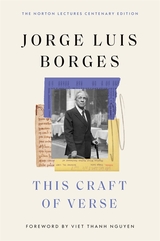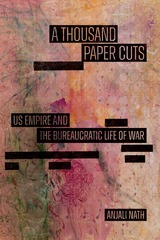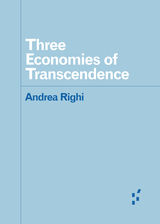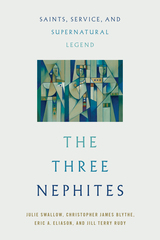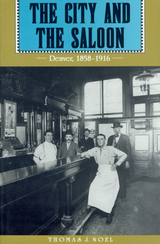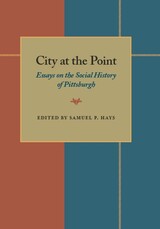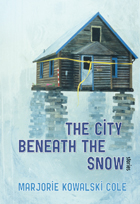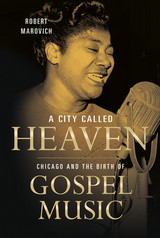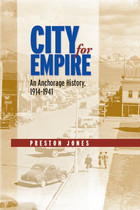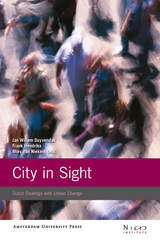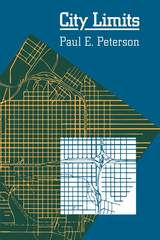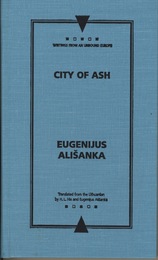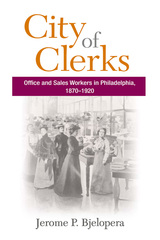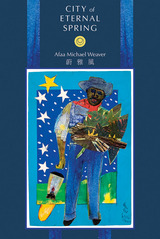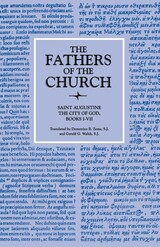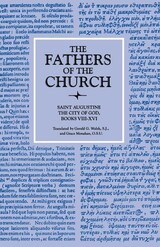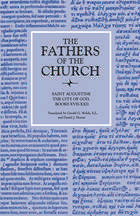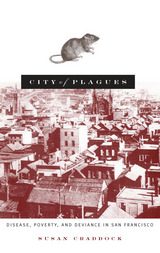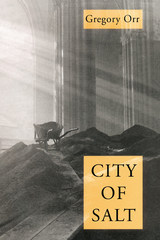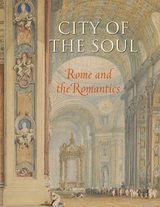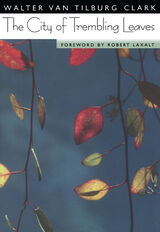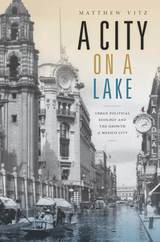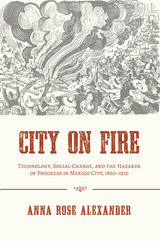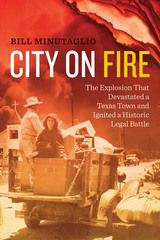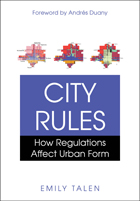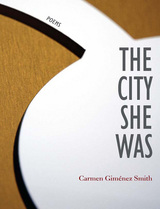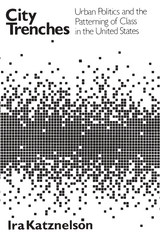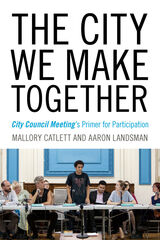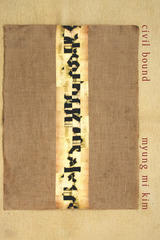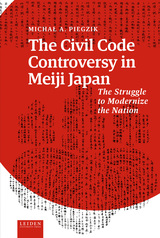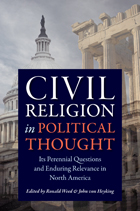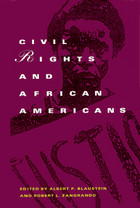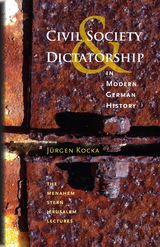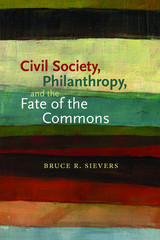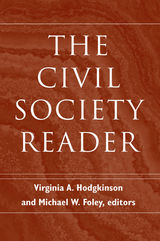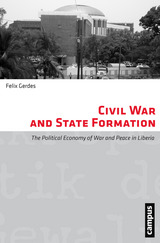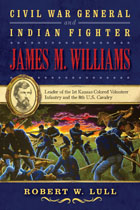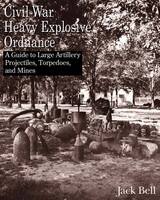The City and the Saloon: Denver, 1858-1916
Thomas J. Noel
University Press of Colorado, 1996 During Denver's wild ride from frontier mining town to twentieth-century metropolis, the city's saloons, like those of many other western frontier towns, played a vital role in the development of the city. Now with a new preface, Tom Noel's classic study, The City and the Saloon, is a liquid history of how Denver's bars both shaped and reflected the Mile High City's birth and adolescence.
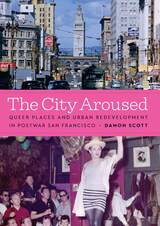 The City Aroused: Queer Places and Urban Redevelopment in Postwar San Francisco
Damon Scott
University of Texas Press, 2023 A history of San Francisco that studies change in the postwar urban landscape in relation to the city's queer culture.
The City Aroused is a lively history of urban development and its influence on queer political identity in postwar San Francisco. By reconstructing the planning and queer history of waterfront drinking establishments, Damon Scott shows that urban renewal was a catalyst for community organizing among racially diverse operators and patrons with far-reaching implications for the national gay rights movement. Following the exclusion of suspected homosexuals from the maritime trades in West Coast ports in the early 1950s, seamen’s hangouts in the city came to resemble gay bars. Local officials responded by containing the influx of gay men to a strip of bars on the central waterfront while also making plans to raze and rebuild the area. This practice ended when city redevelopment officials began acquiring land in the early 1960s. Aided by law enforcement, they put these queer social clubs out of business, replacing them with heteronormative, desexualized land uses that served larger postwar urban development goals. Scott argues that this shift from queer containment to displacement aroused a collective response among gay and transgender drinking publics who united in solidarity to secure a place in the rapidly changing urban landscape.
 The City as Campus: Urbanism and Higher Education in Chicago
Sharon Haar
University of Minnesota Press, 2010 We are witnessing an explosion of universities and campuses nationwide, and urban schools play an important role in shaping the cities outside their walls. In The City as Campus, Sharon Haar uses Chicago as a case study to examine how universities interact with their urban contexts, demonstrating how higher education became integrated with ideas of urban growth as schools evolved alongside the city.
The City as Campus shows the strain of this integration, detailing historical accounts of battles over space as campus designers faced the challenge of weaving the social, spatial, and architectural conditions of the urban milieu into new forms to meet the changing needs of academia. Through a close analysis of the history of higher education in Chicago, The City as Campus explores how the university's missions of service, teaching, and research have metamorphosed over time, particularly in response to the unique opportunities-and restraints-the city provides. Illustrating how Chicago serves as a site of pedagogical transformation and a location for the larger purpose of the academic community, The City as Campus presents a social and design history of the urban campus as an architectural idea and form.
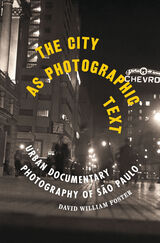 The City as Photographic Text: Urban Documentary Photography of São Paulo
David William Foster
University of Pittsburgh Press, 2020 The City as Photographic Text offers the first comprehensive presentation of photography on São Paulo. But more than just a study of one city’s photographic legacy, this book is a manual for how to understand and talk about Latin American photography in general. Focusing on major figures and referencing widely available books of their work, David William Foster offers a unique analysis of how photographers have contributed to our understanding of the megalopolis São Paulo has become. Eschewing a conventional historical approach, Foster explores how best to interpret visual urban life. In turn, by focusing interest on the photographic text and the ways in which it creates an interpretive meaning for the city, rather than rehearsing the circumstances under which the photographs were taken, this study provides a model for productive comment on urban photography as a project of visual meaning with important artistic attributes. As a unique entry in the inventory of scholarly writing on São Paulo, The City as Photographic Text adds to our understanding of the enormous cultural significance this city holds as a world-class urban center.
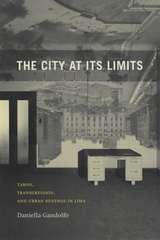 The City at Its Limits: Taboo, Transgression, and Urban Renewal in Lima
Daniella Gandolfo
University of Chicago Press, 2009 In 1996, against the backdrop of Alberto Fujimori’s increasingly corrupt national politics, an older woman in Lima, Peru—part of a group of women street sweepers protesting the privatization of the city’s cleaning services—stripped to the waist in full view of the crowd that surrounded her. Lima had just launched a campaign to revitalize its historic districts, and this shockingly transgressive act was just one of a series of events that challenged the norms of order, cleanliness, and beauty that the renewal effort promoted. The City at Its Limits employs a novel and fluid interweaving of essays and field diary entries as Daniella Gandolfo analyzes the ramifications of this act within the city’s conflicted history and across its class divisions. She builds on the work of Georges Bataille to explore the relation between taboo and transgression, while Peruvian novelist and anthropologist José María Arguedas’s writings inspire her to reflect on her return to her native city in movingly intimate detail. With its multiple perspectives—personal, sociological, historical, and theoretical—The City at Its Limits is a pioneering work on the cutting edge of ethnography.
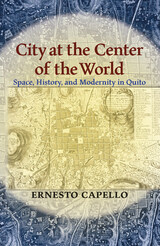 City at the Center of the World: Space, History, and Modernity in Quito
Ernesto Capello
University of Pittsburgh Press, 2011
In the seventeenth century, local Jesuits and Franciscans imagined Quito as the “new Rome.” It was the site of miracles and home of saintly inhabitants, the origin of crusades into the surrounding wilderness, and the purveyor of civilization to the entire region. By the early twentieth century, elites envisioned the city as the heart of a modern, advanced society—poised at the physical and metaphysical centers of the world.
In this original cultural history, Ernesto Capello analyzes the formation of memory, myth, and modernity through the eyes of Quito’s diverse populations. By employing Mikhail Bakhtin’s concept of chronotopes, Capello views the configuration of time and space in narratives that defined Quito’s identity and its place in the world. He explores the proliferation of these imaginings in architecture, museums, monuments, tourism, art, urban planning, literature, religion, indigenous rights, and politics. To Capello, these tropes began to crystallize at the end of the nineteenth century, serving as a tool for distinct groups who laid claim to history for economic or political gain during the upheavals of modernism.
As Capello reveals, Quito’s society and its stories mutually constituted each other. In the process of both destroying and renewing elements of the past, each chronotope fed and perpetuated itself. Modern Quito thus emerged at the crux of Hispanism and Liberalism, as an independent global society struggling to keep the memory of its colonial and indigenous roots alive.
City At The Point: Essays on the Social History of Pittsburgh
Samuel P. Hays
University of Pittsburgh Press, 1991
An overview of scholarly research, both published and previously unpublished, on the history of a city that has often served as a case study for measuring social change. It synthesizes the literature and assesses how that knowledge relates to our broader understanding of the processes of urbanization and urbanism.
This book is especially useful for undergraduate and graduate courses on environmental politics and policy making, or as a supplement for courses on public policy making generally.
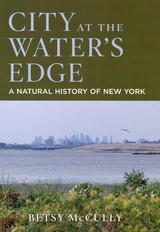 City at the Water's Edge: A Natural History of New York
McCully, Betsy
Rutgers University Press, 2007 Concrete floors and concrete walls, buildings that pierce the sky, taxicabs and subway corridors, a steady din of noise. These things, along with a virtually unrivaled collection of museums, galleries, performance venues, media outlets, international corporations, and stock exchanges make New York City not only the cultural and financial capital of the United States, but one of the largest and most impressive urban conglomerations in the world. With distinctions like these, is it possible to imagine the city as any more than this?
City at the Water's Edge invites readers to do just that. Betsy McCully, a long-time urban dweller, argues that this city of lights is much more than a human-made metropolis. It has a rich natural history that is every bit as fascinating as the glitzy veneer that has been built atop it. Through twenty years of nature exploration, McCully has come to know New York as part of the Lower Hudson Bioregion-a place of salt marshes and estuaries, sand dunes and barrier islands, glacially sculpted ridges and kettle holes, rivers and streams, woodlands and outwash plains. Here she tells the story of New York that began before the first humans settled in the region twelve thousand years ago, and long before immigrants ever arrived at Ellis Island. The timeline that she recounts is one that extends backward half a billion years; it plumbs the depths of Manhattan's geological history and forecasts a possible future of global warming, with rising seas lapping at the base of the Empire State Building.
Counter to popular views that see the city as a marvel of human ingenuity diametrically opposed to nature, this unique account shows how the region has served as an evolving habitat for a diversity of species, including our own. The author chronicles the growth of the city at the expense of the environment, but leaves the reader with a vision of a future city as a human habitat that is brought into balance with nature.
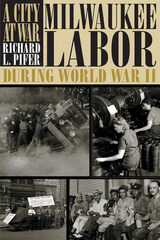 A City At War: Milwaukee Labor During World War II
Richard L. Pifer
Wisconsin Historical Society Press, 2003 Milwaukeeans greeted the advent of World War II with the same determination as other Americans. Everyone felt the effect of the war, whether through concern for loved ones in danger, longer work hours, consumer shortages, or participation in war service organizations and drives. Men and women workers produced the essential goods necessary for victory—the vehicles, weapons, munitions, and components for all the machinery of war. But even in wartime there were labor conflicts, fueled by the sacrifices and tensions of wartime life. A City at War focuses on the experience of working men and women in a community that was not a wartime boom town. It looks at the stands of the CIO and the AFL against low wartime wages, and at women in unionized factories facing the perceptions and goals of male workers, union leaders, and society itself. Here is a social history of wartime Milwaukee and its workers as they laid the groundwork for a secure postwar future.
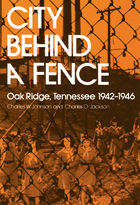 City Behind a Fence: Oak Ridge, Tennessee, 1942–1946
Charles W. Johnson
University of Tennessee Press, 1981 During World War II, the United States government, working through the Army Corp of Engineer, undertook an unprecedented experiment—the development of the world's first nuclear weapon. Although the fiery conclusion of the Manhattan Project is well known, the prelude to the story—the saga of the people sequestered in the project's three crucial support communities—has remained obscure. Built from the ground up, these "secret cities"are phenomena of special import for American social history. In City Behind a Fence, Charles W. Johnson and Charles O. Jackson chronicle the nature of daily life in Oak Ridge, a facility built in the remote back country of East Tennessee to aid in the construction of the first atomic bomb.
Surrounded by a fence patrolled by armed guards, the inhabitants of Oak Ridge—most of whom were unaware of the nature of the activity at the facility—spent much of the war period physically cut off from the outside world. The authors analyze the people who lived and worked in this unique setting. They use previously classified material and extensive oral interviews to portray the stresses and patterns of life in the city, focusing on problems of housing, racial segregation, education, recreation, interaction with surrounding communities, the extreme security measures, and the eventual "normalization" of the community. The history of war-time Oak Ridge graphically reveal the impact of the single-minded, massive endeavor on the lives of those who struggled, mostly unknowingly, to launch the nation and the world into the Atomic Age.
The City Beneath the Snow: Stories
Marjorie Kowalski Cole
University of Alaska Press, 2012 The final collection of stories by award-winning writer Marjorie Kowalski Cole, The City Beneath the Snow is a portrait of contemporary Alaskans and a look at the moral decisions that lurk in the unexpected corners of daily life.
"Marjorie Kowalski Cole's characters live, work, and struggle in interior Alaska, and she depicts life here with a keen eye and with compassion. We see the daughter of a Fairbanks junkyard owner struggling with her isolation. We meet a bartender at Circle Hot Springs who's also a certified nurse's assistant at Fairbanks Memorial Hospital. . . . These are inner lives, revealed with care and with skill, the true material of good literature."—Peggy Shumaker, Alaska State Writer Laureate
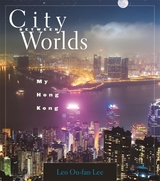 City Between Worlds: My Hong Kong
Leo Ou-fan Lee
Harvard University Press, 2010 Hong Kong is perched on the fault line between China and the West, a Special Administrative Region of the PRC. Leo Ou-fan Lee offers an insider’s view of Hong Kong, capturing the history and culture that make his densely packed home city so different from its generic neighbors.
The search for an indigenous Hong Kong takes Lee to the wet markets and corner bookshops of congested Mong Kok, remote fishing villages and mountainside temples, teahouses and noodle stalls, Cantonese opera and Cantopop. But he also finds the “real” Hong Kong in a maze of interconnected shopping malls, a jungle of high-rise residential towers, and the neon glow of Chinese-owned skyscrapers in the Central Business District, where land development, global trade, capital accumulation, consumerism, and free-market competition trump every value—except family.
Lee illuminates the relationship between Hong Kong’s geography and its colonial experience, revisiting colonial life on the secluded Peak, in the opium-filled godowns along the harborfront, and in crowded, plague-infested tenements. He examines, with a critic’s eye, the “Hong Kong story” in film and fiction: romance in the bars and brothels of Wan Chai, crime in the walled city of Kowloon, ennui on the eve of the 1997 handover.
Whether viewed from Tsing Yi Bridge or the deck of the Star Ferry, from Victoria Peak or Lion Rock, Hong Kong sparkles here in all its multifaceted complexity, a city forever between worlds.
A City Called Heaven: Chicago and the Birth of Gospel Music
Robert Marovich
University of Illinois Press, 2015 In A City Called Heaven, Robert M. Marovich follows gospel music from early hymns and camp meetings through its growth into the sanctified soundtrack of the city's mainline black Protestant churches. Marovich mines print media, ephemera, and hours of interviews with artists, ministers, and historians--as well as relatives and friends of gospel pioneers--to recover forgotten singers, musicians, songwriters, and industry leaders. He also examines the entrepreneurial spirit that fueled gospel music's rise to popularity and granted social mobility to a number of its practitioners. As Marovich shows, the music expressed a yearning for freedom from earthly pains, racial prejudice, and life's hardships. Yet it also helped give voice to a people--and lift a nation. A City Called Heaven celebrates a sound too mighty and too joyous for even church walls to hold.
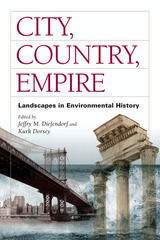 City, Country, Empire: Landscapes in Environmental History
Jeffry M Diefendorf
University of Pittsburgh Press, 2005
In the urgently expanding field of environmental history, two trends are emerging. Research has internationalized, crossing political and historical borders. And urban spaces are increasingly seen as part of, not apart from, the global environment. In this book, Jeffry Diefendorf and Kurk Dorsey have gathered much of the important work pushing the field in new directions. Eleven essays by prominent and regionally diverse scholars address how human and natural forces collaborate in the creation of cities, the countryside, and empires.
The Cities section features essays that examine pollution and its aftermath in Pittsburgh, the Ruhr Valley (Germany), and Los Angeles. These urban areas are far apart on the globe but closely linked in their histories of how human decision making has affected the environment.
Changing rural and suburban spaces are the focus of Countryside. Elizabeth Blackmar "follows the money" in order to understand why the financing of suburban mall developments makes local resistance difficult. Studies of the fractious history of the creation of a wildlife refuge in Oregon and the ongoing impact of hydraulic mining in the early California goldmining era emphasize the misuse of technology in rural spaces.
Such misuse is a central idea of Empires. In "When Stalin Learned to Fish," Paul R. Josephson tells the story of Soviet fishing technology designed to "harness fish to the engine of socialism." Other essays explore the failures of Western agricultural technology in Africa and the relationship between such technology and disease in European attempts to conquer the Caribbean. In a stirring, wide-ranging consideration of the neo-European colonies (the United States, Australia, Canada, and New Zealand), Thomas R. Dunlap observes the ongoing, unsettled interaction of lands and dreams. An afterword by Alfred W. Crosby, an eminent scholar of environmental history, closes the book with a broad and insightful synthesis of the history and future of this critical field.
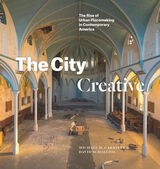 The City Creative: The Rise of Urban Placemaking in Contemporary America
Michael H. Carriere and David Schalliol
University of Chicago Press, 2021 In the wake of the Great Recession, American cities from Philadelphia to San Diego saw an upsurge in hyperlocal placemaking—small-scale interventions aimed at encouraging greater equity and community engagement in growth and renewal. But the projects that were the most successful at achieving these lofty ambitions weren’t usually established by politicians, urban planners, or real estate developers; they were initiated by community activists, artists, and neighbors. In order to figure out why, The City Creative mounts a comprehensive study of placemaking in urban America, tracing its intellectual history and contrasting it with the efforts of people making positive change in their communities today.
Spanning the 1950s to the post-recession 2010s, The City Creative highlights the roles of such prominent individuals and organizations as Jane Jacobs, Christopher Alexander, Richard Sennett, Project for Public Spaces, and the National Endowment for the Arts in the development of urban placemaking, both in the abstract and on the ground. But that’s only half the story. Bringing the narrative to the present, Michael H. Carriere and David Schalliol also detail placemaking interventions at more than 200 sites in more than 40 cities, combining archival research, interviews, participant observation, and Schalliol’s powerful documentary photography. Carriere and Schalliol find that while these formal and informal placemaking interventions can bridge local community development and regional economic plans, more often than not, they push the boundaries of mainstream placemaking. Rather than simply stressing sociability or market-driven economic development, these initiatives offer an alternative model of community-led progress with the potential to redistribute valuable resources while producing tangible and intangible benefits for their communities. The City Creative provides a kaleidoscopic overview of how these initiatives grow, and sometimes collapse, illustrating the centrality of placemaking in the evolution of the American city and how it can be reoriented to meet demands for a more equitable future.
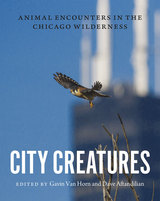 City Creatures: Animal Encounters in the Chicago Wilderness
Edited by Gavin Van Horn and Dave Aftandilian
University of Chicago Press, 2015 Read about Ten Years of City Creatures at the Center for Humans and Nature We usually think of cities as the domain of humans—but we are just one of thousands of species that call the urban landscape home. Chicago residents knowingly move among familiar creatures like squirrels, pigeons, and dogs, but might be surprised to learn about all the leafhoppers and water bears, black-crowned night herons and bison, beavers and massasauga rattlesnakes that are living alongside them. City Creatures introduces readers to an astonishing diversity of urban wildlife with a unique and accessible mix of essays, poetry, paintings, and photographs.
The contributors bring a story-based approach to this urban safari, taking readers on birding expeditions to the Magic Hedge at Montrose Harbor on the North Side, canoe trips down the South Fork of the Chicago River (better known as Bubbly Creek), and insect-collecting forays or restoration work days in the suburban forest preserves.
The book is organized into six sections, each highlighting one type of place in which people might encounter animals in the city and suburbs. For example, schoolyard chickens and warrior wasps populate “Backyard Diversity,” live giraffes loom at the zoo and taxidermy-in-progress pheasants fascinate museum-goers in “Animals on Display,” and a chorus of deep-freeze frogs awaits in “Water Worlds.” Although the book is rooted in Chicago’s landscape, nature lovers from cities around the globe will find a wealth of urban animal encounters that will open their senses to a new world that has been there all along. Its powerful combination of insightful narratives, numinous poetry, and full-color art throughout will help readers see the city—and the creatures who share it with us—in an entirely new light.
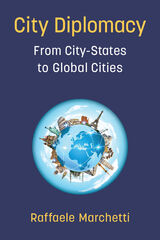 City Diplomacy: From City-States to Global Cities
Raffaele Marchetti
University of Michigan Press, 2021 While the view that only states act as global actors is conventional, significant diplomatic and cross-cultural activity is taking place in cities today. Economic growth and fiscal experiments all occur in urban contexts. Political reforms, social innovation, and protests and revolutions generate in cities. Criminal activities, terrorist actions, counterinsurgency, missile attacks (indeed, atomic bombs), and wars are centered in big cities. They are sources of global pollution as well as of environmental transformations such as urban gardening. Knowledge production, big data collection, and tech innovation all spur from intense interaction in cities. They are the meeting points between different cultures, religions, and identities. These increasingly international cities develop twinning networks and projects, share information, sign cooperation agreements, contribute to the drafting of national and international policies, provide development aid, promote assistance to refugees, and do territorial marketing through decentralized city-city or district-district cooperation. Cities do what “municipalities” used to do many centuries ago: they cooperate but also enter into intense competitive dynamics. To understand current sociopolitical dynamics on a planetary level, we need to have two mental maps in mind: the state-centered map and the nonstate centered map. We must take into account the existence of a complex diplomatic regime based on different overlapping levels—the urban and the state.
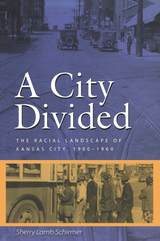 A City Divided: The Racial Landscape of Kansas City, 1900-1960
Sherry Lamb Schirmer
University of Missouri Press, 2002 A City Divided traces the development of white Kansas Citians’ perceptions of race and examines the ways in which those perceptions shaped both the physical landscape of the city and the manner in which Kansas City was policed and governed. Because of rapid changes in land use and difficulties in suppressing crime and vice in Kansas City, the control of urban spaces became an acute concern, particularly for the white middle class, before race became a problematic issue in Kansas City. As the African American population grew in size and assertiveness, whites increasingly identified blacks with those factors that most deprived a given space of its middle-class character. Consequently, African Americans came to represent the antithesis of middle-class values, and the white middle class established its identity by excluding blacks from the urban spaces it occupied. By 1930, racial discrimination rested firmly on gender and family values as well as class. Inequitable law enforcement in the ghetto increased criminal activity, both real and perceived, within the African American community. White Kansas Citians maintained this system of racial exclusion and denigration in part by “misdirection,” either by denying that exclusion existed or by claiming that segregation was necessary to prevent racial violence. Consequently, African American organizations sought to counter misdirection tactics. The most effective of these efforts followed World War II, when local black activists devised demonstration strategies that targeted misdirection specifically. At the same time, a new perception emerged among white liberals about the role of race in shaping society. Whites in the local civil rights movement acted upon the belief that integration would produce a better society by transforming human character. Successful in laying the foundation for desegregating public accommodations in Kansas City, black and white activists nonetheless failed to dismantle the systems of spatial exclusion and inequitable law enforcement or to eradicate the racial ideologies that underlay those systems.
These racial perceptions continue to shape race relations in Kansas City and elsewhere. This study demystifies these perceptions by exploring their historical context. While there have been many studies of the emergence of ghettos in northern and border cities, and others of race, gender, segregation, and the origins of white ideologies, A City Divided is the first to address these topics in the context of a dynamic, urban society in the Midwest.
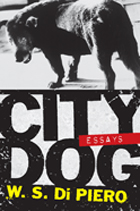 City Dog: Essays
W.S. Di Piero
Northwestern University Press, 2009 The Julius Rosenwald Fund has been largely ignored in the literature of both art history and African American studies, despite its unique focus, intensity, and commitment. Spertus Museum in Chicago has organized an exhibition, guest curated by Daniel Schulman, that presents and explores the work of funded artists as well as the history of the Fund. Through it, and this accompanying collection of essays, illustrations, and color plates, we see the Fund’s groundbreaking initiative to address issues relating to the unequal treatment of blacks in American life. The book constitutes a veritable Who’s Who of African American artists and intellectuals of the first half of the twentieth century, as well as a roll call of modern contributors who represent the leading scholars in their fields, including Peter M. Ascoli, grandson and biographer of Julius Rosenwald, and Kinshasha Holman Conwill, deputy director of the National Museum of African American Art and Culture. With far-reaching influence even today, the Julius Rosenwald Fund stands alongside the Rockefeller and Carnegie funds as a major force in American cultural history.
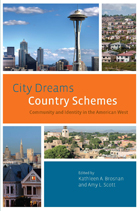 City Dreams, Country Schemes: Community and Identity in the American West
Kathleen A. Brosnan
University of Nevada Press, 2011 The American West, from the beginning of Euro-American settlement, has been shaped by diverse ideas about how to utilize physical space and natural environments to create cohesive, sometimes exclusive community identities. When westerners developed their towns, they constructed spaces and cultural identities that reflected alternative understandings of modern urbanity. The essays in City Dreams, Country Schemes utilize an interdisciplinary approach to explore the ways that westerners conceptualized, built, and inhabited urban, suburban, and exurban spaces in the twentieth century. The contributors examine such topics as the attractions of open space and rural gentrification in shaping urban development; the role of tourism in developing national parks, historical sites, and California's Napa Valley; and the roles of public art, gender, and ethnicity in shaping urban centers. City Dreams, Country Schemes reveals the values and expectations that have shaped the West and the lives of the people who inhabit it.
 City Economics
Brendan O'Flaherty
Harvard University Press, 2005 This introductory but innovative textbook on the economics of cities is aimed at students of urban and regional policy as well as of undergraduate economics. It deals with standard topics, including automobiles, mass transit, pollution, housing, and education but it also discusses non-standard topics such as segregation, water supply, sewers, garbage, fire prevention, housing codes, homelessness, crime, illicit drugs, and economic development.
Its methods of analysis are primarily verbal, geometric, and arithmetic. The author achieves coherence by showing how the analysis of various topics reinforces one another. Thus, buses can tell us something about schools and optimal tolls about land prices. Brendan O'Flaherty looks at almost everything through the lens of Pareto optimality and potential Pareto optimality--how policies affect people and their well-being, not abstract entities such as cities or the economy or growth or the environment. Such traditionalism leads to radical questions, however: Should cities have police and fire departments? Should tax preferences for home ownership be repealed? Should public schools charge for their services? O'Flaherty also gives serious consideration to such heterodox policies as pay-at-the-pump auto insurance, curb rights for buses, land taxes, marginal cost water pricing, and sidewalk zoning.
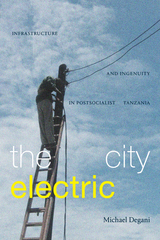 The City Electric: Infrastructure and Ingenuity in Postsocialist Tanzania
Michael Degani
Duke University Press, 2022 Over the last twenty years of neoliberal reform, the power supply in Dar es Salaam, Tanzania’s metropolis, has become less reliable even as its importance has increased. Though mobile phones, televisions, and refrigerators have flooded the city, the electricity required to run these devices is still supplied by the socialist-era energy company Tanesco, which is characterized by increased fees, aging infrastructure, and a sluggish bureaucracy. While some residents contemplate off-grid solutions, others repair, extend, or tap into the state network with the assistance of freelance electricians or moonlighting utility employees. In The City Electric Michael Degani explores how electricity and its piracy has become a key site for urban Tanzanians to enact, experience, and debate their social contract with the state. Moving from the politics of generation contracts down to the street-level experience of blackouts and disconnection patrols, he reveals the logics of infrastructural modification and their effects on everyday life. As politicians, residents, electricians, and utility inspectors all redistribute flows of payment and power, they reframe the energy grid both as a technical system and as an ongoing experiment in collective interdependence.
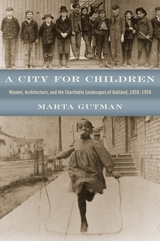 A City for Children: Women, Architecture, and the Charitable Landscapes of Oakland, 1850-1950
Marta Gutman
University of Chicago Press, 2014 American cities are constantly being built and rebuilt, resulting in ever-changing skylines and neighborhoods. While the dynamic urban landscapes of New York, Boston, and Chicago have been widely studied, there is much to be gleaned from west coast cities, especially in California, where the migration boom at the end of the nineteenth century permanently changed the urban fabric of these newly diverse, plural metropolises.
In A City for Children, Marta Gutman focuses on the use and adaptive reuse of everyday buildings in Oakland, California, to make the city a better place for children. She introduces us to the women who were determined to mitigate the burdens placed on working-class families by an indifferent industrial capitalist economy. Often without the financial means to build from scratch, women did not tend to conceive of urban land as a blank slate to be wiped clean for development. Instead, Gutman shows how, over and over, women turned private houses in Oakland into orphanages, kindergartens, settlement houses, and day care centers, and in the process built the charitable landscape—a network of places that was critical for the betterment of children, families, and public life. The industrial landscape of Oakland, riddled with the effects of social inequalities and racial prejudices, is not a neutral backdrop in Gutman’s story but an active player. Spanning one hundred years of history, A City for Children provides a compelling model for building urban institutions and demonstrates that children, women, charity, and incremental construction, renovations, alterations, additions, and repurposed structures are central to the understanding of modern cities.
City for Empire: An Anchorage History, 1914-1941
Preston Jones
University of Alaska Press, 2010 First settled in 1915, Anchorage, Alaska, was founded with the American empire in mind. During World War I, it served as a conduit through which coal could be shipped to the Pacific, where the US Navy was engaged with Japan. Decades later, during World War II, Anchorage became an equally important site for the defense of the mainland and the projection of American power. City for Empire tells the story of Anchorage's development in that period, focusing in particular on the international context of the city's early decades and its surprisingly diverse inhabitants. A thorough yet accessible read, City for Empire captures the history of this remarkable city.
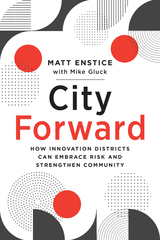 City Forward: How Innovation Districts Can Embrace Risk and Strengthen Community
Matt Enstice with Mike Gluck
Island Press, 2022 Innovation districts and anchor institutions—like hospitals, universities, and technology hubs—are celebrated for their ability to drive economic growth and employment opportunities. But the benefits often fail to reach the very neighborhoods they are built in. As CEO of the Buffalo Niagara Medical Campus, Matt Enstice took a different approach. Under Matt’s leadership, BNMC has supported entrepreneurship training programs and mentorship for community members, creation of a community garden, bringing together diverse groups to explore transportation solutions, and more. Fostering participation and collaboration among neighborhood leaders, foundations, and other organizations ensures that the interests of Buffalo residents are represented. Together, these groups are creating a new model for re-energizing Buffalo—a model that has applications across the United States and around the world.
City Forward explains how BNMC works to promote a shared goal of equity among companies and institutions with often opposing motivations and intentions. When money or time is scarce, how can equitable community building remain a common priority? When interests conflict, and an institution’s expansion depends upon parking or development that would infringe upon public space, how can the decision-making process maintain trust and collaboration? Offering a candid look at BNMC’s setbacks and successes, along with efforts from other institutions nationwide, Enstice shares twelve strategies that innovation districts can harness to weave equity into their core work. From actively creating opportunities to listen to the community, to navigating compromise, to recruiting new partners, the book reveals unique opportunities available to create decisive, large-scale change. Critically, Enstice also offers insight about how innovation districts can speak about equity in an inclusive manner and keep underrepresented and historically excluded voices at the decision-making table.
Accessible, engaging, and packed with fresh ideas applicable to any city, this book is an invaluable resource. Institutional leadership, business owners, and professionals hoping to make equitable change within their companies and organizations will find experienced direction here. City Forward is a refreshing look at the brighter, more equitable futures that we can create through thoughtful and strategic collaboration—moving forward, together.
City Games: The Evolution of American Urban Society and the Rise of Sports
Steven A. Riess
University of Illinois Press, 1989 Comprehensive and thoughtful, City Games looks at the complex interrelationship and interdependency between sport and the city. Steven A. Riess shows how demographic growth, evolving special arrangements, social reform, the formulation of class and ethnic subcultures, the expansion of urban government, and the rise of political machines and crime syndicates all interacted to influence the development of sports in the United States.
 City Hospitals: The Undercare of the Underprivileged
Harry F. Dowling
Harvard University Press, 1982 Maligned by the public and manipulated by politicians, today's city hospitals often cannot keep pace with the rising costs of medical technology. But while the urban landscape decays around them and city officials debate their continued existence, these institutions provide primary care for many of the nation's poor, and technically advanced care for some. They also serve as training grounds for many health professionals. How city hospitals have progressed so far, only to face such an uncertain future, is the subject of this clearly written and meticulously researched history.
Drawing on his personal experience as a physician and administrator, Harry F. Dowling shows that many problems facing city hospitals in the 1980s can be traced to their bleak beginnings as adjuncts to the poorhouse. Occasionally they provided satisfactory custodial care for the indigent sick, along with medical treatment comparable to the best private hospitals; more often their wards were scantily staffed with incompetent, careless attendants and characterized by filth, overcrowding, and epidemics that turned hospitals into death houses. Dr. Dowling describes how the gradual affiliation of city hospitals with medical schools, as well as the professionalization of nursing and administration, brought about the transition from almshouse to modern medical center. But by the 1960s deteriorating buildings and dwindling budgets again raised questions about the city hospital's role in today's medical establishment.
This book discusses a number of issues that will have a direct bearing on the future viability of these hospitals. Of particular significance will be their willingness to respond creatively to the needs of the surrounding community through emphasis on preventive medicine, family services, and care of the chronically ill.
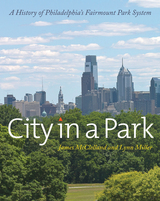 City in a Park: A History of Philadelphia's Fairmount Park System
Lynn Miller
Temple University Press, 2015 Fairmount Park is the municipal park system of Philadelphia, Pennsylvania. It consists of more than one hundred parks, squares, and green spaces totaling about 11,000 acres, and is one of the largest landscaped urban park systems in the world. In City in a Park, James McClelland and Lynn Miller provide an affectionate and comprehensive history of this 200-year-old network of parks. Originated in the nineteenth century as a civic effort to provide a clean water supply to Philadelphia, Fairmount Park also furnished public pleasure grounds for boat races and hiking, among other activities. Millions travel to the city to view its eighteenth-century villas, attend boat races on the Schuylkill River, hike the Wissahickon Creek, visit the Philadelphia Zoo, hear concerts in summer, stroll the city’s historic squares and the Benjamin Franklin Parkway, and enjoy its enormous collection of public art. Green initiatives flower today; Philadelphia lives amidst its parks. Filled with nearly 150 gorgeous full-color photographs, City in a Park chronicles the continuing efforts to create what founder William Penn desired: a “greene countrie town.”
City in Sight: Dutch Dealings with Urban Change
Edited by Jan Willem Duyvendak, Frank Hendriks, and Mies van Niekerk
Amsterdam University Press, 2009
City in Sight presents recent scholarship on the various issues facing today’s Dutch metropolitan areas, including immigration and the growing diversity among the urban population, urban restructuring and neighborhood renewal, shifts in urban governance, and the promotion of active citizenship. With its wealth of information and up-to-date research, this text will appeal to scholars of urban politics and social history from all over the globe.
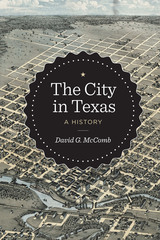 The City in Texas: A History
By David McComb
University of Texas Press, 2015 Texans love the idea of wide-open spaces and, before World War II, the majority of the state’s people did live and work on the land. Between 1940 and 1950, however, the balance shifted from rural to urban, and today 88 percent of Texans live in cities and embrace the amenities of urban culture. The rise of Texas cities is a fascinating story that has not been previously told. Yet it is essential for understanding both the state’s history and its contemporary character. In The City in Texas, acclaimed historian David G. McComb chronicles the evolution of urban Texas from the Spanish Conquest to the present. Writing in lively, sometimes humorous and provocative prose, he describes how commerce and politics were the early engines of city growth, followed by post–Civil War cattle shipping, oil discovery, lumbering, and military needs. McComb emphasizes that the most transformative agent in city development was the railroad. This technology—accompanied by telegraphs that accelerated the spread of information and mechanical clocks that altered concepts of time—revolutionized transportation, enforced corporate organization, dictated town location, organized space and architecture, and influenced thought. McComb also thoroughly explores the post–World War II growth of San Antonio, Dallas, Fort Worth, Austin, and Houston as incubators for businesses, educational and cultural institutions, and health care centers.
 The City in the Ancient World
Mason Hammond
Harvard University Press The emergence of cities in the different regions of the ancient world presents two problems. First, in areas of common culture or at least of cultural contact, did the cities evolve independently, as phenomena of social, political, and economic growth, or did they emanate from a common center of origin? Second, how did the Greco–Roman city–state originate?
In considering these questions, Mason Hammond has limited the ancient world to the Middle and Near East, the Indus Valley, and the Mediterranean region. He takes geographical and economic factors into account as he treats the cities historically by areas, from their first development in Sumeraround 3200 B.C, to the end of the ancient world in the middle of the sixth century A.D.
Mr. Hammond concludes that the city’s evolution was a phenomenon of local social development but was also influenced by older cultures. The city–state, he shows, was a creation of the Greek genius. It was diffused throughout the Greco–Ronan world, and withered with the decline of ancient culture in the early Middle Ages.
The author provides brief geographical descriptions of the areas he covers. Thirteen maps give the locations of places referred to in the text. Where ancient and modern names differ markedly, both are given, in the text and in an index of the places shown on the maps. An extensive chronological survey and a general index document the text.
City in the Desert
Oleg Grabar, Reneta Holod, James Knustad, and William Trousdale
Harvard University Press City in the Desert describes the results of the excavation of an extraordinary early Islamic site carried out by the Kelsey Museum, University of Michigan, and Harvard University. The ruins of Qasr al-Hayr are located almost exactly in the center of Syria, between the Euphrates and the ancient city of Palmyra. Founded around 825 A.D. by the dynasty of the Umayyads, the settlement continued to flourish until the twelfth century. At once palatial and nomadic, rural and urban in character, Qasr al-Hayr mirrored many social and cultural aspects of the medieval Islamic world. How such contrasting features were contained in a single entity for over four hundred years is a puzzle that the authors seek to solve. They also examine how, in a semi-arid region, contentious tribes were able to forge and preserve a common culture.
The City is Me
Rosane Araujo
Intellect Books, 2013 Proposing a new way of understanding the relationship between the city and personal identity, The City is Me argues that there is no longer a distance between the two. The result of extensive research about our notions of the city and the person throughout time, this volume explores the technology, research findings, and new ideas that have made it impossible to sustain conceptions of the city that are based on the criterion of a boundary. Showing how this shift mirrors the decentralization and fragmentation of personal identity in a globalized world, Rosane Araujo confronts the challenge of rethinking urbanism in a way that corresponds to the risk and uncertainty—but also to the possibilities—of today’s cities.
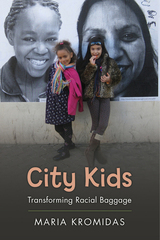 City Kids: Transforming Racial Baggage
Kromidas, Maria
Rutgers University Press, 2016 Cosmopolitanism—the genuine appreciation of cultural and racial diversity—is often associated with adult worldliness and sophistication. Yet, as this innovative new book suggests, children growing up in multicultural environments might be the most cosmopolitan group of all. City Kids profiles fifth-graders in one of New York City’s most diverse public schools, detailing how they collectively developed a sophisticated understanding of race that challenged many of the stereotypes, myths, and commonplaces they had learned from mainstream American culture. Anthropologist Maria Kromidas spent over a year interviewing and observing these young people both inside and outside the classroom, and she vividly relates their sometimes awkward, often playful attempts to bridge cultural rifts and reimagine racial categories. Kromidas looks at how children learned race in their interactions with each other and with teachers in five different areas—navigating urban space, building friendships, carrying out schoolwork, dealing with the school’s disciplinary policies, and enacting sexualities. The children’s interactions in these areas contested and reframed race. Even as Kromidas highlights the lively and quirky individuals within this super-diverse group of kids, she presents their communal ethos as a model for convivial living in multiracial settings. By analyzing practices within the classroom, school, and larger community, City Kids offers advice on how to nurture kids’ cosmopolitan tendencies, making it a valuable resource for educators, parents, and anyone else who is concerned with America’s deep racial divides. Kromidas not only examines how we can teach children about antiracism, but also considers what they might have to teach us.
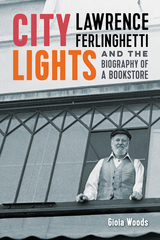 City Lights: Lawrence Ferlinghetti and the Biography of a Bookstore
Gioia Woods
University of Nevada Press, 2026 On a San Francisco street corner in 1953, aspiring painter and poet Lawrence Ferlinghetti shook hands with sociology instructor and magazine editor Peter Martin. Their handshake sealed Ferlinghetti’s five-hundred-dollar investment in a small retail space above a North Beach flower shop that would become City Lights Bookstore and Press. Since the mid-twentieth century, the bookstore and its press have continued to shape the way literature is produced and consumed. As the first-ever all-paperback bookstore in the nation, sponsor of the Beat Movement and the San Francisco Renaissance, home of the Pocket Poets series, torchbearer for free speech movements, and promoter of global comparative literature and human rights, City Lights has continuously been at the avant-garde of literary experimentation and cultural revolution.
City Lights: Lawrence Ferlinghetti and the Biography of a Bookstore is the seminal story of the bookstore, its press, and the inimitable Ferlinghetti.
City Limits
Paul E. Peterson
University of Chicago Press, 1981 Winner of the 1981 Woodrow Wilson Foundation Award for the best book published in the United States on government, politics, or international affairs.
"City Limits radically reinterprets urban politics by deriving its dominant forces from the logic of the American federal structure. It is thereby able to explain some pervasive tendencies of urban political outcomes that are puzzling or scarcely noticed at all when cities are viewed as autonomous units, outside the federal framework. Professor Peterson's analysis is imaginativelyfor conceived and skillfully carried through. His beautifully finished volume will lastingly alter our understanding of urban affairs in America."—from the citation by the selection committee for the Woodrow Wilson Foundation Award
 The City Man’s Guide to the Farm Problem
Willard W. Cochrane
University of Minnesota Press, 1965
The City Man's Guide to the Farm Problem was first published in 1965. Minnesota Archive Editions uses digital technology to make long-unavailable books once again accessible, and are published unaltered from the original University of Minnesota Press editions.
Few domestic questions are so controversial as the farm problem, yet the average city man finds it difficult to understand the basic issues involved. In this book Professor Cochrane describes for the layman the nature and causes of the commercial farm problem and the rural poverty problem and provides the basis for making informed judgments about these problems and their possible solutions. He analyzes the economic and political forces which are at work in the farm economy, explains the organization of modern agriculture, showing the unique structure of farming, and draws a vivid picture of the revolutionary developments which have taken place in agriculture. He discusses behavior patterns of farmers and consumers as they relate to the farm economy, and the role of government in the farm industry and in the lives of farmers.
The analysis and discussion make clear the reasons why the government is so deeply involved in farm issues and point up what will be needed in order to make some headway toward solutions of the problems. Professor Cochrane emphasizes that there is no perfect solution to the farm problem but he provides the information and analyses from which the reader can gain a better understanding of the issues.
Sixteen photographic illustrations show old and new methods of farming and types of equipment. There are also a number of charts, graphs, and tables.
Willard W. Cochrane is dean of international programs and a professor of agricultural economics at the University of Minnesota. He was director of agricultural economics in the U.S. Department of Agriculture and economic adviser to the Secretary of Agriculture from 1961 to 1964, and served as agricultural adviser to John F. Kennedy during the 1960 presidential campaign. He is the author also of Farm Prices: Myth and Reality.
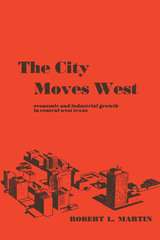 The City Moves West: Economic and Industrial Growth in Central West Texas
By Robert L. Martin
University of Texas Press, 1969 Where water supply, railway transportation, and oil reserves have been abundant, towns in central West Texas have prospered; where these resources are few, settlements have maintained only slight growth or disappeared entirely. Supporting his conclusions with profuse statistical evidence, Robert L. Martin traces the economic development of six major towns in the area, all with over 10,000 residents in 1960: Lamesa, Snyder, Sweetwater, Big Spring, Midland, and Odessa. Ranching brought the first settlers to West Texas in the 1870s and dominated the economy until 1900. In the 1880s farmers began to arrive, and between 1900 and 1930 agricultural production replaced ranching as the most important industry. With the influx of population came the railroad, and small settlements were established along its route. Those with sufficient water supply prospered and, as counties were organized, became county seats and supply centers for the surrounding agricultural regions. The land could not support a large agricultural population, and agriculture-related manufactures soon drew population to the towns. However, it was not until the oil discoveries of the 1920's that the modern city emerged. After World War II, oil production and oil-related industries generated great wealth and caused a boom in population growth and urban development. Despite the growth in prosperity, the economy is precariously balanced. Urban centers dependent on oil—an industry of limited life—have matured in an area without sufficient water or agricultural resources to support them. Martin concludes that, without careful planning and a solution to the water problem, these cities could some day become ghost towns on the plains.
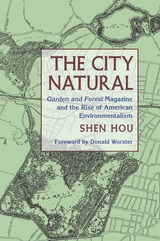 The City Natural: Garden and Forest Magazine and the Rise of American Environmentalism
Shen Hou
University of Pittsburgh Press, 2013
The weekly magazine Garden and Forest existed for only nine years (1888–1897). Yet, in that brief span, it brought to light many of the issues that would influence the future of American environmentalism. In The City Natural, Shen Hou presents the first “biography” of this important but largely overlooked vehicle for individuals with the common goal of preserving nature in American civilization.
As Hou’s study reveals, Garden and Forest was instrumental in redefining the fields of botany and horticulture, while also helping to shape the fledgling professions of landscape architecture and forestry. The publication actively called for reform in government policy, urban design, and future planning for the preservation and inclusion of nature in cities. It also attempted to shape public opinion on these issues through a democratic ideal that every citizen had the right (and need) to access nature. These notions would anticipate the conservation and “city beautiful” movements that followed in the early twentieth century.
Hou explains the social and environmental conditions that led to the rise of reform efforts, organizations, and publications such as Garden and Forest. She reveals the intellectual core and vision of the magazine as a proponent of the city natural movement that sought to relate nature and civilization through the arts and sciences. Garden and Forest was a staunch advocate of urban living made better through careful planning and design. As Hou shows, the publication also promoted forest management and preservation, not only as a natural resource but as an economic one. She also profiles the editors and contributors who set the magazine’s tone and follows their efforts to expand America’s environmental expertise.
Through the pages of Garden and Forest, the early period of environmentalism was especially fruitful and optimistic; many individuals joined forces for the benefit of humankind and helped lay the foundation for a coherent national movement. Shen Hou’s study gives Garden and Forest its due and adds an important new chapter to the early history of American environmentalism.
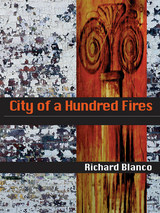 City of a Hundred Fires
Richard Blanco
University of Pittsburgh Press, 1998 "Richard Blanco, a Cuban raised in the United States, records his threefold burdens: learning and adapting to American culture, translating for family and friends, and maintaining his own roots. . . . Blanco is already a mature, seasoned writer, and his powers of description and determination to get every nuance correct are evident from the first poem. . . . Absolutely essential for all libraries." --Library Journal
"As one of the newer voices in Cuban-American poetry, Blanco write about the reality of an uprooted culture and how the poet binds the farthest regions of the world together through language. . . . This book describes the price of exile and extends beyond the shores of America and the imagined shores of home." --Bloomsbury Review
"Unlike most contemporary minority poetry, City of a Hundred Fires, introduces readers to the fullness and richness of ethnic life, and not only the frustration and isolation so often associated with it. Richard Blanco exquisitely portrays the triumphs and defeats of a land and a people that have just barely survived revolution and time, and, without sentiment or cliche, affirms the ability within us all to achieve wholeness." --Indiana Review
"Blanco is a fine young poet, and this poetry, the bread and wine of our language of exile, is pure delight. May he continue to produce such a heavenly mix of rhythm and image-these poems are more than gems, they are the truth not only about the Cuban-American experience, but of our collective experience in the United States, a beautiful land of gypsies." --Virgil Suarez
Richard Blanco was, as he says, "made in Cuba, asssembled in Madrid, and imported to the United States," meaning he was conceived in Cuba, born in Madrid, and arrived in the United States as an infant able to claim citizenship in three different countries. His work has appeared in many journals, magazines, and anthologies, including the Nation, Michigan Quarterly, TriQuarterly, and Indiana Review. Blanco is a graduate of the MFA program in creative writing at Florida International University and also works as a civil engineer.
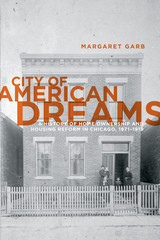 City of American Dreams: A History of Home Ownership and Housing Reform in Chicago, 1871-1919
Margaret Garb
University of Chicago Press, 2005 In this vivid portrait of life in Chicago in the fifty years after the Civil War, Margaret Garb traces the history of the American celebration of home ownership. As the nation moved from an agrarian to an industrialized urban society, the competing visions of capitalists, reformers, and immigrants turned the urban landscape into a testing ground for American values. Neither a natural progression nor an inevitable outcome, the ideal of home ownership emerged from the struggles of industrializing cities. Garb skillfully narrates these struggles, showing how the American infatuation with home ownership left the nation's cities sharply divided along class and racial lines.
Based on research of real estate markets, housing and health reform, and ordinary homeowners—African American and white, affluent and working class—City of American Dreams provides a richly detailed picture of life in one of America's great urban centers. Garb shows that the pursuit of a single-family house set on a tidy yard, commonly seen as the very essence of the American dream, resulted from clashes of interests and decades of struggle.
City of Ash
Eugenijus Alisanka
Northwestern University Press, 2000 Although the title of this sensitive collection refers to Vilnius, the capital of Lithuania, City of Ash serves as a universal geography of the contemporary soul in an urban context. Through his poetry, Eugenijus Alisanka searches for personal and historical meaning within the framework of time, recognizing both the demands of the self and the impossibility of avoiding what came before, whether human or cultural.
 City of Big Shoulders: A History of Chicago
Robert G. Spinney
Northern Illinois University Press, 2000
This compact yet comprehensive account of Chicago's history links key events in the city's development, from its marshy origins in the 1600s to today's robust metropolis. Synthesizing a vast body of literature, Spinney presents Chicago in terms of the people whose lives made the city—not only the tycoons and the politicians but also the hundreds of thousands of immigrants from all over the world who have kept the city working.
City of Big Shoulders sweeps across the colorful and dramatic panorama of Chicago's explosive past. How did the pungent swamplands that the Native Americans called the wild-garlic place mushroom into one of the world's largest and most sophisticated cities? What is the real story behind the Great Chicago Fire? What aspects of American industry exploded with the bomb in Haymarket Square? Did the 1920s in Chicago roar as loudly as Hollywood would have us believe?
A city of immigrants and entrepreneurs, Chicago is quintessentially American. Spinney traces formative events in the city's history, bringing to life the people, events, and institutions that are most important for understanding Chicago's story. From Fort Dearborn to Cabrini-Green, Père Marquette to Mayor Daley, the Union Stockyards to the Chicago Bulls, City of Big Shoulders draws together diverse threads of the city's development, shedding light on underlying social and economic causes of major events and, especially, on the roles of ordinary people.
Engaging and highly informative, this account will interest students and teachers of urban history, as well as anyone looking for a brisk overview of Chicago's history. Historic photographs and informative tables illuminate the narrative.
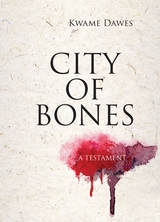 City of Bones: A Testament
Kwame Dawes
Northwestern University Press, 2017 As if convinced that all divination of the future is somehow a re-visioning of the past, Kwame Dawes reminds us of the clairvoyance of haunting. The lyric poems in City of Bones: A Testament constitute a restless jeremiad for our times, and Dawes’s inimitable voice peoples this collection with multitudes of souls urgently and forcefully singing, shouting, groaning, and dreaming about the African diasporic present and future. As the twentieth collection in the poet’s hallmarked career, City of Bones reaches a pinnacle, adding another chapter to the grand narrative of invention and discovery cradled in the art of empathy that has defined his prodigious body of work. Dawes’s formal mastery is matched only by the precision of his insights into what is at stake in our lives today. These poems are shot through with music from the drum to reggae to the blues to jazz to gospel, proving that Dawes is the ambassador of words and worlds.
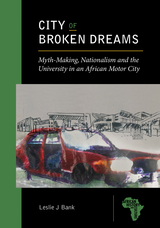 City of Broken Dreams: Myth-Making, Nationalism and the University in an African Motor City
Leslie J. Bank
Michigan State University Press, 2019 What role should universities have in revitalizing rust-belt motor cities left to decay by economic and political transformation? In City of Broken Dreams, author Leslie J Bank addresses this question through a detailed case study of East London, a city in South Africa’s Eastern Cape. Here, as in American motor cities like Detroit and Flint, the car’s cultural power and association with the endless possibilities of modernity lie at the heart of the refusal to seek alternative development paths leading away from racially inscribed automotive capitalism. Rooting the university in a history of industrialisation, placemaking and city-building, this book examines contemporary debates about the role that urban universities should have in building economies, creating jobs and reshaping the politics and identities of their communities. In South Africa as in many other nations, institutions of higher education represent potentially powerful cultural and socioeconomic agents, but the 2015 #FeesMustFall student protests against rising tuition costs highlighted the limits of their power. Firmly grounded in the particulars of East London, this thoughtful study illuminates questions common to rust-belt cities and universities around the world.
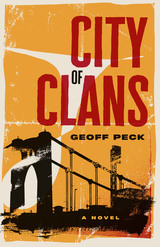 City of Clans
Geoff Peck
University of Iowa Press, 2025 Set on the eve of the 2009 G20 Summit protests, City of Clans follows Jeremy Starcevic, a community college student struggling with his identity and sexuality. By day, Jeremy works for a party goods distributor in the heart of the city and attends classes. By night, he drinks to excess and self-sabotages at the urging of friends. As the son of a professional baseball player, Jeremy grew up playing sports and molding himself into a certain type of guy—a type embodied in Jeremy’s best friend and roommate, the hypermasculine Scott Melloy. But when Scott commits an unthinkable act, Jeremy is forced to acknowledge that the friend he idolized is a sexual predator, and his carefully constructed sense of self crumbles.
Jeremy begins a journey of healing and self-reflection that carries him back to his family and his one true friend, Katrina Kovacs, a photography major who opens his eyes to societal issues he’s always ignored. A story of redemption, City of Clans captures the resiliency of the human spirit and explores hidden truths of masculinity, sexuality, and self.
City of Clerks: Office and Sales Workers in Philadelphia, 1870-1920
Jerome P. Bjelopera
University of Illinois Press, 2005 Below the middle class managers and professionals yet above the skilled blue-collar workers, sales and office workers occupied an intermediate position in urban America's social structure as the nation industrialized. Jerome P. Bjelopera traces the shifting occupational structures and work choices that facilitated the emergence of a white-collar workforce. His fascinating portrait reveals the lives led by Philadelphia's male and female clerks, both inside and outside the workplace, as they formed their own clubs, affirmed their "whiteness," and challenged sexual norms. A vivid look at an overlooked but recognizable workforce, City of Clerks reveals how the notion of "white collar" shifted over half a century.
City of Darkness, City of Light: Emigre Filmmakers in Paris, 1929-1939
Alastair Phillips
Amsterdam University Press, 2004 The volume is the first-ever book-length study of the cinematic representation of Paris in the films of German èmigrè filmmakers, many of whom fled there as a refuge from Hitler. In coming to Paris—a privileged site in terms of production, exhibition, and film culture—these experienced professionals also encountered resistance: hostility toward Germans, anti-Semitism, and boycotts from a French industry afraid of losing jobs to foreigners. Phillips juxtaposes the cinematic portrayal of Paris in the films of Robert Siodmak, Billy Wilder, Fritz Lang, Max Ophüls, Anatol Litvak, and others with the wider social and cultural debates about the city in cinema.
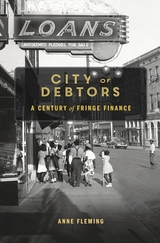 City of Debtors: A Century of Fringe Finance
Anne Fleming
Harvard University Press, 2018 Since the rise of the small-sum lending industry in the 1890s, people on the lowest rungs of the economic ladder in the United States have been asked to pay the greatest price for credit. Again and again, Americans have asked why the most fragile borrowers face the highest costs for access to the smallest loans. To protect low-wage workers in need of credit, reformers have repeatedly turned to law, only to face the vexing question of where to draw the line between necessary protection and overreaching paternalism.
City of Debtors shows how each generation of Americans has tackled the problem of fringe finance, using law to redefine the meaning of justice within capitalism for those on the economic margins. Anne Fleming tells the story of the small-sum lending industry’s growth and regulation from the ground up, following the people who navigated the market for small loans and those who shaped its development at the state and local level. Fleming’s focus on the city and state of New York, which served as incubators for numerous lending reforms that later spread throughout the nation, differentiates her approach from work that has centered on federal regulation. It also reveals the overlooked challenges of governing a modern financial industry within a federalist framework.
Fleming’s detailed work contributes to the broader and ongoing debate about the meaning of justice within capitalistic societies, by exploring the fault line in the landscape of capitalism where poverty, the welfare state, and consumer credit converge.
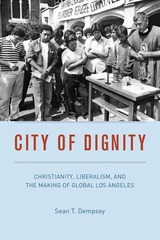 City of Dignity: Christianity, Liberalism, and the Making of Global Los Angeles
Sean T. Dempsey
University of Chicago Press, 2023 City of Dignity illuminates how liberal Protestants quietly, yet indelibly, shaped the progressive ethics of postwar Los Angeles.
Contemporary Los Angeles is commonly seen as an American bulwark of progressive secular politics, a place that values immigration, equity, diversity, and human rights. But what accounts for the city’s embrace of such staunchly liberal values, which are more hotly contested in other parts of the country? The answer, Sean Dempsey reveals, lies not with those frequent targets of credit and blame—Democrats in Hollywood—but instead with liberal Protestants and other steadfast religious organizations of the postwar era.
As the Religious Right movement emerged in the 1970s, progressive religious activists quietly began promoting an ethical vision that made waves worldwide but saw the largest impact in its place of origin: metropolitan Los Angeles. At the center of this vision lay the concept of human dignity—entwining the integral importance of political and expressive freedom with the moral sanctity of the human condition—which suffused all of the political values that arose from it, whether tolerance, diversity, or equality of opportunity. The work of these religious organizations birthed such phenomena as the Sanctuary Movement—which provided safe haven for refugees fleeing conflict-torn Central America—and advocacy for the homeless, both of which became increasingly fraught issues amid the rising tides of neoliberalism and conservatism. City of Dignity explores how these interwoven spiritual and theological strands found common ground—and made common impacts—in the humanitarian ecosystem of one of America’s largest and most dynamic metro areas.
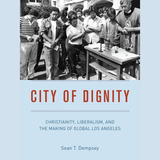 City of Dignity: Christianity, Liberalism, and the Making of Global Los Angeles
Sean T. Dempsey
University of Chicago Press, 2023 This is an auto-narrated audiobook edition of this book.
City of Dignity illuminates how liberal Protestants quietly, yet indelibly, shaped the progressive ethics of postwar Los Angeles.
Contemporary Los Angeles is commonly seen as an American bulwark of progressive secular politics, a place that values immigration, equity, diversity, and human rights. But what accounts for the city’s embrace of such staunchly liberal values, which are more hotly contested in other parts of the country? The answer, Sean Dempsey reveals, lies not with those frequent targets of credit and blame—Democrats in Hollywood—but instead with liberal Protestants and other steadfast religious organizations of the postwar era.
As the Religious Right movement emerged in the 1970s, progressive religious activists quietly began promoting an ethical vision that made waves worldwide but saw the largest impact in its place of origin: metropolitan Los Angeles. At the center of this vision lay the concept of human dignity—entwining the integral importance of political and expressive freedom with the moral sanctity of the human condition—which suffused all of the political values that arose from it, whether tolerance, diversity, or equality of opportunity. The work of these religious organizations birthed such phenomena as the Sanctuary Movement—which provided safe haven for refugees fleeing conflict-torn Central America—and advocacy for the homeless, both of which became increasingly fraught issues amid the rising tides of neoliberalism and conservatism. City of Dignity explores how these interwoven spiritual and theological strands found common ground—and made common impacts—in the humanitarian ecosystem of one of America’s largest and most dynamic metro areas.
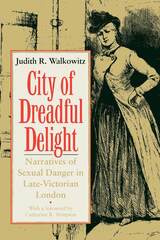 City of Dreadful Delight: Narratives of Sexual Danger in Late-Victorian London
Judith R. Walkowitz
University of Chicago Press, 1992 From tabloid exposes of child prostitution to the grisly tales of Jack the Ripper, narratives of sexual danger pulsated through Victorian London. Expertly blending social history and cultural criticism, Judith Walkowitz shows how these narratives reveal the complex dramas of power, politics, and sexuality that were being played out in late nineteenth-century Britain, and how they influenced the language of politics, journalism, and fiction.
Victorian London was a world where long-standing traditions of class and gender were challenged by a range of public spectacles, mass media scandals, new commercial spaces, and a proliferation of new sexual categories and identities. In the midst of this changing culture, women of many classes challenged the traditional privileges of elite males and
asserted their presence in the public domain.
An important catalyst in this conflict, argues Walkowitz, was W. T. Stead's widely read 1885 article about child prostitution. Capitalizing on the uproar caused by the piece and the volatile political climate of the time, women spoke of sexual danger, articulating their own grievances against men, inserting themselves into the public discussion of sex to an unprecedented extent, and gaining new entree to public spaces and journalistic practices. The ultimate manifestation of class anxiety and gender antagonism came in 1888 with the tabloid tales of Jack the Ripper. In between, there were quotidien stories of sexual possibility and urban adventure, and Walkowitz examines them all, showing how women were not simply figures in the imaginary landscape of male spectators, but also central actors in the stories of metropolotin life that reverberated in courtrooms, learned journals, drawing rooms, street corners, and in the letters columns of the daily press.
A model of cultural history, this ambitious book will stimulate and enlighten readers across a broad range of interests.
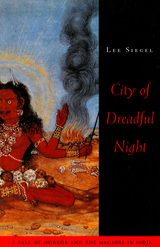 City of Dreadful Night: A Tale of Horror and the Macabre in India
Lee Siegel
University of Chicago Press, 1995 When Lee Siegel went to India to do research for a book on Sanskrit horror literature, a friend in New Delhi told him about an itinerant teller of ghost and vampire tales, a man with clusters of amulets around his neck and a silk top hat with peacock plumes on his head. Siegel set out in search of the old man—called Brahm Kathuwala—to hear his stories and to learn about his uncommon life.
But what started out as a study of other people's stories became a compelling story itself. City of Dreadful Night is an astonishing work of fiction, a tangle of tales that transports the reader from the Medieval India of magicians, witches, and vampires, through the British India of Brahm Kathuwala's childhood, into the chaos and political terror of contemporary India. Vividly recreating Indian literary and oral traditions, Siegel weaves a web of possession, reincarnation, and magical transformation unlike any found in the Western tradition. Flesh-eating demons, Rajiv Gandhi's assassin, even Bram Stoker and Dracula populate the serpentine narrative, which intermingles stories about the characters with the terrifying tales they tell.
Siegel pursues Brahm Kathuwala from the ghastly lights of the cremation ground at Banaras through villages all over north India. Brahm's life story is revealed through countless tales along the way. We learn that he was raised, and abandoned, by two mothers—one the destitute floor sweeper who bore him; the other her employer, a wealthy Irish woman who read and reread to him the story of Dracula. We hear of his marriage to the daughter of a cremation ground attendant, his battles against her demonic possession, and their painful parting. We come to understand the daily life and motivations of this "horror professional," who uses terrifying tales to ward off the evil he himself fears.
This unorthodox book is more than a story; it blends scholarship, fantasy, travelogue, and autobiography—fusing and overlapping historical accounts and newscasts, literary texts and films, dreams and nocturnal tales. Siegel uses imagination to explore the relation of real terror to horror fiction and to contemplate the ways fear and disgust become thrilling elements in stories of the macabre.
This book is the product of Siegel's deep knowledge of both Indian and Western literary and philosophical traditions. It is also an attempt to come to grips with the omnipresence of political and religious terror in contemporary India. Shocking, original, beautifully written, City of Dreadful Night offers readers a captivating immersion in the wonder and terror of India, past and present.
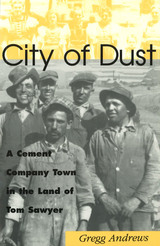 City of Dust: A Cement Company Town in the Land of Tom Sawyer
Gregg Andrews
University of Missouri Press, 2002 Mark Twain's boyhood home of Hannibal, Missouri, often brings to mind romanticized images of Twain's fictional characters Huck Finn or Tom Sawyer exploring caves and fishing from the banks of the Mississippi River. In City of Dust, Gregg Andrews tells another story of the Hannibal area, the very real story of the exploitation and eventual destruction of Ilasco, Missouri, an industrial town created to serve the purposes of the Atlas Portland Cement Company. In this new edition, Andrews provides an introduction detailing the impact of this book since its initial publication in 1996. He writes of a new twist in the Ilasco saga, one that concerns the Continental Cement Company’s attempt, not unlike Atlas’s one hundred years earlier, to manipulate the sale of a piece of land near its plant in the town. He explores the uneasy relationship between preservationists and the plant’s CEO and officials in St. Louis; the growing movement to preserve Ilasco’s heritage, including the building of a monument to commemorate the early residents of the town; and the grassroots petition drive and letter-writing campaign that stopped the Continental Cement Company’s machinations.
City of Eternal Spring
Afaa Michael Weaver
University of Pittsburgh Press, 2014 Winner of the 2015 Phillis Wheatley Book Award (poetry category)
This is the final book in the Plum Flower Trilogy by Afaa Michael Weaver, published by the University of Pittsburgh Press. The two earlier books, The Plum Flower Dance: Poems 1985 to 2005 and The Government of Nature, reveal similar themes that address the author’s personal experience with childhood abuse through the context of Daoist renderings of nature as a metaphor for the human body, with an eye to recovery and forgiveness in a very eclectic spiritual life. City of Eternal Spring chronicles Weaver’s travels abroad in Taiwan and China, as well as showing the limits of cultural influence.
 City of Eves
Silvia Bonilla
University of Arizona Press, 2026 In City of Eves, Silvia Bonilla evokes the lives and longing of three young women who suspect the wider world is a ship on the verge of departure—and who are determined not to be stranded on shore.
Sonia and her two best friends grow up on the urban coast of Ecuador, sharing cigarettes, school uniforms, and a determination to overcome their circumstances even if the price to pay is exile. Full of fantasies and curiosity, the friends navigate hunger at home, absent parents, and religious pressures as they help each other through the pleasures and traumas of adolescence. As their desire for something greater changes from dreams into actions, they pursue escape routes that hover between choice and compulsion: forced marriages, early widowhood, and a death-haunted migration to the United States. Even in the throes of escape, the constraints of their reality always lie waiting.
Subtle and unsparing, Bonilla’s lyrical poems capture the wild inner horizons and vivid embodiment of youth as it shades into the reflective poignance of maturity marked by disappointment, compromise, and loss. Despite this, it is memories of deep friendship, bonded through shared understanding and aspiration, that lingers. Looking back on her life, Sonia recalls the courage and vitality of girls determined to shape their own futures: “We lifted Coca-Cola bottles to the / opened granadilla of our mouths.”
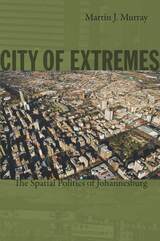 City of Extremes: The Spatial Politics of Johannesburg
Martin J. Murray
Duke University Press, 2011 City of Extremes is a powerful critique of urban development in greater Johannesburg since the end of apartheid in 1994. Martin J. Murray describes how a loose alliance of city builders—including real estate developers, large-scale property owners, municipal officials, and security specialists—has sought to remake Johannesburg in the upbeat image of a world-class city. By creating new sites of sequestered luxury catering to the comfort, safety, and security of affluent urban residents, they have produced a new spatial dynamic of social exclusion, effectively barricading the mostly black urban poor from full participation in the mainstream of urban life. This partitioning of the cityscape is enabled by an urban planning environment of limited regulation or intervention into the prerogatives of real estate capital. Combining insights from urban studies, cultural geography, and urban sociology with extensive research in South Africa, Murray reflects on the implications of Johannesburg’s dual character as a city of fortified enclaves that proudly displays the ostentatious symbols of global integration and the celebrated “enterprise culture” of neoliberal design, and as the “miasmal city” composed of residual, peripheral, and stigmatized zones characterized by signs of a new kind of marginality. He suggests that the “global cities” paradigm is inadequate to understanding the historical specificity of cities in the Global South, including the colonial mining town turned postcolonial megacity of Johannesburg.
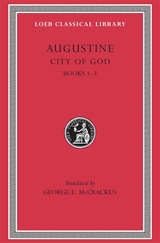 City of God, Volume I: Books 1–3
Augustine
Harvard University Press A Church Father’s theological citadel.
Aurelius Augustine (AD 354–430), one of the most important figures in the development of western Christianity and philosophy, was the son of a pagan, Patricius of Tagaste, and his Christian wife, Monnica. While studying to become a rhetorician, he plunged into a turmoil of philosophical and psychological doubts, leading him to Manichaeism. In 383 he moved to Rome and then Milan to teach rhetoric. Despite exploring classical philosophical systems, especially skepticism and Neoplatonism, his studies of Paul’s letters with his friend Alypius, and the preaching of Bishop Ambrose, led in 386 to his momentous conversion from mixed beliefs to Christianity. He soon returned to Tagaste and founded a religious community, and in 395 or 396 became bishop of Hippo.
From Augustine’s large output the Loeb Classical Library offers that great autobiography the Confessions (in two volumes); On the City of God (seven volumes), which unfolds God’s action in the progress of the world’s history, and propounds the superiority of Christian beliefs over pagan in adversity; and a selection of Letters which are important for the study of ecclesiastical theologians.
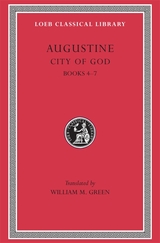 City of God, Volume II: Books 4–7
Augustine
Harvard University Press A Church Father’s theological citadel.
Aurelius Augustine (AD 354–430), one of the most important figures in the development of western Christianity and philosophy, was the son of a pagan, Patricius of Tagaste, and his Christian wife, Monnica. While studying to become a rhetorician, he plunged into a turmoil of philosophical and psychological doubts, leading him to Manichaeism. In 383 he moved to Rome and then Milan to teach rhetoric. Despite exploring classical philosophical systems, especially skepticism and Neoplatonism, his studies of Paul’s letters with his friend Alypius, and the preaching of Bishop Ambrose, led in 386 to his momentous conversion from mixed beliefs to Christianity. He soon returned to Tagaste and founded a religious community, and in 395 or 396 became bishop of Hippo.
From Augustine’s large output the Loeb Classical Library offers that great autobiography the Confessions (in two volumes); On the City of God (seven volumes), which unfolds God’s action in the progress of the world’s history, and propounds the superiority of Christian beliefs over pagan in adversity; and a selection of Letters which are important for the study of ecclesiastical theologians.
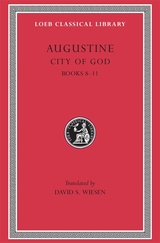 City of God, Volume III: Books 8–11
Augustine
Harvard University Press A Church Father’s theological citadel.
Aurelius Augustine (AD 354–430), one of the most important figures in the development of western Christianity and philosophy, was the son of a pagan, Patricius of Tagaste, and his Christian wife, Monnica. While studying to become a rhetorician, he plunged into a turmoil of philosophical and psychological doubts, leading him to Manichaeism. In 383 he moved to Rome and then Milan to teach rhetoric. Despite exploring classical philosophical systems, especially skepticism and Neoplatonism, his studies of Paul’s letters with his friend Alypius, and the preaching of Bishop Ambrose, led in 386 to his momentous conversion from mixed beliefs to Christianity. He soon returned to Tagaste and founded a religious community, and in 395 or 396 became bishop of Hippo.
From Augustine’s large output the Loeb Classical Library offers that great autobiography the Confessions (in two volumes); On the City of God (seven volumes), which unfolds God’s action in the progress of the world’s history, and propounds the superiority of Christian beliefs over pagan in adversity; and a selection of Letters which are important for the study of ecclesiastical theologians.
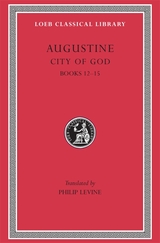 City of God, Volume IV: Books 12–15
Augustine
Harvard University Press A Church Father’s theological citadel.
Aurelius Augustine (AD 354–430), one of the most important figures in the development of western Christianity and philosophy, was the son of a pagan, Patricius of Tagaste, and his Christian wife, Monnica. While studying to become a rhetorician, he plunged into a turmoil of philosophical and psychological doubts, leading him to Manichaeism. In 383 he moved to Rome and then Milan to teach rhetoric. Despite exploring classical philosophical systems, especially skepticism and Neoplatonism, his studies of Paul’s letters with his friend Alypius, and the preaching of Bishop Ambrose, led in 386 to his momentous conversion from mixed beliefs to Christianity. He soon returned to Tagaste and founded a religious community, and in 395 or 396 became bishop of Hippo.
From Augustine’s large output the Loeb Classical Library offers that great autobiography the Confessions (in two volumes); On the City of God (seven volumes), which unfolds God’s action in the progress of the world’s history, and propounds the superiority of Christian beliefs over pagan in adversity; and a selection of Letters which are important for the study of ecclesiastical theologians.
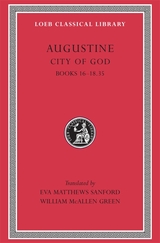 City of God, Volume V: Books 16–18.35
Augustine
Harvard University Press A Church Father’s theological citadel.
Aurelius Augustine (AD 354–430), one of the most important figures in the development of western Christianity and philosophy, was the son of a pagan, Patricius of Tagaste, and his Christian wife, Monnica. While studying to become a rhetorician, he plunged into a turmoil of philosophical and psychological doubts, leading him to Manichaeism. In 383 he moved to Rome and then Milan to teach rhetoric. Despite exploring classical philosophical systems, especially skepticism and Neoplatonism, his studies of Paul’s letters with his friend Alypius, and the preaching of Bishop Ambrose, led in 386 to his momentous conversion from mixed beliefs to Christianity. He soon returned to Tagaste and founded a religious community, and in 395 or 396 became bishop of Hippo.
From Augustine’s large output the Loeb Classical Library offers that great autobiography the Confessions (in two volumes); On the City of God (seven volumes), which unfolds God’s action in the progress of the world’s history, and propounds the superiority of Christian beliefs over pagan in adversity; and a selection of Letters which are important for the study of ecclesiastical theologians.
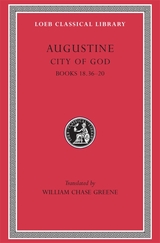 City of God, Volume VI: Books 18.36–20
Augustine
Harvard University Press A Church Father’s theological citadel.
Aurelius Augustine (AD 354–430), one of the most important figures in the development of western Christianity and philosophy, was the son of a pagan, Patricius of Tagaste, and his Christian wife, Monnica. While studying to become a rhetorician, he plunged into a turmoil of philosophical and psychological doubts, leading him to Manichaeism. In 383 he moved to Rome and then Milan to teach rhetoric. Despite exploring classical philosophical systems, especially skepticism and Neoplatonism, his studies of Paul’s letters with his friend Alypius, and the preaching of Bishop Ambrose, led in 386 to his momentous conversion from mixed beliefs to Christianity. He soon returned to Tagaste and founded a religious community, and in 395 or 396 became bishop of Hippo.
From Augustine’s large output the Loeb Classical Library offers that great autobiography the Confessions (in two volumes); On the City of God (seven volumes), which unfolds God’s action in the progress of the world’s history, and propounds the superiority of Christian beliefs over pagan in adversity; and a selection of Letters which are important for the study of ecclesiastical theologians.
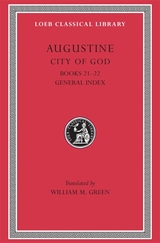 City of God, Volume VII: Books 21–22
Augustine
Harvard University Press A Church Father’s theological citadel.
Aurelius Augustine (AD 354–430), one of the most important figures in the development of western Christianity and philosophy, was the son of a pagan, Patricius of Tagaste, and his Christian wife, Monnica. While studying to become a rhetorician, he plunged into a turmoil of philosophical and psychological doubts, leading him to Manichaeism. In 383 he moved to Rome and then Milan to teach rhetoric. Despite exploring classical philosophical systems, especially skepticism and Neoplatonism, his studies of Paul’s letters with his friend Alypius, and the preaching of Bishop Ambrose, led in 386 to his momentous conversion from mixed beliefs to Christianity. He soon returned to Tagaste and founded a religious community, and in 395 or 396 became bishop of Hippo.
From Augustine’s large output the Loeb Classical Library offers that great autobiography the Confessions (in two volumes); On the City of God (seven volumes), which unfolds God’s action in the progress of the world’s history, and propounds the superiority of Christian beliefs over pagan in adversity; and a selection of Letters which are important for the study of ecclesiastical theologians.
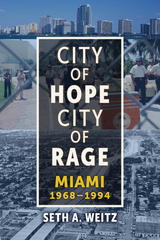 City of Hope, City of Rage: Miami, 1968–1994
Weitz, Seth A.
University of Alabama Press, 2024 Examines Miami’s turbulent transformation from a segregated vacation destination to a global, multicultural metropolis City of Hope, City of Rage gives a fascinating account of three turbulent and transformative decades in the history of Miami. Marked by mass immigration, racially motivated uprisings, economic inequity, rising crime, and social change, Miami’s history from 1968 to 1994 saw the city evolve rapidly from a predominantly white southern city and vacation spot into a global, Hispanic-majority metropolis with an international tourist base. And yet Miami remains highly segregated today. Exploring beyond the clichés of the Magic City as a bastion of hope for immigrants, a fantasy of beaches and art deco architecture, or a hotbed of drugs and crime, historian Seth A. Weitz reveals the social, political, and cultural shifts that transformed the city. Utilizing archival research and personal stories to reveal the diverse experiences of Miami’s Black, Latinx, Jewish, and LGBTQ+ communities, Weitz explores the struggles for social justice, the rise of the drug trade, and the ongoing fight to mold Miami’s image. A Miami native, Weitz challenges simplistic narratives about the city, revealing a place defined by hope, rage, and struggle for identity. Illuminating the way Miami is defined and who gets to define it, City of Hope, City of Rage offers a fresh perspective on this vibrant and complex city, making it a valuable resource for anyone interested in Miami’s unique history.
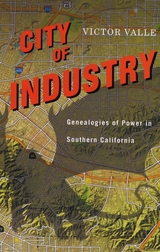 City of Industry: Genealogies of Power in Southern California
Valle, Victor
Rutgers University Press, 2011 Founded in 1957, the Southern California suburb prophetically named City of Industry today represents, in the words of Victor Valle, "The gritty crossroads of the global trade revolution that is transforming Southern California factories into warehouses, and adjacent working class communities into economic and environmental sacrifice zones choking on cheap goods and carcinogenic diesel exhaust."City of Industry is a stunning exposé on the construction of corporate capitalist spaces. Valle investigated an untapped archive of Industry's built landscape, media coverage, and public records, including sealed FBI reports, to uncover a cascading series of scandals. A kaleidoscopic view of the corruption that resulted when local land owners, media barons, and railroads converged to build the city, this suspenseful narrative explores how new governmental technologies and engineering feats propelled the rationality of privatization using their property-owning servants as tools. Valle's tale of corporate greed begins with the city's founder James M. Stafford and ends with present day corporate heir, Edward Roski Jr., the nation's biggest industrial developerùco-owner of the L.A. Staples Arena and possible future owner of California's next NFL franchise. Not to be forgotten in Valle's captivating story are Latino working class communities living within Los Angeles's distribution corridors, who suffer wealth disparities and exposure to air pollution as a result of diesel-burning trucks, trains, and container ships that bring global trade to their very doorsteps. They are among the many victims of City of Industry.
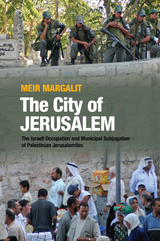 The City of Jerusalem: The Israeli Occupation and Municipal Subjugation of Palestinian Jerusalemites
Meir Margalit
Sussex Academic Press, 2022 This book is centered on the political and economic mechanisms practiced by Israel in East Jerusalem over the last decade. These mechanisms reinforce occupation and keep Jerusalem's Palestinians subjugated through co-optation into the Israeli system. Analysis is polarized on the changes wrought during the mayoralty of Nir Barkat (20082018), who came into politics from the business world and introduced management concepts to the workings of municipal government. While Barkat succeeded in creating the illusion of a "new era" in eastern Jerusalem, the result is heartbreaking displacement and vulnerability toward East Jerusalem's residents, and the application of urban planning that impacts negatively on residents' legal status. Dr Margalit presents a profound sociological and economic analysis of a city under a "normalised" occupation which has destroyed the very essence of what Jerusalem stands for: a reflection of diverse religious belief within a multicultural setting, where citizens' rights are upheld and not discriminated against for political purpose.
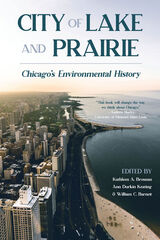 City of Lake and Prairie: Chicago's Environmental History
Kathleen A. Brosnan, William C. Barnett, and Ann Durkin Keating
University of Pittsburgh Press, 2020 Known as the Windy City and the Hog Butcher to the World, Chicago has earned a more apt sobriquet—City of Lake and Prairie—with this compelling, innovative, and deeply researched environmental history. Sitting at the southwestern tip of Lake Michigan, one of the largest freshwater bodies in the world, and on the eastern edge of the tallgrass prairies that fill much of the North American interior, early residents in the land that Chicago now occupies enjoyed natural advantages, economic opportunities, and global connections over centuries, from the Native Americans who first inhabited the region to the urban dwellers who built a metropolis in the nineteenth and twentieth centuries. As one millennium ended and a new one began, these same features sparked a distinctive Midwestern environmentalism aimed at preserving local ecosystems. Drawing on its contributors’ interdisciplinary talents, this volume reveals a rich but often troubled landscape shaped by communities of color, workers, and activists as well as complex human relations with industry, waterways, animals, and disease.
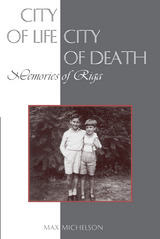 City of Life, City of Death: Memories of Riga
Max Michelson
University Press of Colorado, 2001 City of Life, City of Death: Memories of Riga is Max Michelson's stirring and haunting personal account of the Soviet and German occupations of Latvia and of the Holocaust. Michelson had a serene boyhood in an upper middle-class Jewish family in Riga, Latvia--at least until 1940, when the fifteen-year old Michelson witnessed the annexation of Latvia by the Soviet Union. Private properties were nationalized, and Stalin's terror spread to Soviet Latvia. Soon after, Michelson's family was torn apart by the 1941 Nazi invasion of the Soviet Union. He quickly lost his entire family, while witnessing the unspeakable brutalities of war and genocide. Michelson's memoir is an ode to his lost family; it is the speech of their muted voices and a thank you for their love. Although badly scarred by his experiences, like many other survivors he was able to rebuild his life and gain a new sense of what it means to be alive. His experiences will be of interest to scholars of both the Holocaust and Eastern European history, as well as the general reader.
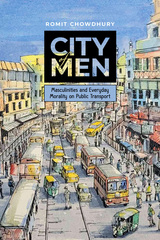 City of Men: Masculinities and Everyday Morality on Public Transport
Romit Chowdhury
Rutgers University Press, 2023 In South Asian urban landscapes, men are everywhere. And yet we do not seem to know very much about precisely what men do in the city as men. How do men experience gender in city spaces? What are the interactional dynamics between different groups of men on city streets? How do men adjudicate between good and bad conduct in urban spaces? Through ethnographic descriptions of copresence on public transport in Kolkata, India, this book brings into sight the gendered logics of cooperation and everyday morality through which masculinities take up space in cities. It follows the labor geographies of auto-rickshaw and taxi operators and their interactions with traffic police and commuters to argue that the gendered fabric of urban life needs to be understood as a product of situational forms of cooperation between different social groups. Such an orientation sheds light on the part played by everyday morality and provisional support in upholding male privilege in the city.
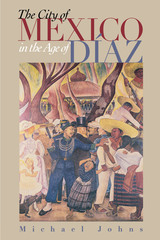 The City of Mexico in the Age of Díaz
By Michael Johns
University of Texas Press, 1997 Mexico City assumed its current character around the turn of the twentieth century, during the dictatorship of Porfirio Díaz (1876-1911). In those years, wealthy Mexicans moved away from the Zócalo, the city's traditional center, to western suburbs where they sought to imitate European and American ways of life. At the same time, poorer Mexicans, many of whom were peasants, crowded into eastern suburbs that lacked such basic amenities as schools, potable water, and adequate sewerage. These slums looked and felt more like rural villages than city neighborhoods. A century—and some twenty million more inhabitants—later, Mexico City retains its divided, robust, and almost labyrinthine character. In this provocative and beautifully written book, Michael Johns proposes to fathom the character of Mexico City and, through it, the Mexican national character that shaped and was shaped by the capital city. Drawing on sources from government documents to newspapers to literary works, he looks at such things as work, taste, violence, architecture, and political power during the formative Díaz era. From this portrait of daily life in Mexico City, he shows us the qualities that "make a Mexican a Mexican" and have created a culture in which, as the Mexican saying goes, "everything changes so that everything remains the same."
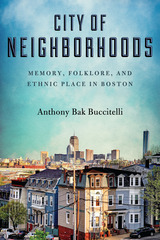 City of Neighborhoods: Memory, Folklore, and Ethnic Place in Boston
Anthony Bak Buccitelli
University of Wisconsin Press, 2016 East Boston has long been known as an Italian neighborhood and Southie as an Irish one, while nearby North Quincy has seen in recent decades an influx of Chinese Americans and immigrants. Such urban spaces in America can become intimately intertwined with ethnic identities (Little Italy, Greektown, Chinatown, Little Havana). Yet local residents often readily acknowledge an underlying diversity—both historically and as a result of more recent changes—that complicates such stereotypes.
Digging into the ever-shifting terrain of American ethnicity and urban spaces, Anthony Bak Buccitelli investigates folk practices, social memory, and local histories in three Boston-area neighborhoods. He looks at the ways locals represent their neighborhoods and themselves via events, symbols, stories, and landmarks, from the shamrock to the Chinese flag, whether the St. Patrick’s Day parade in Southie or the Columbus Day parade in East Boston, from urban graffiti and websites to the Dorchester Heights Monument. City of Neighborhoods exposes the processes of selection and emphasis that produce, sustain, challenge, and change understandings of urban spaces as ethnic places.
Honorable mention, Wayland Hand Prize for Folklore and History, American Folklore Society
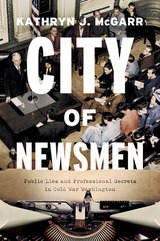 City of Newsmen: Public Lies and Professional Secrets in Cold War Washington
Kathryn J. McGarr
University of Chicago Press, 2022 An inside look at how midcentury DC journalists silenced their own skepticism and shaped public perceptions of the Cold War.
Americans’ current trust in journalists is at a dismayingly low ebb, particularly on the subject of national and international politics. For some, it might be tempting to look back to the mid-twentieth century, when the nation’s press corps was a seemingly venerable and monolithic institution that conveyed the official line from Washington with nary a glint of anti-patriotic cynicism. As Kathryn McGarr’s City of Newsmen shows, however, the real story of what Cold War–era journalists did and how they did it wasn’t exactly the one you’d find in the morning papers.
City of Newsmen explores foreign policy journalism in Washington during and after World War II—a time supposedly defined by the press’s blind patriotism and groupthink. McGarr reveals, though, that DC reporters then were deeply cynical about government sources and their motives, but kept their doubts to themselves for professional, social, and ideological reasons. The alliance and rivalries among these reporters constituted a world of debts and loyalties: shared memories of harrowing wartime experiences, shared frustrations with government censorship and information programs, shared antagonisms, and shared mentors. McGarr ventures into the back hallways and private clubs of the 1940s and 1950s to show how white male reporters suppressed their skepticism to build one of the most powerful and enduring constructed realities in recent US history—the Washington Cold War consensus. Though by the 1960s, this set of reporters was seen as unduly complicit with the government—failing to openly critique the decisions and worldviews that led to disasters like the Vietnam War—McGarr shows how self-aware these reporters were as they negotiated for access, prominence, and, yes, the truth—even as they denied those things to their readers.
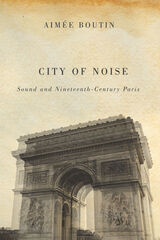 City of Noise: Sound and Nineteenth-Century Paris
Aimee Boutin
University of Illinois Press, 2015 Beloved as the city of light, Paris in the nineteenth century sparked the acclaim of poets and the odium of the bourgeois with its distinctive sounds. Street vendors bellowed songs known as the Cris de Paris that had been associated with their trades since the Middle Ages; musicians itinerant and otherwise played for change; and flâneurs-writers, fascinated with the city's underside, listened and recorded much about what they heard.
Aimée Boutin tours the sonic space that orchestrated the different, often conflicting sound cultures that defined the street ambience of Paris. Mining accounts that range from guidebooks to verse, Boutin braids literary, cultural, and social history to reconstruct a lost auditory environment. Throughout, impressions of street noise shape writers' sense of place and perception of modern social relations. As Boutin shows, the din of the Cris contrasted economic abundance with the disparities of the capital, old and new traditions, and the vibrancy of street commerce with an increasing bourgeois demand for quiet. In time, peddlers who provided the soundtrack for Paris's narrow streets yielded to modernity, with its taciturn shopkeepers and wide-open boulevards, and the fading songs of the Cris became a dirge for the passing of old ways.
 The City of Our Dreaming: The Alchemy Lecture
Laleh Khalili, V. Mitch McEwen, Gabriela Leandro Pereira, and Leanne Betasamosake Simpson
Duke University Press, 2026 The third annual Alchemy Lecture brought together four “Alchemists”—thinkers and practitioners working across disciplines and geographies—to share a constellation of ideas for the future. Their urgent, poignant and inventive lectures compose The City of Our Dreaming, which shares their ideas for cities and how to shape them according to community needs. Together, V. Mitch McEwen, Laleh Khalili, Gabriela Leandro Pereira, and Michi Saagiig Nishnaabeg writer and musician Leanne Betasamosake Simpson offer new models for crafting architectures of freedom in disparate imagined spaces. From suggesting a city modeled on buoyancy that reconsiders displacement to a dream of radical kinship and bonds through reciprocal giving, to “projects paved by the audacity to inhabit” that are built from dreams—the site from which all Black emancipation begins—and to the ways collectives form at the thresholds between things, The City of our Dreaming is a clarion call for new conceptions of city life. The Alchemists imagine the architectures and infrastructures that make possible, inevitable and irresistible gestures of freedom, modes of sustenance, and the necessity and pleasure of breaking bread together.
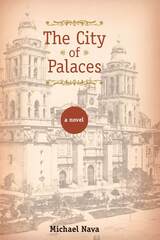 The City of Palaces: A Novel
Michael Nava
University of Wisconsin Press, 2014 In the years before the Mexican Revolution, Mexico is ruled by a tiny elite that apes European culture, grows rich from foreign investment, and prizes racial purity. The vast majority of Mexicans, who are native or of mixed native and Spanish blood, are politically powerless and slowly starving to death. Presiding over this corrupt system is Don Porfirio Díaz, the ruthless and inscrutable president of the Republic.
Against this backdrop, The City of Palaces opens in a Mexico City jail with the meeting of Miguel Sarmiento and Alicia Gavilán. Miguel is a principled young doctor, only recently returned from Europe but wracked by guilt for a crime he committed as a medical student ten years earlier. Alicia is the spinster daughter of an aristocratic family. Disfigured by smallpox, she has devoted herself to working with the city’s destitute. This unlikely pair—he a scientist and atheist and she a committed Christian—will marry. Through their eyes and the eyes of their young son, José, readers follow the collapse of the old order and its bloody aftermath.
The City of Palaces is a sweeping novel of interwoven lives: Miguel and Alicia; José, a boy as beautiful and lonely as a child in a fairy tale; the idealistic Francisco Madero, who overthrows Díaz but is nevertheless destroyed by the tyrant’s political system; and Miguel’s cousin Luis, shunned as a “sodomite.” A glittering mosaic of the colonial past and the wealth of the modern age, The City of Palaces is a story of faith and reason, cathedrals and hovels, barefoot street vendors and frock-coated businessmen, grand opera and silent film, presidents and peasants, the living and the dead.
Winner, International Latino Book Award for Latino Fiction, Latino Literacy Now
Second place, International Latino Book Award for Historical Fiction, Latino Literacy Now
Finalist, Gay Fiction, Lambda Literary Awards
Honorable Mention in Drama, Latino Books into Movies Award, International Latino Book Awards
Best Books for General Audiences, selected by the American Association of School Librarians
Outstanding Book, selected by the Public Library Reviewers
City Of Plagues: Disease, Poverty, And Deviance In San Francisco
Susan Craddock
University of Minnesota Press, 2004 An eye-opening discussion of the ways disease shapes urban society Disease may not discriminate, but it helps those who do. In this fascinating book, Susan Craddock examines the role of disease and health policy in the construction of race, gender, and class, and in urban development in nineteenth- and twentieth-century San Francisco. An absorbing look at the role of disease and health policy in the construction of race, gender, and class in urban development during nineteenth- and twentieth-century San Francisco. Susan Craddock considers tuberculosis, plague, smallpox, and syphilis as diseases whose devastations were derived in part from their use as political tools and disciplinary mechanisms
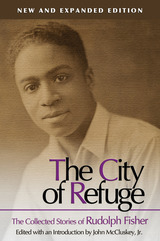 The City of Refuge [New and Expanded Edition]: The Collected Stories of Rudolph Fisher
Rudolph Fisher, Edited & Intro by John McCluskey, Jr.
University of Missouri Press, 2008 One of the premier writers of the Harlem Renaissance, Rudolph Fisher wrote short stories depicting the multifaceted black urban experience that are still acclaimed today for their humor, grace, and objective view of Harlem life. Through his words, wrote the New York Times Book Review, “one feels, smells, and tastes his Harlem; its people come alive and one cares about them.” A definitive collection of Fisher’s short stories, The City of Refuge offers vibrant tales that deal with the problems faced by newcomers to the city, ancestor figures who struggle to instill a sense of integrity in the young, problems of violence and vengeance, and tensions of caste and class. This anthology has now been expanded to include seven previously unpublished stories that take up such themes as marital infidelity and passing for black and also relate the further adventures of Jinx and Bubber, the comic duo who appeared in Fisher’s two novels. This new edition also includes two unpublished speeches and the popular article “The Caucasian Storms Harlem,” describing the craze for black music and dance. John McCluskey’s introduction has been updated to place the additional works within the context of Fisher’s career while situating his oeuvre within the broader context of American writing during the twenties.
Fisher recognized the dramatic and comic power in African American folklore and music and frequented Harlem’s many cabarets, speakeasies, and nightclubs, and at the core of his work is a strong regard for music as context and counterpoint. The City of Refuge now better captures the sounds of the city experience by presenting all of Fisher’s known stories. It offers a portrait of Harlem unmatched in depth and range by Fisher’s contemporaries or successors, celebrating, as Booklist noted, “the complexity of black urban life in its encounter with the dangers and delights of the city.” This expanded edition adds new perspectives to that experience and will enhance Fisher’s status for a new generation of readers.
City Of Salt
Gregory Orr
University of Pittsburgh Press, 1995 City of Salt, Gregory Orr’s sixth book of poems, is largely autobiographical and presents moments of intense emotion which are anchored in clearly dramatized events. These are poems of elegy and celebration, and of occasions where the two modes fuse in acts of redemptive imagination.
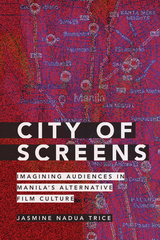 City of Screens: Imagining Audiences in Manila's Alternative Film Culture
Jasmine Nadua Trice
Duke University Press, 2021 In City of Screens Jasmine Nadua Trice examines the politics of cinema circulation in early-2000s Manila. She traces Manila's cinema landscape by focusing on the primary locations of film exhibition and distribution: the pirated DVD district, mall multiplexes, art-house cinemas, the university film institute, and state-sponsored cinematheques. In the wake of digital media piracy and the decline of the local commercial film industry, the rising independent cinema movement has been a site of contestation between filmmakers and the state, each constructing different notions of a prospective, national public film audience. Discourses around audiences become more salient given that films by independent Philippine filmmakers are seldom screened to domestic audiences, despite their international success. City of Screens provides a deeper understanding of the debates about the competing roles of the film industry, the public, and the state in national culture in the Philippines and beyond.
 City of Sisterly and Brotherly Loves: Lesbian and Gay Philadelphia, 1945-1972
Marc Stein
University of Chicago Press, 2000 In this pathbreaking history, Marc Stein takes an in-depth look at Philadelphia from the 1940s to the 1970s. What he finds is a city of vibrant gay and lesbian households, neighborhoods, commercial establishments, public cultures, and political groups. In doing so, Stein shatters the myth that lesbian and gay history began with the 1969 Stonewall riots in New York City and challenges the notion that only New York and San Francisco featured major lesbian and gay communities in the pre-Stonewall era.
Stein takes us on a tour through Philadelphia's bars, restaurants, bookstores, bathhouses, movie theaters, parks, and parades where lesbian and gay cultures thrived.
We learn about the scientific experts, religious leaders, public officials, and journalists who attacked and ignored same-sex sexualities. And we read about the courageous people who fought back with strategies of everyday resistance and organized political activism.
Stein argues against the idea that a conspiracy of silence surrounded gays and lesbians in the 1940s and 1950s. He shows that same-sex sexualities were regularly discussed in controversies concerning the tennis player Big Bill Tilden, the Walt Whitman Bridge, sex murders and crimes, and police raids. Philadelphians became national leaders in the gay and lesbian movement. They conducted sit-ins at Dewey's restaurant, organized pickets at Independence Hall, edited the movement's most widely circulated publications the Ladder and Drum, and pursued court cases all the way to the U.S. Supreme Court.
Beautifully crafted and exceptionally well-written, Stein's book not only provides a new starting place for thinking about lesbian and gay history but also challenges readers to rethink twentieth-century urban history.
City Of Sisterly And Brotherly Loves: Lesbian And Gay Philadelphia, 1945-1972
Marc Stein
Temple University Press, 2004 Marc Stein's City of Sisterly and Brotherly Loves is refreshing for at least two reasons: it centers on a city that is not generally associated with a vibrant gay and lesbian culture, and it shows that a community was forming long before the Stonewall rebellion. In this lively and well received book, Marc Stein brings to life the neighborhood bars and clubs where people gathered and the political issues that rallied the community. He reminds us that Philadelphians were leaders in the national gay and lesbian movement and, in doing so, suggests that New York and San Francisco have for too long obscured the contributions of other cities to gay culture.
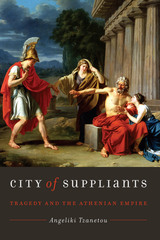 City of Suppliants: Tragedy and the Athenian Empire
By Angeliki Tzanetou
University of Texas Press, 2012 After fending off Persia in the fifth century BCE, Athens assumed a leadership position in the Aegean world. Initially it led the Delian League, a military alliance against the Persians, but eventually the league evolved into an empire with Athens in control and exacting tribute from its former allies. Athenians justified this subjection of their allies by emphasizing their fairness and benevolence towards them, which gave Athens the moral right to lead. But Athenians also believed that the strong rule over the weak and that dominating others allowed them to maintain their own freedom. These conflicting views about Athens’ imperial rule found expression in the theater, and this book probes how the three major playwrights dramatized Athenian imperial ideology. Through close readings of Aeschylus’ Eumenides, Euripides’ Children of Heracles, and Sophocles’ Oedipus at Colonus, as well as other suppliant dramas, Angeliki Tzanetou argues that Athenian tragedy performed an important ideological function by representing Athens as a benevolent and moral ruler that treated foreign suppliants compassionately. She shows how memorable and disenfranchised figures of tragedy, such as Orestes and Oedipus, or the homeless and tyrant-pursued children of Heracles were generously incorporated into the public body of Athens, thus reinforcing Athenians’ sense of their civic magnanimity. This fresh reading of the Athenian suppliant plays deepens our understanding of how Athenians understood their political hegemony and reveals how core Athenian values such as justice, freedom, piety, and respect for the laws intersected with imperial ideology.
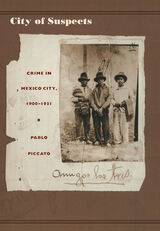 City of Suspects: Crime in Mexico City, 1900–1931
Pablo Piccato
Duke University Press, 2001 In City of Suspects Pablo Piccato explores the multiple dimensions of crime in early-twentieth-century Mexico City. Basing his research on previously untapped judicial sources, prisoners’ letters, criminological studies, quantitative data, newspapers, and political archives, Piccato examines the paradoxes of repressive policies toward crime, the impact of social rebellion on patterns of common crime, and the role of urban communities in dealing with transgression on the margins of the judical system.
By investigating postrevolutionary examples of corruption and organized crime, Piccato shines light on the historical foundations of a social problem that remains the main concern of Mexico City today. Emphasizing the social construction of crime and the way it was interpreted within the moral economy of the urban poor, he describes the capital city during the early twentieth century as a contested territory in which a growing population of urban poor had to negotiate the use of public spaces with more powerful citizens and the police. Probing official discourse on deviance, Piccato reveals how the nineteenth-century rise of positivist criminology—which asserted that criminals could be readily distinguished from the normal population based on psychological and physical traits—was used to lend scientific legitimacy to class stratifications and to criminalize working-class culture. Furthermore, he argues, the authorities’ emphasis on punishment, isolation, and stigmatization effectively created cadres of professional criminals, reshaping crime into a more dangerous problem for all inhabitants of the capital.
This unique investigation into crime in Mexico City will interest Latin Americanists, sociologists, and historians of twentieth-century Mexican history.
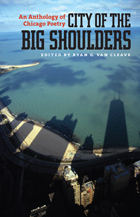 City of the Big Shoulders: An Anthology of Chicago Poetry
Ryan G. Van Cleave
University of Iowa Press, 2012 Chicago has served as touchstone and muse to generations of writers and artists defined by their relationship to the city’s history, lore, inhabitants, landmarks, joys and sorrows, pride and shame. The poetic conversations inspired by Chicago have long been a vital part of America’s literary landscape, from Carl Sandburg and Gwendolyn Brooks to experimental writers and today’s slam poets. The one hundred contributors to this vibrant collection take their materials and their inspirations from the city itself in a way that continues this energetic dialogue. The cultural, ethnic, and aesthetic diversity in this gathering of poems springs from a variety of viewpoints, styles, and voices as multifaceted and energetic as the city itself. Cristin O’Keefe Aptowicz: “I want to eat / in a city smart enough to know that if you / are going to have that heart attack, you might / as well have the pleasure of knowing // you’ve really earned it”; Renny Golden: “In the heat of May 1937, my grandfather / sits in the spring grass of an industrial park / with hundreds of striking steelworkers”; Joey Nicoletti: “The wind pulls a muscle / as fans yell the vine off the outfield wall, / mustard-stained shirts, hot dog smiles, and all.” The combined energies of these poems reveal the mystery and beauty that is Second City, the City by the Lake, New Gotham, Paris on the Prairie, the Windy City, the Heart of America, and Sandburg’s iconic City of the Big Shoulders.
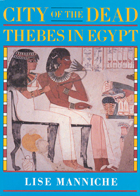 City of the Dead: Thebes in Egypt
Lise Manniche
University of Chicago Press, 1987 The Theban necropolis lies in strange contrast to the bustle of Luxor on the opposite bank of the Nile. Over 450 tombs spanning more than a thousand years, some fully excavated and recorded, others tantalisingly described by travellers but now lost, form a maze-like network of passages and caves. The decoration of many of the tombs, particularly those of the Eighteenth dynasty, provides some outstanding examples of ancient Egyptian painting and relief work and reveals fascinating details about the lives and beliefs of their owners. Some of the tombs were re-used and display contrasting styles of workmanship, while many were colonised in more recent centuries by peoples with scant respect for the tombs of their ancestors: many well-paintings are blackened and burnt beyond redemption.
The author traces the history of the site discussing the more important tombs in some detail, and sheds new light on the symbolism used in painting to help the deceased in the Afterlife. She also surveys the role of the treasure hunters and travellers of the eighteenth and early nineteenth-centuries and the pioneer epigraphers who followed them and paved the way for the archeological investigation and research that continues today.
 City of the Great King: Jerusalem from David to the Present
Nitza Rosovsky
Harvard University Press, 1996 With majestic sweep and sparkling detail, this magnificent volume brings to life the great and ancient drama of the world's holiest city on the eve of a new millennium. Some three thousand years ago King David captured Jerusalem from the Jebusites and made the city his capital. There Solomon built the Temple and the Jewish people found their spiritual center. From its glory under the House of David to its emergence a thousand years later as the birthplace of Christianity, from its destruction by the Romans to its conquest by the forces of Islam and its Crusader and Ottoman periods, Jerusalem has been endlessly revered and warred over, passionately celebrated and desecrated. Mining the rich evidence of this remarkable history, the world-renowned authors gathered here conjure the Holy City as it has appeared in antique Hebrew texts; in the testimony of Jewish and Christian pilgrims and in art; in medieval Islamic literature and in western nineteenth-century accounts; in maps and mosaics and architecture through the ages.
Here is Jerusalem in its physical splendor, the sun rising over the Mount of Olives to touch the golden crown of the Dome of the Rock and warm the crenelated walls of the Old City, with its foundations from the days of the Hasmoneans and Herod the Great, its seven gates and Jewish, Christian, Armenian, and Muslim quarters marked out by the Roman decumanus and the Byzantine cardo. Above the Ramban Synagogue, established by Nachmanides in 1267, looms the minaret of the fifteenth-century Sidi Umar Mosque. Nearby are the foundations and apses of the Crusader Church of St. Mary of the German Knights, which in turn abuts the underground Herodian Quarter, with its fresco-covered walls, mosaic floors, and opulent baths. Remnants of the Nea Church erected by Justinian in 543 and of the Ayyubid tower from the thirteenth century stand within the Garden of Redemption, a memorial to the six million Jews exterminated by the Nazis.
Amid these marvels of geography and architecture, the authors evoke Jerusalem's spiritual history, the events and legends that have made the city the touching point between the divine and the earthly for Jews, Christians, and Muslims alike. They trace Jerusalem's fortunes as the City of David, as the site of the Crucifixion and Resurrection of Jesus, as the "Furthest Shrine" from which the Prophet Mohammed ascended to heaven. Writing from an enlightening variety of backgrounds and perspectives, the authors share a depth of feeling for their subject that imparts a warmth and immediacy to their depiction of the city in all its historic grandeur and religious complexity. An Armenian Jerusalemite once wrote that in the Holy City each person carries a mirror, but each holds it in only one direction. This book brings all these reflections together to create a living picture of Jerusalem not only in history but also in the hearts of those who call it home and those who revere it as a Holy City.
City of the Soul: Rome and the Romantics
John A. Pinto
University Press of New England, 2016 City of the Soul critically examines how an international cast of visitors fashioned Rome’s image, visual and literary, in the century between 1770 and 1870—from the era of the Grand Tour to the onset of mass tourism. The Eternal City emerges not only as an intensely physical place but also as a romantic idea onto which artists and writers projected their own imaginations and longings. The book will appeal to a wide audience of readers interested in the history of art, architecture, and photography, the Romantic poets, and other writers from Byron to Henry James. It will also attract the interest of historians of urbanism, landscape, and Italy. Nonspecialists and armchair travelers will enjoy the diverse literary and artistic responses to Rome.
The City Of Trembling Leaves
Walter Van Tilburg Clark
University of Nevada Press, 2012 The City of Trembling Leaves by Walter Van Tilburg Clark was first published in 1945 by Random House and reprinted by the University of Nevada Press in paperback in 1991 with a new foreword by Robert Laxalt. Clark’s novel broke new ground in his telling of the story of the rites of passage of a boy, Tim Hazard, into adulthood in the setting of the Western town of Reno, Nevada. The descriptions of Reno’s landscape and the realistic characters depict the role of nature during the tumultuous stages of adolescence and the potential risk of obstruction and loss in the attainment of maturity.
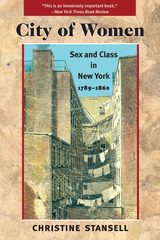 City of Women: Sex and Class in New York, 1789-1860
Christine Stansell
University of Illinois Press, 1987 Before the Civil War, a new idea of womanhood took shape in America in general and in the Northeast in particular. Women of the propertied classes assumed the mantle of moral guardians of their families and the nation. Laboring women, by contrast, continued to suffer from the oppressions of sex and class. In fact, their very existence troubled their more prosperous sisters, for the impoverished female worker violated dearly held genteel precepts of 'woman's nature' and 'woman's place.'
City of Women delves into the misfortunes that New York City's laboring women suffered and the problems that resulted. Looking at how and why a community of women workers came into existence, Christine Stansell analyzes the social conflicts surrounding laboring women and they social pressure these conflicts brought to bear on others. The result is a fascinating journey into economic relations and cultural forms that influenced working women's lives—one that reveals at last the female city concealed within America's first great metropolis.
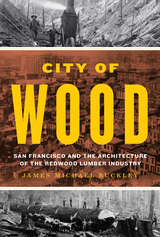 City of Wood: San Francisco and the Architecture of the Redwood Lumber Industry
James Michael Buckley
University of Texas Press, 2024 2025 J.B. Jackson Book Prize, University of Virginia Center for Cultural Landscapes
2025 John Brinckerhoff Jackson Prize, Association of American Geographers
2025 Abbott Lowell Cummings Award, Vernacular Architecture Forum
How San Franciscans exploited natural resources such as redwood lumber to produce the first major metropolis of the American West. California’s 1849 gold rush triggered creation of the “instant city” of San Francisco as a base to exploit the rich natural resources of the American West. City of Wood examines how capitalists and workers logged the state’s vast redwood forests to create the financial capital and construction materials needed to build the regional metropolis of San Francisco. Architectural historian James Michael Buckley investigates the remote forest and its urban core as two poles of a regional “city.” This city consisted of a far-reaching network of spaces, produced as company owners and workers arrayed men and machines to extract resources and create human commodities from the region’s rich natural environment. Combining labor, urban, industrial, and social history, City of Wood employs a variety of sources—including contemporary newspaper articles, novels, and photographs—to explore the architectural landscape of lumber, from backwoods logging camps and company towns in the woods to busy lumber docks and the homes of workers and owners in San Francisco. By imagining the redwood lumber industry as a single community spread across multiple sites—a “City of Wood”—Buckley demonstrates how capitalist resource extraction links different places along the production value chain. The result is a paradigm shift in architectural history that focuses not just on the evolution of individual building design across time, but also on economic connections that link the center and periphery across space.
 City on a Hill: Urban Idealism in America from the Puritans to the Present
Alex Krieger
Harvard University Press, 2019 A sweeping history of American cities and towns, and the utopian aspirations that shaped them, by one of America’s leading urban planners and scholars.
The first European settlers saw America as a paradise regained. The continent seemed to offer a God-given opportunity to start again and build the perfect community. Those messianic days are gone. But as Alex Krieger argues in City on a Hill, any attempt at deep understanding of how the country has developed must recognize the persistent and dramatic consequences of utopian dreaming. Even as ideals have changed, idealism itself has for better and worse shaped our world of bricks and mortar, macadam, parks, and farmland. As he traces this uniquely American story from the Pilgrims to the “smart city,” Krieger delivers a striking new history of our built environment.
The Puritans were the first utopians, seeking a New Jerusalem in the New England villages that still stand as models of small-town life. In the Age of Revolution, Thomas Jefferson dreamed of citizen farmers tending plots laid out across the continent in a grid of enlightened rationality. As industrialization brought urbanization, reformers answered emerging slums with a zealous crusade of grand civic architecture and designed the vast urban parks vital to so many cities today. The twentieth century brought cycles of suburban dreaming and urban renewal—one generation’s utopia forming the next one’s nightmare—and experiments as diverse as Walt Disney’s EPCOT, hippie communes, and Las Vegas.
Krieger’s compelling and richly illustrated narrative reminds us, as we formulate new ideals today, that we chase our visions surrounded by the glories and failures of dreams gone by.
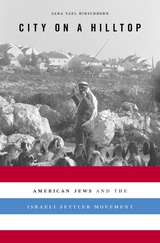 City on a Hilltop: American Jews and the Israeli Settler Movement
Sara Yael Hirschhorn
Harvard University Press, 2017 Since 1967, more than 60,000 Jewish-Americans have settled in the territories captured by the State of Israel during the Six Day War. Comprising 15 percent of the settler population today, these immigrants have established major communities, transformed domestic politics and international relations, and committed shocking acts of terrorism. They demand attention in both Israel and the United States, but little is known about who they are and why they chose to leave America to live at the center of the Israeli-Palestinian conflict.
In this deeply researched, engaging work, Sara Yael Hirschhorn unsettles stereotypes, showing that the 1960s generation who moved to the occupied territories were not messianic zealots or right-wing extremists but idealists engaged in liberal causes. They did not abandon their progressive heritage when they crossed the Green Line. Rather, they saw a historic opportunity to create new communities to serve as a beacon—a “city on a hilltop”—to Jews across the globe. This pioneering vision was realized in their ventures at Yamit in the Sinai and Efrat and Tekoa in the West Bank. Later, the movement mobilized the rhetoric of civil rights to rebrand itself, especially in the wake of the 1994 Hebron massacre perpetrated by Baruch Goldstein, one of their own.
On the fiftieth anniversary of the 1967 war, Hirschhorn illuminates the changing face of the settlements and the clash between liberal values and political realities at the heart of the Israeli-Palestinian conflict.
A City on a Lake: Urban Political Ecology and the Growth of Mexico City
Matthew Vitz
Duke University Press, 2018 In A City on a Lake Matthew Vitz tracks the environmental and political history of Mexico City and explains its transformation from a forested, water-rich environment into a smog-infested megacity plagued by environmental problems and social inequality. Vitz shows how Mexico City's unequal urbanization and environmental decline stemmed from numerous scientific and social disputes over water policy, housing, forestry, and sanitary engineering. From the prerevolutionary efforts to create a hygienic city supportive of capitalist growth, through revolutionary demands for a more democratic distribution of resources, to the mid-twentieth-century emergence of a technocratic bureaucracy that served the interests of urban elites, Mexico City's environmental history helps us better understand how urban power has been exercised, reproduced, and challenged throughout Latin America.
City on Fire: Technology, Social Change, and the Hazards of Progress in Mexico City, 1860-1910
Anna Rose Alexander
University of Pittsburgh Press, 2016 By the mid-nineteenth century, efforts to modernize and industrialize Mexico City had the unintended consequence of exponentially increasing the risk of fire while also breeding a culture of fear. Through an array of archival sources, Anna Rose Alexander argues that fire became a catalyst for social change, as residents mobilized to confront the problem. Advances in engineering and medicine soon fostered the rise of distinct fields of fire-related expertise while conversely, the rise of fire-profiteering industries allowed entrepreneurs to capitalize on crisis.
City on Fire demonstrates that both public and private engagements with fire risk highlight the inequalities that characterized Mexican society at the turn of the twentieth century.
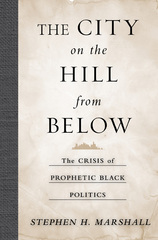 The City on the Hill From Below: The Crisis of Prophetic Black Politics
Authored by Stephen Marshall
Temple University Press, 2012 Within the discipline of American political science and the field of political theory, African American prophetic political critique as a form of political theorizing has been largely neglected. Stephen Marshall, in The City on the Hill from Below, interrogates the political thought of David Walker, Frederick Douglass, W. E. B. DuBois, James Baldwin, and Toni Morrison to reveal a vital tradition of American political theorizing and engagement with an American political imaginary forged by the City on the Hill. Originally articulated to describe colonial settlement, state formation, and national consolidation, the image of the City on the Hill has been transformed into one richly suited to assessing and transforming American political evil. The City on the Hill from Below shows how African American political thinkers appropriated and revised languages of biblical prophecy and American republicanism.
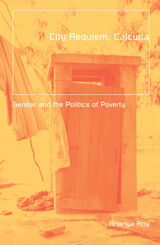 City Requiem, Calcutta: Gender And The Politics Of Poverty
Ananya Roy
University of Minnesota Press, 2002 Uses Calcutta as a site for the exploration of persistent structures of deprivation and want. Housing developments emerge amid the paddy fields on the fringes of Calcutta; overflowing trains carry peasant women to informal urban labor markets in a daily commute against hunger; land is settled and claimed in a complex choreography of squatting and evictions: such, Ananya Roy contends, are the distinctive spaces of a communism for the new millennium-where, at a moment of liberalization, the hegemony of poverty is quietly reproduced. An ethnography of urban development in Calcutta, Roy’s book explores the dynamics of class and gender in the persistence of poverty. City Requiem, Calcutta emphasizes how gender itself is spatialized and how gender relations are negotiated through the everyday practices of territory. Thus Roy shows how urban developmentalism, in its populist guise, reproduces the relations of masculinist patronage, and, in its entrepreneurial guise, seeks to reclaim a bourgeois Calcutta, gentlemanly in its nostalgias. In doing so, her work expands the field of poverty studies by showing how a politics of poverty is also a poverty of knowledge, a construction and management of social and spatial categories.
 The City, Revisited: Urban Theory from Chicago, Los Angeles, and New York
Dennis R. Judd
University of Minnesota Press, 2011 The contributors to The City, Revisited trace an intellectual history that begins in 1925 with the publication of the influential classic The City, engaging in a spirited debate about whether the major theories of twentieth-century urban development are relevant for studying the twenty-first-century metropolis.
Contributors: Janet Abu-Lughod, Northwestern U and New School for Social Research; Robert Beauregard, Columbia U; Larry Bennett, DePaul U; Andrew A. Beveridge, Queens College and CUNY; Amy Bridges, U of California, San Diego; Terry Nichols Clark, U of Chicago; Nicholas Dahmann, U of Southern California; Michael Dear, U of California, Berkeley; Steven P. Erie, U of California, San Diego; Frank Gaffikin, Queen's U of Belfast; David Halle, U of California, Los Angeles; Tom Kelly, U of Illinois at Chicago; Ratoola Kunda, U of Illinois at Chicago; Scott A. MacKenzie, U of California, Davis; John Mollenkopf, CUNY; David C. Perry, U of Illinois at Chicago; Francisco Sabatini, Ponticia Universidad Catolica de Chile; Rodrigo Salcedo, Pontificia Universidad Catolica de Santiago; Dick Simpson, U of Illinois at Chicago; Daphne Spain, U of Virginia; Costas Spirou, National-Louis U in Chicago.
City Rules: How Regulations Affect Urban Form
Emily Talen
Island Press, 2011 City Rules offers a challenge to students and professionals in urban planning, design, and policy to change the rules of city-building, using regulations to reinvigorate, rather than stifle, our communities. Emily Talen demonstrates that regulations are a primary detriment to the creation of a desirable urban form. While many contemporary codes encourage sprawl and even urban blight, that hasn't always been the case-and it shouldn't be in the future.
Talen provides a visually rich history, showing how certain eras used rules to produce beautiful, walkable, and sustainable communities, while others created just the opposite. She makes complex regulations understandable, demystifying city rules like zoning and illustrating how written codes translate into real-world consequences. Most importantly, Talen proposes changes to these rules that will actually enhance communities' freedom to develop unique spaces.
City Scattered: CABARET FOR FOUR VOICES
Tyler Mills
Tupelo Press, 2022 Goblets of gin, fans of feathers, war-bombed bricks, loaves of bread, soot, smoke, and paper money—such are the tangible things that touched the lives of women who worked as wage laborers during an era of Europe of cabaret and hyperinflation. The crises of modernity and capital, as well as the human experiences of women and who loved, lost, and fought against the structures of privilege that all the while aided them during a fraught stretch of time between wars, come alive in City Scattered, a chapbook of poems that invite us to experience and examine the conditions of labor that echo those of our current day.
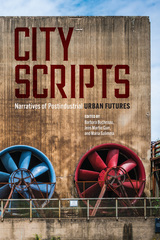 City Scripts: Narratives of Postindustrial Urban Futures
Edited by Barbara Buchenau, Jens Martin Gurr, and Maria Sulimma
Ohio State University Press, 2023 Storytelling shapes how we view our cities, legitimizing histories, future plans, and understandings of the urban. City Scripts responds to calls by literary theorists to engage a new kind of narrative analysis that recalibrates close reading and interpretation to the multiple ways in which narratives “do things”—how they intervene in the world and take action in everyday life. A multidisciplinary cast of contributors approaches this new way of looking at cities through the stories people tell about them, looking especially at political activism and urban planning, which depend on the invention of plausible stories of connectedness and of a redemptive future.
The stakes are especially high in cities where economic, ecological, and social futures are delimited by histories of large-scale extraction and racialized industrial labor. Contributors thus focus on cities in postindustrial areas of Germany and the United States, examining how narratives about cities become scripts and how these scripts produce real-life results. This approach highlights how uses of narrative and scripting appeal to stakeholders in urban change. These actors continually deploy narrative, media, and performance, with consequences for urban futures worldwide. Contributors:
Lieven Ameel, Juliane Borosch, Barbara Buchenau, Florian Deckers, Barbara Eckstein, Kornelia Freitag, Walter Grünzweig, Randi Gunzenhäuser, Jens Martin Gurr, Elisabeth Haefs, Chris Katzenberg, Johannes Maria Krickl, Renee M. Moreno, Hanna Rodewald, Julia Sattler, Maria Sulimma, James A. Throgmorton, Michael Wala, Katharina Wood
City Scriptures: Modern Jewish Writing
Murray Baumgarten
Harvard University Press, 1982 This richly suggestive book examines the common bonds of thought and shared manner of expression that unite Jewish writers working in America, Eastern Europe, and Israel. Murray Baumgarten shows how Jewish traditions are reflected in the themes and narrative style of a diverse group of writers, including Saul Bellow, Henry Roth, Sholom Aleichen, Isaac Babel, and S.Y. Agnon.
Baumgarten finds in these writers a distinctive and symbolic use of the urban scene arid style of life—whether the city is Brooklyn, Chicago, Vienna, Warsaw, Odessa, or Jerusalem. He examines the pariah stance, and the different kinds of tension between freedom from communal ties and the pull of traditional culture. He demonstrates how Yiddish can flavor and inflect the syntax, how scripture can permeate the thinking and narrative devices, in writers of various nationalities.
The City She Was
Carmen Giménez Smith
University Press of Colorado, 2011 Mountain West Poetry Series
Published by the Center for Literary Publishing at Colorado State University
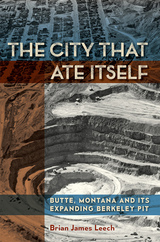 The City That Ate Itself: Butte, Montana and Its Expanding Berkeley Pit
Brian James Leech
University of Nevada Press, 2018 Winner of the Mining History Association Clark Spence Award for the Best Book in Mining History, 2017-2018
Brian James Leech provides a social and environmental history of Butte, Montana’s Berkeley Pit, an open-pit mine which operated from 1955 to 1982. Using oral history interviews and archival finds, The City That Ate Itself explores the lived experience of open-pit copper mining at Butte’s infamous Berkeley Pit. Because an open-pit mine has to expand outward in order for workers to extract ore, its effects dramatically changed the lives of workers and residents. Although the Berkeley Pit gave consumers easier access to copper, its impact on workers and community members was more mixed, if not detrimental.
The pit’s creeping boundaries became even more of a problem. As open-pit mining nibbled away at ethnic communities, neighbors faced new industrial hazards, widespread relocation, and disrupted social ties. Residents variously responded to the pit with celebration, protest, negotiation, and resignation. Even after its closure, the pit still looms over Butte. Now a large toxic lake at the center of a federal environmental cleanup, the Berkeley Pit continues to affect Butte’s search for a postindustrial future.
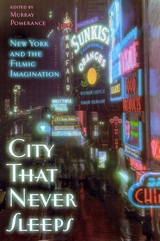 City That Never Sleeps: New York and the Filmic Imagination
Pomerance, Murray
Rutgers University Press, 2007 New York, more than any other city, has held a special fascination for filmmakers and viewers. In every decade of Hollywood filmmaking, artists of the screen have fixated upon this fascinating place for its tensions and promises, dazzling illumination and fearsome darkness.
The glittering skyscrapers of such films as On the Town have shadowed the characteristic seedy streets in which desperate, passionate stories have played out-as in Scandal Sheet and The Pawnbroker. In other films, the city is a cauldron of bright lights, technology, empire, egotism, fear, hunger, and change--the scenic epitome of America in the modern age.
From Street Scene and Breakfast at Tiffany's to Rosemary's Baby, The Warriors, and 25th Hour, the sixteen essays in this book explore the cinematic representation of New York as a city of experience, as a locus of ideographic characters and spaces, as a city of moves and traps, and as a site of allurement and danger. Contributors consider the work of Woody Allen, Blake Edwards, Alfred Hitchcock, Gregory La Cava, Spike Lee, Sidney Lumet, Vincente Minnelli, Roman Polanski, Martin Scorsese, Andy Warhol, and numerous others.
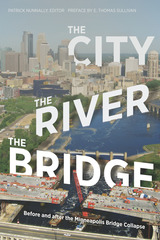 The City, the River, the Bridge: Before and after the Minneapolis Bridge Collapse
Patrick Nunnally
University of Minnesota Press, 2011 On August 1, 2007, just after 6:00 p.m., during the evening rush hour in Minneapolis, the 1,900-foot-long, eight-lane I-35W bridge buckled and crashed into the Mississippi River. The unimaginable had happened right on the doorstep of the University of Minnesota Twin Cities campus. Many of the first responders were from the University, persevering in the midst of chaos and disbelief. In the ensuing weeks, research and engineering teams from the University reviewed the wreckage, searched for causes, and began planning for the future.
The City, the River, the Bridge represents another set of responses to the disaster. Stemming from a 2008 University of Minnesota symposium on the bridge collapse and the building of a new bridge, it addresses the ramifications of the disaster from the perspectives of history, engineering, architecture, water science, community-based journalism, and geography. Contributors examine the factors that led to the collapse, the lessons learned from the disaster and the response, the policy and planning changes that have occurred or are likely to occur, and the impact on the city and the Mississippi River. The City, the River, the Bridge demonstrates the University's commitment to issues that concern the community and shares insights on public questions of city building, infrastructure, and design policy.
Contributors: John O. Anfinson; Roberto Ballarini; Heather Dorsey; Thomas Fisher; Minmao Liao; Judith A. Martin; Roger Miller; Mark Pedelty; Deborah L. Swackhamer; Melissa Thompson.
City Trenches: Urban Politics and the Patterning of Class in the United States
Ira Katznelson
University of Chicago Press, 1982 In City Trenches, Ira Katznelson looks at an important phenomenon of the sixties—the resurgence of community activism—and explains its sources, challenges, and failure. Katznelson argues that the American working class perceives workplace politics and community politics as separate and distinct spheres, a perception that defeats attempts to address grievances or raise demands that break the rules of local politics or of bread-and-butter unionism. He supports his thesis with an absorbing case study of Washington Heights-Inwood, a multiethnic working-class community in Manhattan.
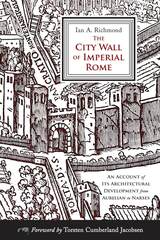 The City Wall of Imperial Rome: An Account of Its Architectural Development from Aurelian to Narses
Ian A. Richmond
Westholme Publishing, 2013 The Essential Study of the Largest Monument Still to Be Seen in Rome
The City Wall of Imperial Rome: An Account of Its Architectural Development from Aurelian to Narses by Sir Ian A. Richmond was first published in 1930 and reprinted in facsimile in 1971. This scarce, essential work on the imperial fortifications of Rome has lost none of its relevance since its original publication. Despite the Wall’s great importance for our understanding of Roman fortifications, there have been no further major investigations. Rome had originally been fortified by the old Servian Wall, built during the Republican period in the late fourth century BC. The city expanded greatly over the centuries and by the time of the emperor Augustus (27 BC–14 AD) little trace of the wall remained. However, there was not a need for a protective wall until the crisis of the third century AD, when barbarian tribes in 270 broke into northern Italy. In response to this new threat, the Aurelian Walls were constructed between 271 and 275 to protect the capital against barbarian raids. The walls enclosed all of Rome on both sides of the Tiber River—an area of about 5.3 square miles— and ran for some 12.5 miles. The construction project was one of the greatest in the history of the city of Rome and the walls were built in a remarkably short time, with the emperor Aurelian himself overseeing the project. Initially, the main aim of the wall was not to withstand prolonged siege warfare but to deter barbarian invaders who were insufficiently equipped for siege warfare. Later, emperor Honorius improved both the walls and gates, so that Rome could withstand a real siege and be defended by a smaller garrison. During the time of the Gothic War (535–552), five thousand Roman troops withstood a year-long siege by an estimated 150,000 Goths due to the strength of the walls. When Rome was captured in 545 by the Ostrogothic king Totila, part of the walls were deliberately destroyed to prevent the Romans from ever using them again. The Aurelian Walls remain remarkably well preserved today, due largely to their constant use as Rome’s primary fortification until the nineteenth century. The walls are the largest monument of ancient Rome still to be seen in the city. In this new edition, Late Antiquity specialist Torsten Cumberland Jacobsen provides current information about the state of the walls and their preservation, an updated bibliography, and an essay about Sir Richmond and his career.
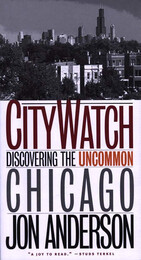 City Watch: Discovering The Uncommon Chicago
Jon Anderson
University of Iowa Press, 2000 In forty-five years as one of Chicago's liveliest journalists for Time, Life, and the Chicago Tribune, Jon Anderson has established a reputation for picking up on what someone once called "the beauty of the specific fact." Part "Talk of the Town," part On the Road with Charles Kuralt, Anderson's twice-a-week "City Watch" columns in the Chicago Tribune seek out interesting and unexpected people and places from the everyday life of what the author calls the "most typical American big city." In the process he discovers the joys and triumphs of ordinary people. Anderson writes with wit and insight about those who find themselves inspired or obsessed with alternative ways of viewing life or getting through the day. Like the man who started with one light pole, then painted all the poles in his southside neighborhood. Or the founder of Cats-Are-Purrsons-Too, a nun who lives with sixty-seven cats. Or the philosopher who, with no financial success, still publishes a newsletter called "The Meaning of Life." After years of hunting down moments of everyday life that have drama and meaning, Anderson offers a book that has curious power, because all of its stories are true. Drawn from the best of Anderson's columns, City Watch introduces readers to an eclectic mix of social clubs, subcultures, and minor celebrities. From Foraging Friends, a group of penniless ecologists who forage for wild foods in a county forest preserve, to the annual Dumpster Diver fashion show, from the Oakton Elementary School chess team to a group that calls itself Some Chicago Anarchists, readers will discover the characters and events that define Chicago's local color.
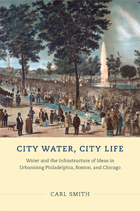 City Water, City Life: Water and the Infrastructure of Ideas in Urbanizing Philadelphia, Boston, and Chicago
Carl Smith
University of Chicago Press, 2013 A city is more than a massing of citizens, a layout of buildings and streets, or an arrangement of political, economic, and social institutions. It is also an infrastructure of ideas that are a support for the beliefs, values, and aspirations of the people who created the city. In City Water, City Life, celebrated historian Carl Smith explores this concept through an insightful examination of the development of the first successful waterworks systems in Philadelphia, Boston, and Chicago between the 1790s and the 1860s. By examining the place of water in the nineteenth-century consciousness, Smith illuminates how city dwellers perceived themselves during the great age of American urbanization. But City Water, City Life is more than a history of urbanization. It is also a refreshing meditation on water as a necessity, as a resource for commerce and industry, and as an essential—and central—part of how we define our civilization.
The City We Make Together: City Council Meeting's Primer for Participation
Mallory Catlett
University of Iowa Press, 2022 In 2009, theatre artist Aaron Landsman was dragged by a friend to a city council meeting in Portland, Oregon. At first he was bored, but when a citizen dumped trash in front of the council in order to show how the city needed cleaning up, he was intrigued. He began attending local government meetings across the country, interviewing council members, staffers, activists, and other citizens. Out of this investigation, Landsman and director Mallory Catlett developed a participatory theatre piece called City Council Meeting.
The City We Make Together looks at how we make art with communities, how we perform power and who gets to play which roles, and how we might use creativity and rigorous inquiry to look at our structures of democracy anew.
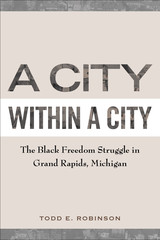 A City within a City: The Black Freedom Struggle in Grand Rapids, Michigan
Todd E Robinson
Temple University Press, 2012 A City within a City examines the civil rights movement in the North by concentrating on the struggles for equality in Grand Rapids, Michigan. Historian Todd Robinson studies the issues surrounding school integration and bureaucratic reforms as well as the role of black youth activism to detail the diversity of black resistance. He focuses on respectability within the African American community as a way of understanding how the movement was formed and held together. And he elucidates the oppositional role of northern conservatives regarding racial progress.
A City within a City cogently argues that the post-war political reform championed by local Republicans transformed the city's racial geography, creating a racialized "city within a city," featuring a system of "managerial racism" designed to keep blacks in declining inner-city areas. As Robinson indicates, this bold, provocative framework for understanding race relations in Grand Rapids has broader implications for illuminating the twentieth-century African American urban experience in secondary cities.
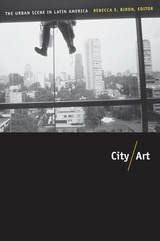 City/Art: The Urban Scene in Latin America
Rebecca E. Biron , ed.
Duke University Press, 2009 In City/Art, anthropologists, literary and cultural critics, a philosopher, and an architect explore how creative practices continually reconstruct the urban scene in Latin America. The contributors, all Latin Americanists, describe how creativity—broadly conceived to encompass urban design, museums, graffiti, film, music, literature, architecture, performance art, and more—combines with nationalist rhetoric and historical discourse to define Latin American cities. Taken together, the essays model different ways of approaching Latin America’s urban centers not only as places that inspire and house creative practices but also as ongoing collective creative endeavors themselves. The essays range from an examination of how differences of scale and point of view affect people’s experience of everyday life in Mexico City to a reflection on the transformation of a prison into a shopping mall in Uruguay, and from an analysis of Buenos Aires’s preoccupation with its own status and cultural identity to a consideration of what Miami means to Cubans in the United States. Contributors delve into the aspirations embodied in the modernist urbanism of Brasília and the work of Lotty Rosenfeld, a Santiago performance artist who addresses the intersections of art, urban landscapes, and daily life. One author assesses the political possibilities of public art through an analysis of subway-station mosaics and Julio Cortázar’s short story “Graffiti,” while others look at the representation of Buenos Aires as a “Jewish elsewhere” in twentieth-century fiction and at two different responses to urban crisis in Rio de Janeiro. The collection closes with an essay by a member of the São Paulo urban intervention group Arte/Cidade, which invades office buildings, de-industrialized sites, and other vacant areas to install collectively produced works of art. Like that group, City/Art provides original, alternative perspectives on specific urban sites so that they can be seen anew. Contributors. Hugo Achugar, Rebecca E. Biron, Nelson Brissac Peixoto, Néstor García Canclini, Adrián Gorelik, James Holston, Amy Kaminsky, Samuel Neal Lockhart, José Quiroga, Nelly Richard, Marcy Schwartz, George Yúdice
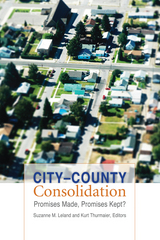 City–County Consolidation: Promises Made, Promises Kept?
Suzanne M. Leland and Kurt Thurmaier, Editors
Georgetown University Press, 2010 Although a frequently discussed reform, campaigns to merge a major municipality and county to form a unified government fail to win voter approval eighty per cent of the time. One cause for the low success rate may be that little systematic analysis of consolidated governments has been done. In City–County Consolidation, Suzanne Leland and Kurt Thurmaier compare nine city–county consolidations—incorporating data from 10 years before and after each consolidation—to similar cities and counties that did not consolidate. Their groundbreaking study offers valuable insight into whether consolidation meets those promises made to voters to increase the efficiency and effectiveness of these governments. The book will appeal to those with an interest in urban affairs, economic development, local government management, general public administration, and scholars of policy, political science, sociology, and geography.
 The Cityscapes of Taipei, Hong Kong, and Singapore during the Cold War
Tze-ki Hon
Amsterdam University Press, 2025 This volume presents a comparative analysis of three key cities—Hong Kong, Singapore, and Taipei—during the Cold War. Strategically positioned within international trade networks, these cities also served as critical nodes for both regional conflicts and cooperation. The comparison primarily focuses on their urban landscapes, drawing on the memories embedded in their collective memoryscapes, the imagery presented in their filmscapes, and the perceptions of their inhabitants, as reflected in fiction and films that portrayed urban life and the experiences of ordinary people.
The Cityscapes of Taipei, Hong Kong, and Singapore during the Cold War explores both the shared characteristics of these cities as frontiers in the bipolar global system (divided between Communism and the Free World) and their distinctive features as unique spaces shaped by their own meanings and opportunities.
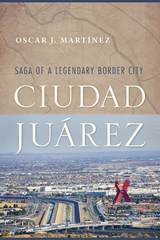 Ciudad Juárez: Saga of a Legendary Border City
Oscar J. Martínez
University of Arizona Press, 2018 Juárez is no ordinary city. Its history is exhilarating and tragic. Part of the state of Chihuahua and located on the border with the United States opposite El Paso, Texas, Juárez has often captured the world’s attention in dramatic fashion.
In Ciudad Juárez: Saga of a Legendary Border City, Oscar J. Martínez provides a historical overview of the economic and social evolution of this famous transnational urban center from the 1848 creation of the international boundary between Mexico and the United States to the present, emphasizing the city’s deep ties to the United States.
Martínez also explores major aspects of the social history of the city, including cross-border migration, urbanization, population growth, living standards, conditions among the city’s workers, crime, and the circumstances that led to the horrendous violence that catapulted Juárez to the top rung of the world’s most violent urban areas in the early twenty-first century.
In countless ways, the history of Juárez is the history of the entire Mexican northern frontier. Understanding how the city evolved provides a greater appreciation for the formidable challenges faced by Mexican fronterizos and yields vital insights into the functioning of borderland regions around the world.
 Ciudad Real, 1500–1750: Growth, Crisis, and Readjustment in the Spanish Economy
Carla Rahn Phillips
Harvard University Press, 1979 "At its peak in the late sixteenth century," this history begins, "Spain controlled the first empire upon which the sun never set and exercised a tremendous influence in European affairs. By 1600, thoughtful Spaniards knew that something had gone terribly wrong, and by 1650 the rest of Europe knew it too."
By focusing on one Castilian city, Ciudad Real, Carla Rahn Phillips seeks to shed light on the mysterious downfall of Spanish power. Looking first at the general history of the city and region, she goes on to examine population, agriculture, industry, taxation, and elite patterns of investment. She shows how Ciudad Real's economy grew from about 1500 to 1580, faltered and stagnated through most of the seventeenth century, and reestablished a subsistence economy around 1750. Self-contained though Ciudad Real was, its history illuminates economic and social change during Spain's Golden Age.
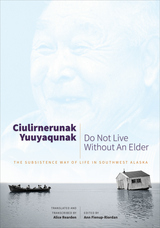 Ciulirnerunak Yuuyaqunak/Do Not Live Without an Elder: The Subsistence Way of Life in Southwest Alaska
Edited by Ann Fienup-Riordan
University of Alaska Press, 2016 In October of 2010, six men who were serving on the board of the Calista Elders Council (CEC) gathered in Anchorage with CEC staff to spend three days speaking about the subsistence way of life. The men shared stories of their early years growing up on the land and harvesting through the seasons, and the dangers they encountered there. The gathering was striking for its regional breadth, as elders came from the Bering Sea coast as well as the Yukon and Kuskokwim rivers. And while their accounts had some commonalities, they also served to demonstrate the wide range of different approaches to subsistence in different regions.
This book gathers the men’s stories for the current generation and those to come. Taken together, they become more than simply oral histories—rather, they testify to the importance of transmitting memories and culture and of preserving knowledge of vanishing ways of life.
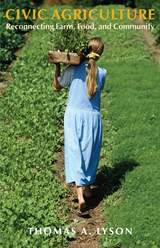 Civic Agriculture: Reconnecting Farm, Food, and Community
Thomas A. Lyson
University Press of New England, 2004 While the American agricultural and food systems follow a decades-old path of industrialization and globalization, a counter trend has appeared toward localizing some agricultural and food production. Thomas A. Lyson, a scholar-practitioner in the field of community-based food systems, calls this rebirth of locally based agriculture and food production civic agriculture because these activities are tightly linked to a community’s social and economic development. Civic agriculture embraces innovative ways to produce, process, and distribute food, and it represents a sustainable alternative to the socially, economically, and environmentally destructive practices associated with conventional large-scale agriculture. Farmers’ markets, community gardens, and community-supported agriculture are all forms of civic agriculture. Lyson describes how, in the course of a hundred years, a small-scale, diversified system of farming became an industrialized system of production and also how this industrialized system has gone global. He argues that farming in the United States was modernized by employing the same techniques and strategies that transformed the manufacturing sector from a system of craft production to one of mass production. Viewing agriculture as just another industrial sector led to transformations in both the production and the processing of food. As small farmers and food processors were forced to expand, merge with larger operations, or go out of business, they became increasingly disconnected from the surrounding communities. Lyson enumerates the shortcomings of the current agriculture and food systems as they relate to social, economic, and environmental sustainability. He then introduces the concept of community problem solving and offers empirical evidence and concrete examples to show that a re-localization of the food production system is underway.
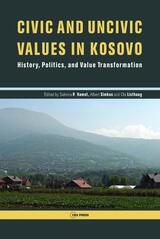 Civic and Uncivic Values in Kosovo: History, Politics, and Value Transformation
Albert Simkus
Central European University Press, 2015 This volume is driven by the conviction that the key to the establishment of stable liberal democracy anywhere in the world and, in this case, in Kosovo lies in the completion of three interrelated tasks: first, the creation of effective political institutions, based on the principle of the separation of powers (including the independence of the judiciary); second, the promotion of the rule of law; and, third, the promotion of civic values, including tolerance or ethnic/religious/sexual minorities, trust, and respect for the harm principle. In fact, there are problems across all three measures, including with judicial independence, with the rule of law, and with civic values. On the last of these, research findings show that the citizens of Kosovo rank extremely low on trust of other citizens, low on engagement in social organizations, and tolerance of gays, lesbians, and atheists, but high on trust in the political institutions of their country and in pride of their newly independent state.
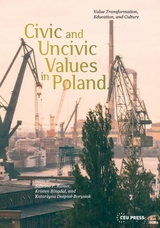 Civic and Uncivic Values in Poland: Value Transformation, Education, and Culture
Kristen Ringdal
Central European University Press, 2019 Poland, like many societies across the world, is becoming more polarized in diverse areas of life, as contending forces seek to advance incompatible agendas. The polarization over values in Polish politics was evident already before communism collapsed but became more obvious in the following years and reached a crescendo after the October 2015 parliamentary elections, which brought a right-wing party into power. This volume focuses on the years since 1989, looking at the clash between civic values (the rule of law, individual rights, tolerance, respect for the harm principle, equality, and neutrality of the state in matters of religion) and uncivic values (the rule of a dictator or dictatorial party, contempt for individual rights, bigotry, disrespect for the harm principle, unequal treatment of people whether through discrimination or through exploitation, and state favoritism of one religion over others). The authors address voting behavior, political parties, anti-Semitism, homophobia, the role of the Catholic Church, and reflections in history textbooks, fi lm, and even rock music. This volume makes clear that for the foreseeable future the conflict in Poland between traditional, conservative values and liberal, civic values is likely to continue, provoking tensions and protests.
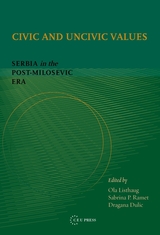 Civic and Uncivic Values: Serbia in the Post-Miloševic Era
Dragana Dulic
Central European University Press, 2011 Discusses Serbia’s struggle for democratic values after the fall of the Miloševic regime provoked by the NATO war, and after the trauma caused by the secession of Kosovo. Are the value systems of the post-Miloševic era true stumbling blocks of a delayed transition of this country? Seventeen contributors from Norway, Serbia, Italy, Germany, Poland and some other European countries covered a broad range of topics in order to provide answers to this question. The subjects of their investigations were national myths and symbols, history textbooks, media, film, religion, inter-ethnic dialogue, transitional justice, political party agendas and other related themes. The authors of the essays represent different scholarly disciplines whose theoretical conceptions and frameworks are employed in order to analyze two alternative value systems in Serbia: liberal, cosmopolitan and civic on the one hand, and traditional, provincial, nationalist on the other.
 Civic Charity in a Golden Age: ORPHAN CARE IN EARLY MODERN AMSTERDAM
Anne E. C. McCants
University of Illinois Press, 1997 Using the Amsterdam Municipal Orphanage as a window through which readers
can see the start of profound social and economic changes in early modern
Amsterdam, Civic Charity in a Golden Age explores the connections
between the developing capitalist economy, the functioning of the government,
and the provision of charitable services to orphans in Amsterdam during
the seventeenth and eighteenth centuries, the period of the city's greatest
prosperity and subsequent decline.
Anne McCants skillfully interprets details of the orphanage's expenditures,
especially for food; its population; the work records of those who were
reared there; and the careers of the regents who oversaw it. The establishment
of the orphanage itself was called for by the changing economic needs
of rapidly expanding commercial centers and the potential instability
of a government that depended on taxes from a large, politically powerless
segment of the population.
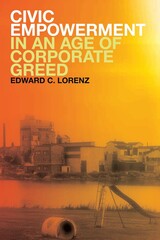 Civic Empowerment in an Age of Corporate Greed
Edward C. Lorenz
Michigan State University Press, 2012 A thought-provoking investigation of an urgent issue facing American communities today, Edward C. Lorenz’s book examines the intersection of corporate irresponsibility and civic engagement. At the heart of this case study is a group of firms responsible for seven of the most contaminated Superfund sites in the United States, the largest food contamination accident in U.S. history, stunning stock and financial manipulations, and a massive shift of jobs off shore. In the face of these egregious environmental, employee, and investor abuses, several communities impacted by these firms organized to confront and combat failures in corporate and bureaucratic leadership, winning notable victories over major financiers, lobbyists, and indifferent or ineffective government agencies. A critical analysis of public and private leadership, business and economic ethics, and civic life, this book concludes with a stirring blueprint for other communities facing similarly overwhelming opposition.
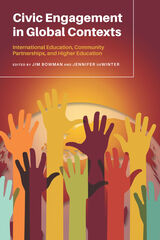 Civic Engagement in Global Contexts: International Education, Community Partnerships, and Higher Education
Jim Bowman
Utah State University Press, 2021 This volume examines the role of writing, rhetoric, and literacy programs and approaches in the practice of civic engagement in global contexts. Writing programs have experience in civic engagement and service learning projects in their local communities, and their work is central to developing students’ literacy practices. Further, writing programs compel student writers to attend to audience needs and rhetorical exigencies as well as reflect on their own subject positions. Thus, they are particularly situated to partner with other units on college campuses engaged in global partnerships.
Civic Engagement in Global Contexts provides examples and evidence of the critical self-reflection and iteration with community partners that make these projects important and valuable. Throughout its thirteen chapters, this collection provides practical pedagogical and administrative approaches for writing studies faculty engaging with global learning projects, as well as nuanced insight into how to navigate contact zones from the planning stages of projects to the hard work of self-reflection and change.
Partnerships and projects across national borders compel the field of rhetoric and composition to think through the ethics of writing studies program design and teaching practices. Doing this difficult work can disrupt presumptive notions of ownership that faculty and administrators hold concerning the fields involved in these projects and can even lead to decentering rhetoric/composition and other assumptions held by US-based institutions of higher education. Civic Engagement in GlobalContexts will be useful to instructors, advisors, and project managers of students in faculty-led project learning in overseas settings, international service learning through foreign study programs, and foreign study itself and to faculty members introducing civic engagement and community-based learning projects with foreign students in overseas institutions.
Contributors: Olga Aksakalova, James Austin, Maria de Lourdes Caudillo Zambrano, Rebecca Charry Roje, Patricia M. Dyer, Tara E. Friedman, Bruce Horner, Kathryn Johnson Gindlesparger, Adela C. Licona, Ian Mauer, Joyce Meier, Susan V. Meyers, Sadia Mir, Stephen T. Russell
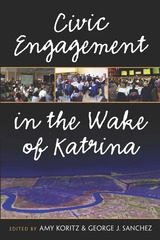 Civic Engagement in the Wake of Katrina
Amy Koritz and George J. Sanchez, editors
University of Michigan Press, 2009 "Civic engagement has been underrated and overlooked. Koritz and Sanchez illuminate the power of what community engagement through art and culture revitalization can do to give voice to the voiceless and a sense of being to those displaced."
---Sonia BasSheva Mañjon, Wesleyan University "This profound and eloquent collection describes and assesses the new coalitions bringing a city back to life. It's a powerful call to expand our notions of culture, social justice, and engaged scholarship. I'd put this on my 'must read' list."
---Nancy Cantor, Syracuse University "Civic Engagement in the Wake of Katrina is a rich and compelling text for thinking about universities and the arts amid social crisis. Americans need to hear the voices of colleagues who were caught in Katrina's wake and who responded with commitment, creativity, and skill."
---Peter Levine, CIRCLE (The Center for Information & Research on Civic Learning & Engagement) This collection of essays documents the ways in which educational institutions and the arts community responded to the devastation wrought by Hurricane Katrina. While firmly rooted in concrete projects, Civic Engagement in the Wake of Katrina also addresses the larger issues raised by committed public scholarship. How can higher education institutions engage with their surrounding communities? What are the pros and cons of "asset-based" and "outreach" models of civic engagement? Is it appropriate for the private sector to play a direct role in promoting civic engagement? How does public scholarship impact traditional standards of academic evaluation? Throughout the volume, this diverse collection of essays paints a remarkably consistent and persuasive account of arts-based initiatives' ability to foster social and civic renewal. Amy Koritz is Director of the Center for Civic Engagement and Professor of English at Drew University. George J. Sanchez is Professor of American Studies and Ethnicity and History at the University of Southern California. Front and rear cover designs, photographs, and satellite imagery processing by Richard Campanella. digitalculturebooks is an imprint of the University of Michigan Press and the Scholarly Publishing Office of the University of Michigan Library dedicated to publishing innovative and accessible work exploring new media and their impact on society, culture, and scholarly communication. Visit the website at www.digitalculture.org.
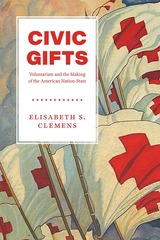 Civic Gifts: Voluntarism and the Making of the American Nation-State
Elisabeth S. Clemens
University of Chicago Press, 2020 In Civic Gifts, Elisabeth S. Clemens takes a singular approach to probing the puzzle that is the United States. How, she asks, did a powerful state develop within an anti-statist political culture? How did a sense of shared nationhood develop despite the linguistic, religious, and ethnic differences among settlers and, eventually, citizens? Clemens reveals that an important piece of the answer to these questions can be found in the unexpected political uses of benevolence and philanthropy, practices of gift-giving and reciprocity that coexisted uneasily with the self-sufficient independence expected of liberal citizens Civic Gifts focuses on the power of gifts not only to mobilize communities throughout US history, but also to create new forms of solidarity among strangers. Clemens makes clear how, from the early Republic through the Second World War, reciprocity was an important tool for eliciting both the commitments and the capacities needed to face natural disasters, economic crises, and unprecedented national challenges. Encompassing a range of endeavors from the mobilized voluntarism of the Civil War, through Community Chests and the Red Cross to the FDR-driven rise of the March of Dimes, Clemens shows how voluntary efforts were repeatedly articulated with government projects. The legacy of these efforts is a state co-constituted with, as much as constrained by, civil society.
 Civic Gifts: Voluntarism and the Making of the American Nation-State
Elisabeth S. Clemens
University of Chicago Press, 2020 This is an auto-narrated audiobook version of this book.
In Civic Gifts, Elisabeth S. Clemens takes a singular approach to probing the puzzle that is the United States. How, she asks, did a powerful state develop within an anti-statist political culture? How did a sense of shared nationhood develop despite the linguistic, religious, and ethnic differences among settlers and, eventually, citizens? Clemens reveals that an important piece of the answer to these questions can be found in the unexpected political uses of benevolence and philanthropy, practices of gift-giving and reciprocity that coexisted uneasily with the self-sufficient independence expected of liberal citizens Civic Gifts focuses on the power of gifts not only to mobilize communities throughout US history, but also to create new forms of solidarity among strangers. Clemens makes clear how, from the early Republic through the Second World War, reciprocity was an important tool for eliciting both the commitments and the capacities needed to face natural disasters, economic crises, and unprecedented national challenges. Encompassing a range of endeavors from the mobilized voluntarism of the Civil War, through Community Chests and the Red Cross to the FDR-driven rise of the March of Dimes, Clemens shows how voluntary efforts were repeatedly articulated with government projects. The legacy of these efforts is a state co-constituted with, as much as constrained by, civil society.
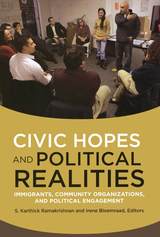 Civic Hopes and Political Realities: Immigrants, Community Organizations, and Political Engagement
S. Karthick Ramakrishnan
Russell Sage Foundation, 2008 For many Americans, participation in community organizations lays the groundwork for future political engagement. But how does this traditional model of civic life relate to the experiences of today's immigrants? Do community organizations help immigrants gain political influence in their neighborhoods and cities? In Civic Hopes and Political Realities, experts from a wide range of disciplines explore the way civic groups across the country and around the world are shaping immigrants' quest for political effectiveness. Civic Hopes and Political Realities shows that while immigrant organizations play an important role in the lives of members, their impact is often compromised by political marginalization and a severe lack of resources. S. Karthick Ramakrishnan and Irene Bloemraad examine community organizations in six cities in California and find that even in areas with high rates of immigrant organizing, policymakers remain unaware of local ethnic organizations. Looking at new immigrant destinations, Kristi Andersen finds that community organizations often serve as the primary vehicle for political incorporation—a role once played by the major political parties. Floris Vermeulen and Maria Berger show how policies in two European cities lead to very different outcomes for ethnic organizations. Amsterdam's more welcoming multicultural policies help immigrant community groups attain a level of political clout that similar organizations in Berlin lack. Janelle Wong, Kathy Rim, and Haven Perez report on a study of Latino and Asian American evangelical churches. While the church shapes members' political views on issues such as abortion and same-sex marriage, church members may also question the evangelical movement's position on such issues as civil rights and immigration. Els de Graauw finds that many non-profit organizations without explicitly political agendas nonetheless play a crucial role in advancing the political interests of their immigrant members. Recent cuts in funding for such organizations, she argues, block not only the provision of key social services, but also an important avenue for political voice. Looking at community organizing in a suburban community, Sofya Aptekar finds that even when immigrant organizations have considerable resources and highly educated members, they tend to be excluded from town politics. Some observers worry that America's increasing diversity is detrimental to civic life and political engagement. Civic Hopes and Political Realities boldly advances an alternative understanding of the ways in which immigrants are enriching America's civic and political realms—even in the face of often challenging circumstances.
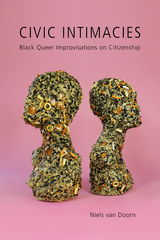 Civic Intimacies: Black Queer Improvisations on Citizenship
Niels van Doorn
Temple University Press, 2019 Black queer lives often exist outside conventional civic institutions and therefore have to explore alternative intimacies to experience a sense of belonging. Civic Intimacies examines how—and to what extent—these different forms of intimacy catalyze the values, aspirations, and collective flourishing of Black queer denizens of Baltimore. Niels van Doorn draws on 18 months of immersive ethnographic fieldwork for his innovative cross-disciplinary analysis of contemporary debates in political and cultural theory. Van Doorn describes the way that these systematically marginalized communities improvise on citizenship not just to survive but also to thrive despite the proliferation of violence and insecurity in their lives. By reimagining citizenship as the everyday reparative work of building support structures, Civic Intimacies highlights the extent to which sex, kinship, memory, religious faith, and sexual health are rooted in collective practices that are deeply political. These systems sustain the lives of Black queer Baltimoreans who find themselves stuck in a city they cannot give up on—even though it has in many ways given up on them.
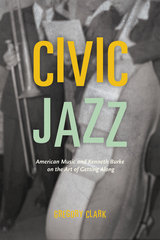 Civic Jazz: American Music and Kenneth Burke on the Art of Getting Along
Gregory Clark
University of Chicago Press, 2015 Jazz is born of collaboration, improvisation, and listening. In much the same way, the American democratic experience is rooted in the interaction of individuals. It is these two seemingly disparate, but ultimately thoroughly American, conceits that Gregory Clark examines in Civic Jazz. Melding Kenneth Burke’s concept of rhetorical communication and jazz music’s aesthetic encounters with a rigorous sort of democracy, this book weaves an innovative argument about how individuals can preserve and improve civic life in a democratic culture.
Jazz music, Clark argues, demonstrates how this aesthetic rhetoric of identification can bind people together through their shared experience in a common project. While such shared experience does not demand agreement—indeed, it often has an air of competition—it does align people in practical effort and purpose. Similarly, Clark shows, Burke considered Americans inhabitants of a persistently rhetorical situation, in which each must choose constantly to identify with some and separate from others. Thought-provoking and path-breaking, Clark’s harmonic mashup of music and rhetoric will appeal to scholars across disciplines as diverse as political science, performance studies, musicology, and literary criticism.
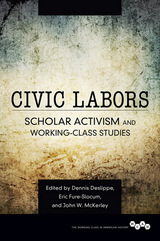 Civic Labors: Scholar Activism and Working-Class Studies
Edited by Dennis Deslippe, Eric Fure-Slocum, and John W. McKerley
University of Illinois Press, 2016 Labor studies scholars and working-class historians have long worked at the crossroads of academia and activism. The essays in this collection examine the challenges and opportunities for engaged scholarship in the United States and abroad. A diverse roster of contributors discuss how participation in current labor and social struggles guides their campus and community organizing, public history initiatives, teaching, mentoring, and other activities. They also explore the role of research and scholarship in social change, while acknowledging that intellectual labor complements but never replaces collective action and movement building. Contributors: Kristen Anderson, Daniel E. Atkinson, James R. Barrett, Susan Roth Breitzer, Susan Chandler, Sam Davies, Dennis Deslippe, Eric Fure-Slocum, Colin Gordon, Michael Innis-Jiménez, Stephanie Luce, Joseph A. McCartin, John W. McKerley, Matthew M. Mettler, Stephen Meyer, David Montgomery, Kim E. Nielsen, Peter Rachleff, Ralph Scharnau, Jennifer Sherer, Shelton Stromquist, Emily E. LB. Twarog, and John Williams-Searle.
 Civic Longing: The Speculative Origins of U.S. Citizenship
Carrie Hyde
Harvard University Press, 2018 Citizenship defines the U.S. political experiment, but the modern legal category that it now names is a relatively recent invention. There was no Constitutional definition of citizenship until the ratification of the Fourteenth Amendment in 1868, almost a century after the Declaration of Independence. Civic Longing looks at the fascinating prehistory of U.S. citizenship in the years between the Revolution and the Civil War, when the cultural and juridical meaning of citizenship—as much as its scope—was still up for grabs. Carrie Hyde recovers the numerous cultural forms through which the meaning of citizenship was provisionally made and remade in the early United States.
Civic Longing offers the first historically grounded account of the formative political power of the imaginative traditions that shaped early debates about citizenship. In the absence of a centralized legal definition of citizenship, Hyde shows, politicians and writers regularly turned to a number of highly speculative traditions—political philosophy, Christian theology, natural law, fiction, and didactic literature—to authorize visions of what citizenship was or ought to be. These speculative traditions sustained an idealized image of citizenship by imagining it from its outer limits, from the point of view of its “negative civic exemplars”—expatriates, slaves, traitors, and alienated subjects.
By recovering the strange, idiosyncratic meanings of citizenship in the early United States, Hyde provides a powerful critique of originalism, and challenges anachronistic assumptions that read the definition of citizenship backward from its consolidation in the mid-nineteenth century as jus soli or birthright citizenship.
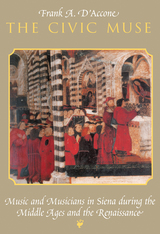 The Civic Muse: Music and Musicians in Siena during the Middle Ages and the Renaissance
Frank A. D'Accone
University of Chicago Press, 1997 Siena, blessed with neither the aristocratic nor the ecclesiastical patronage enjoyed by music in other northern Italian centers like Florence, nevertheless attracted first-rate composers and performers from all over Europe. As Frank A. D'Accone shows in this scrupulously documented study, policies developed by the town to favor the common good formed the basis of Siena's ambitious musical programs.
Based on decades of research in the town's archives, D'Accone's The Civic Muse brilliantly illuminates both the sacred and the secular aspects of more than three centuries of music and music-making in Siena. After detailing the history of music and liturgy at Siena's famous cathedral and of civic music at the Palazzo Pubblico, D'Accone describes the crucial role that music played in the daily life of the town, from public festivities for foreign dignitaries to private musical instruction. Putting Siena squarely on the Renaissance musical map, D'Accone's monumental study will interest both musicologists and historians of the Italian Renaissance.
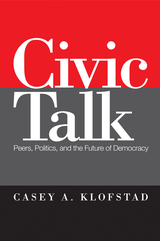 Civic Talk: Peers, Politics, and the Future of Democracy
Authored by Casey A. Klofstad
Temple University Press, 2011 Does talking about civic issues encourage civic participation? In his innovative book, Civic Talk, Casey Klofstad shows that our discussions about politics and current events with our friends, colleagues, and relatives—"civic talk"—has the ability to turn thought into action—from voting to volunteering in civic organizations. Klofstad’s path breaking research is the first to find evidence of a causal relationship between the casual chatting and civic participation. He employs survey information and focus groups consisting of randomly assigned college freshman roommates to show this behavior in action. Klofstad also illustrates how civic talk varies under different circumstances and how the effects can last years into the future. Based on these findings, Klofstad contends that social context plays a central role in maintaining the strength of democracy. This conclusion cuts against the grain of previous research, which primarily focuses on individual-level determinants of civic participation, and negates social-level explanations.
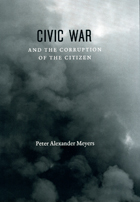 Civic War and the Corruption of the Citizen
Peter Alexander Meyers
University of Chicago Press, 2008 In this unique book, Peter Alexander Meyers leads us through the social processes by which shock incites terror, terror invites war, war invokes emergency, and emergency supports unchecked power. He then reveals how the domestic political culture created by the Cold War has driven these developments forward since 9/11, contending that our failure to acknowledge that this Cold War continues today is precisely what makes it so dangerous. With eloquence and urgency Meyers argues that the mantra of our time—“everything changed on 9/11!”—is false and pernicious. By contrast, Civic War and the Corruption of the Citizen provides a novel account of long-term transformations in the citizen’s experience of war, the constitution of political powers, and public uses of communication, and from that firm historical basis explains how a convergence of these social facts became the pretext for unprecedented opportunism and irresponsibility after 9/11. Where others have observed that our rights are under attack, Meyers digs deeper and finds that today “government by the people” itself is at risk. Sparkling with historical and philosophical insight, this is a dramatic diagnosis of the American political scene that at once makes clear the new position of the citizen and the necessity for active citizenship if democracy is to endure.
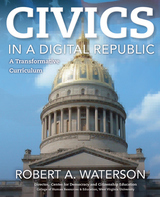 Civics in a Digital Republic: A Transformative Curriculum
Robert A. Waterson
West Virginia University Press, 2012 This innovative curriculum book provides key materials, resources, and tools to help secondary educators prepare their students to be engaged citizens of their community, state, nation and world. Five complete units of instruction, based on West Virginia Content Standards and Objectives, provide meaningful lessons while being mindful of the transition from tangible text to more digital curricula: •Rights of the Individual •Freedoms of the Individual •Responsibilities of the Individual •Beliefs Concerning Societal Conditions •Financial Literacy Additional features of the curriculum include: •24 lessons that provide specific teaching and learning strategies •4 culminating activities for enrichment opportunities •A matrix illustrating the West Virginia Content Standards and Objectives covered •A matrix illustrating compliance with the National Council for the Social Studies Standards •A curriculum toolbox that provides over 70 engaging web sites to visit and explore.
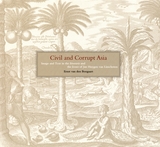 Civil and Corrupt Asia: Image and Text in the Itinerario and the Icones of Jan Huygen Van Linschoten
Ernst van den Boogaart
University of Chicago Press, 2003 Jan Huygen van Linschoten (1562-1611) was a Dutchman who, in 1596, penned the famous Itinerario, an account of his travel to the Indian Peninsula and its eastern surroundings that described the inhabitants of this vast region and quickly became a travel guide for everyone going there. Van Linschoten is held as a key eyewitness of the Portuguese-Asian empire at its height, and as one who worked to shift the center of European expansion from the Iberian peninsula and Italy to the Netherlands and England. In 1604 he published an abridged version, the Icones et Habitus Indorum, which contained 36 of the engravings from the Itinerario together with Latin captions.
Divine and Spoiled Asia reproduces these engravings and their captions (in English), together with an extensive analysis of them by historian Ernst van den Boogaart. In addition to providing unparalleled insights into early modern European views of the East, the engravings also contain valuable depictions of the peoples, customs, and flora and fauna of late sixteenth-century India and neighboring countries.
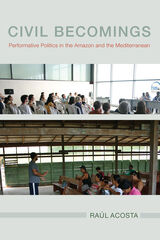 Civil Becomings: Performative Politics in the Amazon and the Mediterranean
Raúl Acosta
University of Alabama Press, 2020 An anthropological approach to an emerging form of transnational political engagement by independent civil society organizations
Activism and advocacy have drawn academic interest as alternative ways of achieving collective ends outside established political institutions. However, there has been very little theoretical attention aimed at the interconnections between the two spheres. In Civil Becomings: Performative Politics in the Amazon and the Mediterranean, Raúl Acosta examines the manner in which progressive nongovernmental organizations (NGOs) and activists act in a more intermingled and processual way than scholars have previously acknowledged.
Acosta focuses on networks from the vantage point of two NGOs: one in Brazil that concentrated on environmental issues in the Amazon and another in Barcelona called the Mediterranean Social Forum. The focus of this research is not on organizational aspects of collaboration, but rather on the practices and contexts in which such cooperation occurs. Three major aspects of activist and advocacy networks are analyzed: their communicative characters, their collective performances of the political, and the negotiations they engage in between vernacular and cosmopolitan values.
This volume theorizes the cooperative actions of activist and advocacy networks as legitimating processes for the work of participating groups. In doing so, Acosta argues, they address the issues that justify a joint campaign or effort and also crucially underpin each participating collective as a worthy organization of civil society.
Civil Bound
Myung Mi Kim
Omnidawn, 2019 In Civil Bound, Myung Mi Kim turns a keen ear to language as the mechanism by which society operates. The poems engage multiple methods to make sense of this pervasive tool, its powers, nuances, and influences over the structure of our civilizations. Through investigations of ecology, capitalism, military powers, colonialism, and supremacy, the book uncovers patterns in the ways that language is active in perpetuating inequality and binding its subjects to the will of those in positions of authority. In questioning systems of oppression, the poems also offer the hope of forging new paths through the connecting power of language. Examining our participation in social contracts, communal goals, and human desires, Kim’s poems encourage us to salvage language as a means of connection that binds us in respect and commitment to our fellow human beings.
The Civil Code Controversy in Meiji Japan
Michal A. Piegzik
Leiden University Press, 2024 'The Civil Code Controversy in Meiji Japan' outlines the dramatic history of the failed liberalization of Japanese private law during the Meiji era.
 Civil Disagreement: Personal Integrity in a Pluralistic Society
Edward Langerak
Georgetown University Press, 2016 How can we agree to disagree in today’s pluralistic society, one in which individuals and groups are becoming increasingly polarized by fierce convictions that are often at odds with the ideas of others? Civil Disagreement: Personal Integrity in a Pluralistic Society shows how we can cope with diversity and be appropriately open toward opponents even while staying true to our convictions. This accessible and useful guide discusses how our conversations and arguments can respect differences and maintain personal integrity and civility even while taking stances on disputed issues. The author examines an array of illustrative cases, such as debates over slavery, gay marriage, compulsory education for the Amish, and others, providing helpful insights on how to take firm stands without denigrating opponents. The author proposes an approach called “perspective pluralism” that honors the integrity of various viewpoints while avoiding the implication that all reasonable views are equally acceptable or true. Civil Disagreement offers a concise yet comprehensive guide for students and scholars of philosophical or religious ethics, political or social philosophy, and political science, as well as general readers who are concerned about the polarization that often seems to paralyze national and international politics.
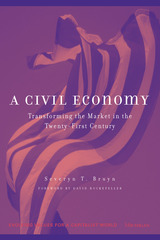 A Civil Economy: Transforming the Marketplace in the Twenty-First Century
Severyn T. Bruyn
University of Michigan Press, 2000 A civil society is one in which a democratic government and a market economy operate together. The idea of the civil economy--encompassing a democratic government and a market economy--presumes that people can solve social problems within the market itself. This book explores the relationship between the two, examining the civil underpinnings of capitalism and investigating the way a civil economy evolves in history and is developed for the future by careful planning.
Severyn T. Bruyn describes how people in three sectors--government, business, and the Third Sector (nonprofits and civil groups)--can develop an accountable, self-regulating, profitable, humane, and competitive system of markets that could be described as a civil economy. He examines how government officials can organize markets to reduce government costs; how local leaders deal with global corporations that would unfairly exploit their community resources; and how employees can become coparticipants in the development of human values in markets.
A Civil Economy is oriented to interdiciplinary studies of the economy, assisting scholars in diverse fields, such as business management, sociology, political science, and economics, in developing a common language to examine civic problems in the marketplace.
As an undergraduate text, it evokes a mode of thought about the development of a self-accountable system of markets. Students learn to understand how the market economy becomes socially accountable and self-reliant, while remaining productive, competitive, and profitable.
Sveryn T. Bruyn is Professor of Sociology, Boston College.
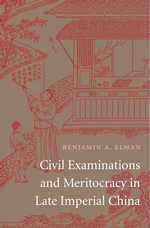 Civil Examinations and Meritocracy in Late Imperial China
Benjamin A. Elman
Harvard University Press, 2013 During China's late imperial period (roughly 1400-1900 CE), men would gather by the millions every two or three years outside official examination compounds sprinkled across China. Only one percent of candidates would complete the academic regimen that would earn them a post in the administrative bureaucracy. Civil Examinations assesses the role of education, examination, and China's civil service in fostering the world's first professional class based on demonstrated knowledge and skill.
While millions of men dreamed of the worldly advancement an imperial education promised, many more wondered what went on inside the prestigious walled-off examination compounds. As Benjamin A. Elman reveals, what occurred was the weaving of a complex social web. Civil examinations had been instituted in China as early as the seventh century CE, but in the Ming and Qing eras they were the nexus linking the intellectual, political, and economic life of imperial China. Local elites and members of the court sought to influence how the government regulated the classical curriculum and selected civil officials. As a guarantor of educational merit, civil examinations served to tie the dynasty to the privileged gentry and literati classes--both ideologically and institutionally.
China did away with its classical examination system in 1905. But this carefully balanced and constantly contested piece of social engineering, worked out over the course of centuries, was an early harbinger of the meritocratic regime of college boards and other entrance exams that undergirds higher education in much of the world today.
 Civil Movements in an Illiberal Regime: Political Activism in Hungary
Dániel Mikecz
Central European University Press, 2023 Dániel Mikecz addresses in this study the tensions between oppositional civil society and party-political actors. As successive elections demonstrate the increasing confidence of the illiberal regime of Viktor Orbán, left and liberal parties of the opposition have faced a prolonged crisis in credibility. At the same time, the civil society has not been immobile, and bottom-up initiatives, social and political movements, and non-governmental organizations have gained momentum in the public sphere. The ruling power is also active in the extra-parliamentary political arena. Through national consultations, Peace Marches, and other means, Orbán’s governing Fidesz party has mobilized voters outside of election campaigns and has implemented a so-called movement governance. The study offers a vivid examination of this top-down or astroturf mobilization of the regime. Mikecz identifies the different patterns of activism and creates a coherent typology. He describes in detail each kind of activism based on opinion surveys, protest surveys and content analysis. The categorization and comprehensive exploration of civil movements provide a deep understanding of the mechanisms of illiberal postcommunist regimes.
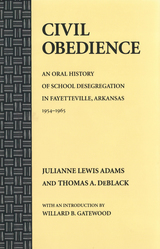 Civil Obedience: An Oral History of School Desegregation in Fayetteville, Arkansas, 1954–1965
Julianne Lewis Adams
University of Arkansas Press, 1994 Among the many changes that have occurred in our country in the last forty years, few have been as significant as those heralded by the Supreme Court's decision in the Brown vs. Board of Education case in 1954. By declaring racially segregated public schools unconstitutional, the court set in motion forces that resulted in the dismantling of the legal structure of Jim Crowism. The impact of the Brown decision was national in scope, but in no other region was its impact more far-reaching and traumatic than in the South. In Arkansas, as in other Southern states, racial segregation was not merely a well-stablished way of life, it was firmly imbedded in law.
While school desegregation generated much noise and some violence elsewhere in the South, the city of Fayetteville, Arkansas confronted the issue and resolved it with a good deal of dignity and grace, becoming the first Southern city to accommodate the Brown decision.
Through this fascinating collection of interviews with those who were involved in the desegregation process—students, teachers, administrators, civic leaders, and members of local groups—we learn of the determination of citizens to obey the law of the land and to see that freedom and equality took priority over their commitment to a school system that patently discriminated against one group of citizens.
In our continuing efforts to create a society in which all races and cultures can coexist, Civil Obedience is a story worthy of our full attention.
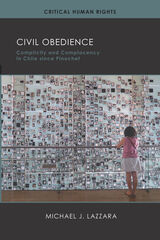 Civil Obedience: Complicity and Complacency in Chile since Pinochet
Michael J. Lazzara
University of Wisconsin Press, 2020 Since the fall of General Augusto Pinochet's dictatorship in 1990, Chilean society has shied away from the subject of civilian complicity, preferring to pursue convictions of military perpetrators. But the torture, murders, deportations, and disappearances of tens of thousands of people in Chile were not carried out by the military alone; they required a vast civilian network. Some citizens actively participated in the regime's massive violations of human rights for personal gain or out of a sense of patriotic duty. Others supported Pinochet's neoliberal economic program while turning a blind eye to the crimes of that era.
Michael J. Lazzara boldly argues that today's Chile is a product of both complicity and complacency. Combining historical analysis with deft literary, political, and cultural critique, he scrutinizes the post-Pinochet rationalizations made by politicians, artists, intellectuals, bystanders, former revolutionaries-turned-neoliberals, and common citizens. He looks beyond victims and perpetrators to unveil the ambiguous, ethically vexed realms of memory and experience that authoritarian regimes inevitably generate.
Civil Religion in Political Thought
Ronald Weed
Catholic University of America Press, 2010 The essays in this volume blend historical and philosophical reflection with concern for contemporary political problems. They show that the causes and motivations of civil religion are a permanent fixture of the human condition, though some of its manifestations and proximate causes have shifted in an age of multiculturalism, religious toleration, and secularization
Civil Rights and African Americans: A Documentary History
Albert Blaustein and Robert L. Zangrando
Northwestern University Press, 1991 This volume brings together for the first time all the important primary documents in the history of civil rights in the United States. Beginning in 1619, it contains original texts on slavery, abolition, the Civil War, Reconstruction, desegregation, the NAACP, and the black power movement. A thought-provoking preface provides an overview of the developments in civil rights law and public policy to the present day.
Many of the documents included were previously scattered in hard-to-find sources, not readily available to instructors and students. Civil Rights and African Americans is the first collection of all the seminal texts of the civil rights struggle, an invaluable scholarly reference and riveting reading for anyone interested in the history of racial conflict in the United States.
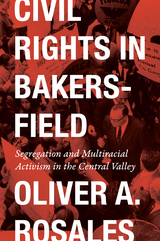 Civil Rights in Bakersfield: Segregation and Multiracial Activism in the Central Valley
Oliver A. Rosales
University of Texas Press, 2024 2024 Outstanding Book Award, National Association for Ethnic Studies A multiracial history of civil rights coalitions beyond the farm worker movement in twentieth-century Bakersfield, California. In Civil Rights in Bakersfield, Oliver Rosales uncovers the role of the multiracial west in shaping the course of US civil rights history. Focusing on Bakersfield, one of the few sizable cities within California’s Central Valley for much of the twentieth century in a region most commonly known as a bastion of political conservatism, oil, and industrial agriculture, Rosales documents how multiracial coalitions emerged to challenge histories of racial segregation and discrimination. He recounts how the region was home to both the historic farm worker movement, led by César Chávez, Dolores Huerta, and Larry Itliong, and also a robust multiracial civil rights movement beyond the fields. This multiracial push for civil rights reform included struggles for fair housing, school integration, public health, media representation, and greater political representation for Black and Brown communities. In expanding on this history of multiracial activism, Rosales further explores the challenges activists faced in community organizing and how the legacies of coalition building contribute to ongoing activist efforts in the Central Valley of today.
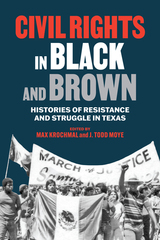 Civil Rights in Black and Brown: Histories of Resistance and Struggle in Texas
Edited by Max Krochmal and J. Todd Moye
University of Texas Press, 2021 2022 Best Book Award, Oral History Association
Hundreds of stories of activists at the front lines of the intersecting African American and Mexican American liberation struggle
Not one but two civil rights movements flourished in mid-twentieth-century Texas, and they did so in intimate conversation with one another. Far from the gaze of the national media, African American and Mexican American activists combated the twin caste systems of Jim Crow and Juan Crow. These insurgents worked chiefly within their own racial groups, yet they also looked to each other for guidance and, at times, came together in solidarity. The movements sought more than integration and access: they demanded power and justice. Civil Rights in Black and Brown draws on more than 500 oral history interviews newly collected across Texas, from the Panhandle to the Piney Woods and everywhere in between. The testimonies speak in detail to the structure of racism in small towns and huge metropolises—both the everyday grind of segregation and the haunting acts of racial violence that upheld Texas’s state-sanctioned systems of white supremacy. Through their memories of resistance and revolution, the activists reveal previously undocumented struggles for equity, as well as the links Black and Chicanx organizers forged in their efforts to achieve self-determination.
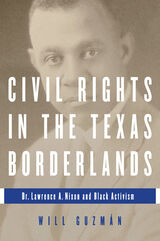 Civil Rights in the Texas Borderlands: Dr. Lawrence A. Nixon and Black Activism
Will Guzman
University of Illinois Press, 2016 In 1907, physician Lawrence A. Nixon fled the racial violence of central Texas to settle in the border town of El Paso. There he became a community and civil rights leader. His victories in two Supreme Court decisions paved the way for dismantling all-white political primaries across the South.
Will Guzmán delves into Nixon's lifelong struggle against Jim Crow. Linking Nixon's activism to his independence from the white economy, support from the NAACP, and the man's own indefatigable courage, Guzmán also sheds light on Nixon's presence in symbolic and literal borderlands--as an educated professional in a time when few went to college, as an African American who made waves when most feared violent reprisal, and as someone living on the mythical American frontier as well as an international boundary.
A powerful addition to the literature on African Americans in the Southwest, Civil Rights in the Texas Borderlands explores seldom-studied corners of the Black past and the civil rights movement.
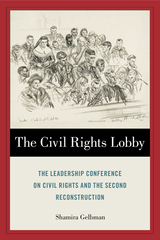 The Civil Rights Lobby: The Leadership Conference on Civil Rights and the Second Reconstruction
Shamira Gelbman
Temple University Press, 2021 As the lobbying arm of the civil rights movement, the Leadership Conference on Civil Rights (LCCR)—which has operated since the early 1950s—was instrumental in the historic legislative breakthroughs of the Second Reconstruction. The Civil Rights Lobby skillfully recounts the LCCR’s professional and grassroots lobbying that contributed to these signature civil rights policy achievements in the 1950s and ’60s. Shamira Gelbman explains how the diversity of this interest group coalition both hindered and enabled lobbyists to generate broad-based support for reforms that often seemed risky to legislators. They coordinated their efforts by identifying common ground among member organizations, developing coalitional positions on substantive and strategic questions, and exhorting organizations to mobilize professional and grassroots lobbying resources accordingly. The result was to “speak with one booming voice” to ultimately help secure the passage of the Civil Rights Act of 1964. The Civil Rights Lobby concludes by reprising key lessons from the LCCR’s organizational development and participation in civil rights policymaking. Gelbman suggests new directions for research on interest group coalitions and explores how the Leadership Conference’s experience sheds light on the politics of the Second Reconstruction.
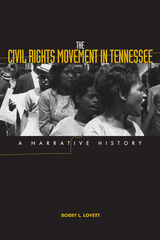 The Civil Rights Movement in Tennessee: A Narrative History
Bobby L. Lovett
University of Tennessee Press, 2005
From legal battles to sit-ins to freedom rides to marches, activists in the United States rose up against racial discrimination in the civil rights movement. While many books have focused on the national campaign and prominent leaders such as Dr. Martin Luther King and Malcolm X, this is the first book to examine the civil rights movement in the state of Tennessee.Bobby L. Lovett proposes that African Americans have always had a civil rights movement in Tennessee, even during slavery. He identifies three phases of the movement in the state—1864 to 1880, 1881 to 1934, and 1935 to the present—and focuses on the last period. Lovett explores early Jim Crow Tennessee, public school desegregation since Brown v. Board of Education in 1954, sit-in and public desegregation activities, politics and civil rights, and the desegregation of higher education. This well-researched book draws on special collections from libraries across the state, personal papers, manuscript collections, conversations, observations, books, scholarly articles, and newspapers. Lovett covers the entire state, but concentrates on the four major cities: Chattanooga, Knoxville, Memphis, and Nashville. There are short descriptions of local interest to bring the movement alive, as well as sketches of main players, federal judges, and more than three dozen court cases that have affected race and civil rights in Tennessee.African American and white leaders in the fight for equality in Tennessee are revealed, and Lovett relates the movement with African Americans’ pursuit of inclusion in society nationally. Tennesseans who engaged in the struggle included prominent African American figures such as civil rights attorney Avon Williams of Nashville and NAACP activist Maxine Smith of Memphis. This book fills a gap in the historical record of the civil rights movement and is an important addition to studies of the movement both in Tennessee and in the nation.Bobby L. Lovett is a professor of history at Tennessee State University. He is the author of The African-American History of Nashville, Tennessee, 1780–1930: Elites and Dilemmas and a contributor to The Southern Elite and Social Change: Essays in Honor of Willard B. Gatewood, Jr.
Civil Service Law
Oliver P. Field
University of Minnesota Press, 1939
Civil Service Law was first published in 1939. Minnesota Archive Editions uses digital technology to make long-unavailable books once again accessible, and are published unaltered from the original University of Minnesota Press editions.
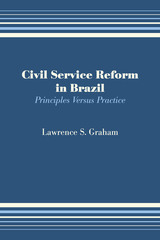 Civil Service Reform in Brazil: Principles Versus Practice
By Lawrence S. Graham
University of Texas Press, 1968 In the 1930s, during the authoritarian government of Getúlio Vargas, the Brazilian civil service reform movement began. Thirty-five years later, the actual administrative practices of the country did not adequately reflect the philosophy underlying this movement, a philosophy drawn from the reform experience and public administration theories of the United States and Western Europe. This book examines why these ideas, when transplanted to another cultural setting, did not take root and, further, why they unexpectedly proved to be most applicable in Brazil during periods of autocratic rule. These questions are highly relevant not only to Brazil, but equally to other developing countries struggling to create more effective national administrative systems. For this reason, and in order to evaluate the Brazilian reform experience within its total context (social, economic, and political), Lawrence S. Graham develops a broad conceptual framework. His focus is on the years between 1945 and 1964, a period which allowed a relatively free play of political forces but, ironically, produced a diminution in the success of the reform efforts when compared with the authoritarian governments which preceded and followed it. After a comparative consideration of the public administration theories behind the reform movement, Graham examines this period in terms of the political environment, the functions of political patronage, and the influences of a nascent national party. Finally, he juxtaposes the conditions and course of the Brazilian reform experience with those of the United States and Great Britain. Graham’s study of the Brazilian example, which does not pass judgment on the prevailing public personnel system, reveals the importance of understanding the total cultural context within which administrative principles are put into practice. Such an approach, wider than generally held in the field of public administration, may prove to be the most vital factor in the future of the civil service in Brazil and several other countries facing the same problems.
Civil Society and Dictatorship in Modern German History
Jürgen Kocka
Brandeis University Press, 2012 In this rich and thought-provoking work, Jürgen Kocka focuses his analytic lens on Germany’s long twentieth century, from the empire to the present. He begins by establishing the semantic problematic in the German term Bürgertum and presenting an analytical survey of German civil society over the past 120 years. He then offers a fascinating social history of the GDR, along with a comparative analysis of the East German dictatorship and that of the Third Reich. He further compares Germany’s “two dictatorships” in regard to historical memory, post-regime justice, and historiography before and after reunification. Kocka concludes with a wonderfully expansive view of historical interpretation and even argues for the place of trendiness and fashion in the profession.
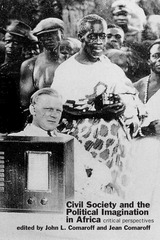 Civil Society and the Political Imagination in Africa: Critical Perspectives
Edited by John L. Comaroff and Jean Comaroff
University of Chicago Press, 1999 The essays in this important new collection explore the diverse, unexpected, and controversial ways in which the idea of civil society has recently entered into populist politics and public debate throughout Africa.
In a substantial introduction, anthropologists Jean and John Comaroff offer a critical theoretical analysis of the nature and deployment of the concept—and the current debates surrounding it. Building on this framework, the contributors investigate the "problem" of civil society across their regions of expertise, which cover the continent. Drawing creatively on one another's work, they examine the impact of colonial ideology, postcoloniality, and development practice on discourses of civility, the workings of everyday politics, the construction of new modes of selfhood, and the pursuit of moral community.
Incisive and original, the book shows how struggles over civil society in Africa reveal much about larger historical forces in the post-Cold War era. It also makes a strong case for the contribution of historical anthropology to contemporary discourses on the rise of a "new world order."
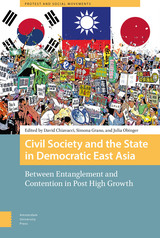 Civil Society and the State in Democratic East Asia: Between Entanglement and Contention in Post High Growth
David Chiavacci
Amsterdam University Press, 2020 Civil Society and the State in Democratic East Asia: Between Entanglement and Contention in Post High Growth focuses on the new and diversifying interactions between civil society and the state in contemporary East Asia by including cases of entanglement and contention in the three fully consolidated democracies in the area: Japan, South Korea and Taiwan. The contributions to this book argue that all three countries have reached a new era of post high growth and mature democracy, leading to new social anxieties and increasing normative diversity, which have direct repercussions on the relationship between the state and civil society. It introduces a comparative perspective in identifying and discussing similarities and differences in East Asia based on in-depth case studies in the fields of environmental issues, national identities as well as neoliberalism and social inclusion that go beyond the classic dichotomy of state vs ‘liberal’ civil society.
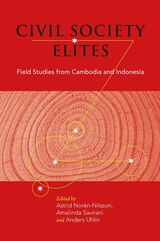 Civil Society Elites: Field Studies from Cambodia and Indonesia
Edited by Astrid Norén-Nilsson, Amalinda Savirani, and Anders Uhlin
National University of Singapore Press, 2023 This innovative volume is the first systematic study of civil society elites in Southeast Asia (and indeed anywhere in the world). Spanning two previously separate areas of research – civil society and elites – it sheds new light on power inequalities within and beyond civil society, identifies different types of elite formation and elite interaction within and beyond civil society, and traces interactions and integration with elite groups from party politics, the state, and the business sector. This tightly edited volume, produced by a research team ranging from senior scholars to promising younger academics, analyses how such processes are influenced by reliance on foreign funding and explores how they play out in two settings – where the political space for civil society is generally shrinking (Cambodia) and where it is relatively expanding (Indonesia). However, the volume offers more than a rethinking of civil society in Cambodia and Indonesia; it looks beyond. It thus challenges a view of civil society entities as relatively isolated from the state and from political and economic society, revealing power relations that link them. Suggesting a new direction for civil society research, the book will be of great interest to the many researchers working on civil society, elites and contemporary Southeast Asian politics as well as those engaged in other areas of society in Cambodia and Indonesia. Policymakers, donors and not least civil society activists themselves will find the volume highly relevant to their work.
Civil Society, Philanthropy, and the Fate of the Commons
Bruce R. Sievers
University Press of New England, 2010 Among the greatest challenges facing humanity in the twenty-first century is that of sustaining a healthy civil society, which depends upon managing the tension between individual and collective interests. Bruce R. Sievers explores this issue by investigating ways to balance the public and private sides of modern life in a manner that allows realization of the ideal of individual freedom and, at the same time, makes possible the effective pursuit of the common good. He traces the development of civil society from the seventeenth-century Dutch Republic and the eighteenth-century Scottish Enlightenment, analyzes its legacy for modern political life, and explores how historical trends in the formation of civil society and philanthropy aid or impede our achievement of public goods in the modern era.
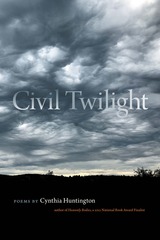 Civil Twilight
Cynthia Huntington, 2012 National Book Award Finalist
Southern Illinois University Press, 2024 New collection from National Book Award finalist
Civil twilight is the astronomical term for the minutes just before sunrise and just after sunset. If one took a snapshot, it would be impossible to tell whether the light was increasing or diminishing. The poems in Civil Twilight arise in this liminal space. With luminous precision, Cynthia Huntington examines the civil twilight we live in now, unsure of whether the darkness is closing in or whether the light is about to break.
Here the poet is both skeptic and seeker, for any hope worth discovering needs to withstand the facts at hand. Is everything getting worse, or are things about to improve? Or is this the way things have always been, both hopeful and terrifying, and it is our questions that need to change? In part one, the speaker strives for balance by maintaining light and warmth in a cold season. In part two, American scenes of construction and destruction are set beside moments from history: Rome, the British Empire, and American immigration. Part three enfolds questions of history and power within winter scenes and the artist’s imagination. In part four, the speaker looks back and admits answers remain elusive, yet points to the new ways of thinking and feeling about survival that have resulted from the work. And here, the half-light shifts. In a world teetering on the edge of collapse, Civil Twilight wrestles hard-won hope from disquiet, coming to rest in what is.
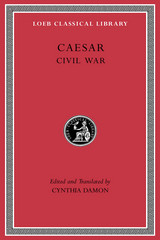 Civil War
Caesar
Harvard University Press, 2016 The struggle that ended the Roman Republic.
Caesar (C. Iulius, 102–44 BC), statesman and soldier, defied the dictator Sulla; served in the Mithridatic wars and in Spain; entered Roman politics as a “democrat” against the senatorial government; was the real leader of the coalition with Pompey and Crassus; conquered all Gaul for Rome; attacked Britain twice; was forced into civil war; became master of the Roman world; and achieved wide-reaching reforms until his murder. We have his books of commentarii (notes): eight on his wars in Gaul from 58–52 BC, including the two expeditions to Britain in 55–54, and three on the civil war of 49–48. They are records of his own campaigns (with occasional digressions) in vigorous, direct, clear, unemotional style and in the third person, the account of the civil war being somewhat more impassioned.
This edition of the Civil War replaces the earlier Loeb Classical Library edition by A. G. Peskett (1914) with new text, translation, introduction, and bibliography. In the Loeb Classical Library edition of Caesar, Volume I is his Gallic War; Volume III consists of Alexandrian War, African War, and Spanish War, commonly ascribed to Caesar by our manuscripts but of uncertain authorship.
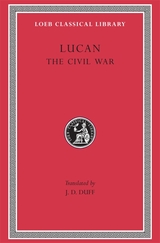 The Civil War
Lucan
Harvard University Press Epic history.
Lucan (M. Annaeus Lucanus, AD 39–65), son of wealthy M. Annaeus Mela and nephew of Seneca, was born at Corduba (Cordova) in Spain and was brought as a baby to Rome. In AD 60 at a festival in Emperor Nero’s honor Lucan praised him in a panegyric and was promoted to one or two minor offices. But having defeated Nero in a poetry contest he was interdicted from further recitals or publication, so that three books of his epic The Civil War were probably not issued in 61 when they were finished. By 65 he was composing the tenth book but then became involved in the unsuccessful plot of Piso against Nero and, aged only twenty-six, by order took his own life.
Quintilian called Lucan a poet “full of fire and energy and a master of brilliant phrases.” His epic stood next after Virgil’s in the estimation of antiquity. Julius Caesar looms as a sinister hero in his stormy chronicle in verse of the war between Caesar and the Republic’s forces under Pompey, and later under Cato in Africa—a chronicle of dramatic events carrying us from Caesar’s fateful crossing of the Rubicon, through the Battle of Pharsalus and death of Pompey, to Caesar victorious in Egypt. The poem is also called Pharsalia.
 The Civil War
Jeremy Black
St. Augustine's Press, 2025 The American Civil War may have been more consequential to American history (and its global supremacy) than its Revolutionary War and participation in all other world wars. The influence of this war is not just reduced to the victory of the north and its economic infrastructure, but the fact of Union success ushered in the notion of 'what it means to be American' that even the revolution could not instill.
European military historian Jeremy Black reorients readers to see what was extraordinary in the civil war of 'the American colonies' and why this was warfare unlike anything that could be properly understood on the world stage at that time. He also examines with expertise the role of foreign powers (or lack thereof).
Black's treatment might be the doom of civil war counterfactuals. Was the south destined to fail? Was it weaker motive, faulty strategy, or lack of European support? Was the north just lucky, or possessed of foresight and providential endowment? Black dispels romanticism and sentimentalist hindsight––the American Civil War is unparalleled in many respects, but it is not without clear lessons in warcraft, diplomacy, and cultural–economic impasse.
Furthermore, Black's Civil War is a new resource that teaches, reaffirms, and reminds readers of the intensity of the American past––in both error and idealistic impulse––that might continue to guide us to the best future and avoid the lose-lose circumstances of a civil war. Black's acumen for historical review in this case renders a kind of warning: May the leaders of men in the future come to a better way of self-realization than give way to the internal conflict that pits father against son, and sister against brother. But if he must engage, at least understand the distinction between war and politics.
Black's objective and concise account is a treasure for students and experts alike who need clarity and insight without too much of an investment. The take-away is an appreciation for the American spirit that civil strife petrified and an understanding of the tactical progression of this conflict and the context of combat of that era.
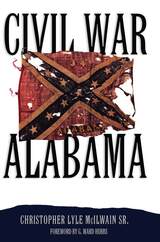 Civil War Alabama
Christopher Lyle McIlwain, Sr.
University of Alabama Press, 2016 Christopher McIlwain’s Civil War Alabama is a landmark book that sheds invigorating new light on the causes, the course, and the outcomes in Alabama of the nation’s greatest drama and trauma. Based on twenty years of exhaustive research that draws on a vast trove of primary sources such as letters, newspapers, and personal journals, Civil War Alabama presents compelling new explanations for how Alabama’s white citizens came to take up arms against the federal government.
A fledgling state at only forty years old, Alabama approached the 1860s with expanding populations of both whites and black slaves. They were locked together in a powerful yet fragile economic engine that produced and concentrated titanic wealth in the hands of a white elite. Perceiving themselves trapped between a mass of disenfranchised black slaves and the industrializing and increasingly abolitionist North, white Alabamians were led into secession and war by a charismatic cohort who claimed the imprimatur of biblical scripture, romanticized traditions of chivalry, and the military mantle of the American Revolution.
And yet, Alabama’s white citizens were not a monolith of one mind. McIlwain dispels the received wisdom of a white citizenry united behind a cadre of patriarchs and patriots. Providing a fresh and insightful synthesis of military events, economic factors such as inflation and shortages, politics and elections, the pivotal role of the legal profession, and the influence of the press, McIlwain’s Civil War Alabama illuminates the fissiparous state of white, antebellum Alabamians divided by class, geography, financial interests, and political loyalties.
Vital and compelling, Civil War Alabama will take its place among the definitive books about Alabama’s doomed Confederate experiment and legacy. Although he rigorously dismantles idealized myths about the South’s “Lost Cause,” McIlwain restores for contemporary readers the fervent struggles between Alabamians over their response to the epic crisis of their times.
Civil War and State Formation: The Political Economy of War and Peace in Liberia
Felix Gerdes
Campus Verlag, 2013 The scene of two devastating civil wars since 1989, Liberia had widely been considered a failed state until the international professional Ellen Johnson Sirleaf was democratically elected president in 2005. This book investigates the political economy of civil war and democratic peace, arguing that the civil wars did not represent state decay, but exhibited dynamics characteristic of state formation. In the analysis of post-war developments, which emphasizes the intertwining of corruption and democracy under the new regime, Felix Gerdes details both political progress and persistent structural deficits of the polity.
 The Civil War and the Limits of Destruction
Mark E. Neely Jr.
Harvard University Press, 2007 The Civil War is often portrayed as the most brutal war in America's history, a premonition of twentieth-century slaughter and carnage. In challenging this view, Mark E. Neely, Jr., considers the war's destructiveness in a comparative context, revealing the sense of limits that guided the conduct of American soldiers and statesmen.
Neely begins by contrasting Civil War behavior with U.S. soldiers' experiences in the Mexican War of 1846. He examines Price's Raid in Missouri for evidence of deterioration in the restraints imposed by the customs of war; and in a brilliant analysis of Philip Sheridan's Shenandoah Valley campaign, he shows that the actions of U.S. cavalrymen were selective and controlled. The Mexican war of the 1860s between French imperial forces and republicans provided a new yardstick for brutality: Emperor Maximilian's infamous Black Decree threatened captured enemies with execution. Civil War battles, however, paled in comparison with the unrestrained warfare waged against the Plains Indians. Racial beliefs, Neely shows, were a major determinant of wartime behavior.
Destructive rhetoric was rampant in the congressional debate over the resolution to avenge the treatment of Union captives at Andersonville by deliberately starving and freezing to death Confederate prisoners of war. Nevertheless, to gauge the events of the war by the ferocity of its language of political hatred is a mistake, Neely argues. The modern overemphasis on violence in Civil War literature has led many scholars to go too far in drawing close analogies with the twentieth century's "total war" and the grim guerrilla struggles of Vietnam.
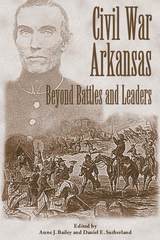 Civil War Arkansas: Beyond Battles and Leaders
Anne Bailey
University of Arkansas Press, 2000 This collection of essays represents the best recent history written on Civil War activity in Arkansas. It illuminates the complexity of such issues as guerrilla warfare, Union army policies, and the struggles hetween white and black civilians and soldiers, and also shows that the war years were a time of great change and personal conflict for the citizens of the state, despite the absence of "great" battles or armies. All the essays, which have been previously published in scholarly journals, have been revised to reflect recent scholarship in the field. Each selection explores a military or social dimension of the war that has been largely ignored or which is unique to the war in Arkansas—gristmill destruction, military farm colonies, nitre mining operations, mountain clan skirmishes, federal plantation experiments, and racial atrocities and reprisals. Together, the essays provoke thought on the character and cost of the war away from the great battlefields and suggest the pervasive change wrought by its destructiveness. In the cogent introduction Daniel E. Sutherland and Anne J. Bailey set the historiographic record of the Civil War in Arkansas, tracing a line from the first writings through later publications to our current understanding. As a volume in The Civil War in the West series, Civil War Arkansas elucidates little-known but significant aspects of the war, encouraging new perspectives on them and focusing on the less studied western theater. As such, it will inform and challenge both students and teachers of the American Civil War.
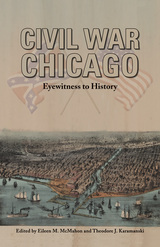 Civil War Chicago: Eyewitness to History
Theodore J. Karamanski
Ohio University Press, 2014 The American Civil War was a crucial event in the development of Chicago as the metropolis of the heartland. Not only did Chicagoans play an important role in the politics of the conflict, encouraging emancipation and promoting a “hard war” policy against Southern civilians, but they supported the troops materially through production of military supplies and foodstuffs as well as morally and spiritually through patriotic publications and songs. The Civil War transformed Chicago from a mere commercial center to an industrial power as well as the nation’s railroad hub and busiest port. The war also divided Chicago, however, between Lincoln supporters and Copperheads, whites and blacks, workers and owners, natives and newcomers. The city played a key role in elevating Abraham Lincoln to the Republican presidential nomination in 1860, yet only four years later a Chicago politician’ s influence was key in declaring the war a failure and promoting a platform of peace with the Confederacy. Using seldom seen or newly uncovered sources, this book tells the story of the Civil War through the eyes of those who lived that history. Photographs throughout the book effectively convey the geography of events in this pivotal period of Chicago’s history, and the editors have provided a useful driving guide to Civil War sites in and around the city.
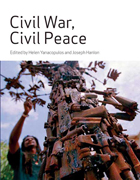 Civil War, Civil Peace
Helen Yanacopulos
Ohio University Press, 2006 More than two hundred wars have been fought in the past half century. Nearly all have been civil wars, and at the beginning of the twenty-first century, more than thirty civil wars were being fought. The “rules” of interstate war do not apply; each atrocity provokes retribution, and civil war takes on a brutal dynamic of its own. Civil War, Civil Peace challenges common but simplistic explanations of war, including greed, gender, and long-standing religious or ethnic hatreds, which ignore that these groups have lived together in peace for centuries.
When a cease-fire is arranged, aid workers, military personnel, diplomats, and others pour in from the United States, Europe, and international agencies. Outside help is essential after a war, but too often, well-intentioned interveners do more harm than good. A half of civil wars have resumed after failed peace agreements.
Each war is different, and there can be no intervention handbook or best practices guide. Aimed at practitioners and policy makers, and essential reading for students of war, humanitarian intervention, peace building, and development, Civil War, Civil Peace provides a comprehensive examination of how interventions can be improved through a better understanding of the roots of war and of the grievances and interests that fueled the war.
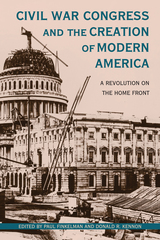 Civil War Congress and the Creation of Modern America: A Revolution on the Home Front
Paul Finkelman
Ohio University Press, 2018 Most literature on the Civil War focuses on soldiers, battles, and politics. But for every soldier in the United States Army, there were nine civilians at home. The war affected those left on the home front in many ways. Westward expansion and land ownership increased. The draft disrupted families while a shortage of male workers created opportunities for women that were previously unknown. The war also enlarged the national government in ways unimagined before 1861. The Homestead Act, the Land Grant College Act, civil rights legislation, the use of paper currency, and creation of the Internal Revenue Service to collect taxes to pay for the war all illustrate how the war fundamentally, and permanently, changed the nation. The essays in this book, drawn from a wide range of historical expertise and approaching the topic from a variety of angles, explore the changes in life at home that led to a revolution in American society and set the stage for the making of modern America. Contributors: Jean H. Baker, Jenny Bourne, Paul Finkelman, Guy Gugliotta, Daniel W. Stowell, Peter Wallenstein, Jennifer L. Weber.
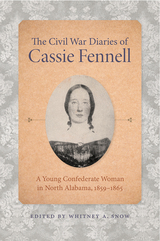 The Civil War Diaries of Cassie Fennell: A Young Confederate Woman in North Alabama, 1859–1865
Whitney A. Snow
University of Tennessee Press, 2020 Born near Guntersville, Alabama, Catherine (Cassie) Fennell was nineteen when the Civil War began. Starting with her time at a female academy in Washington, DC, the diaries continue through the war’s end and discuss civilian experiences in Alabama and the Tennessee Valley. Fennell believed that by keeping a diary she made a small contribution to the war effort and history itself.
Fennell was fairly well off and highly educated, moving easily in very elite social circles. Most of her relatives were staunch Confederates, and the war took its toll, with multiple members of her family killed or captured. As Fennell recounts the consequences of war—the downward spiral of the family fortune, the withering of hope at news from the battlefront, and the general uncertainty of civilian life in the South—her diaries constitute one of the few contemporaneous records of north Alabama, including the shelling and burning of Guntersville, which has been poorly documented in the historiography of the Civil War. While the first diary is written as a private reflection, the war journals are well researched and rely on extensive familiarity with local newspapers and seem like they are intended for the eyes of later generations.
Ultimately, these diaries amount to a social history of the war years, in a specific region where scholars have recovered relatively few firsthand accounts, and editor Whitney Snow’s compilation adds to the now growing genre of women’s Civil War diaries. Insightful and engrossing, The Civil War Diaries of Cassie Fennell is a compelling portrait of a privileged young woman who suffered devastating losses for her ardent support of a Confederate nation.
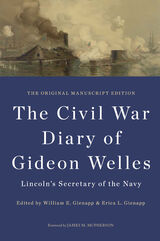 The Civil War Diary of Gideon Welles, Lincoln's Secretary of the Navy: The Original Manuscript Edition
Gideon Welles, Edited by William E. Gienapp and Erica L. Gienapp; Foreword by James M. McPherson
University of Illinois Press, 2014 Gideon Welles’s 1861 appointment as secretary of the navy placed him at the hub of Union planning for the Civil War and in the midst of the powerful personalities vying for influence in Abraham Lincoln’s cabinet. Although Welles initially knew little of naval matters, he rebuilt a service depleted by Confederate defections, planned actions that gave the Union badly needed victories in the war’s early days, and oversaw a blockade that weakened the South’s economy. Perhaps the hardest-working member of the cabinet, Welles still found time to keep a detailed diary that has become one of the key documents for understanding the inner workings of the Lincoln administration. In this new edition, William E. and Erica L. Gienapp have restored Welles’s original observations, gleaned from the manuscript diaries at the Library of Congress and freed from his many later revisions, so that the reader can experience what he wrote in the moment. With his vitriolic pen, Welles captures the bitter disputes over strategy and war aims, lacerates colleagues from Secretary of State William H. Seward to General-in-Chief Henry Halleck, and condemns the actions of the self-serving southern elite he sees as responsible for the war. He just as easily waxes eloquent about the Navy's wartime achievements, extols the virtues of Lincoln, and drops in a tidbit of Washington gossip. Carefully edited and extensively annotated, this edition contains a wealth of supplementary material. The appendixes include short biographies of the members of Lincoln’s cabinet, the retrospective Welles wrote after leaving office covering the period missing from the diary proper, and important letters regarding naval matters and international law.
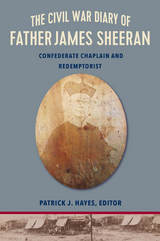 The Civil War Diary of Rev. James Sheeran, C.Ss.R.
Patrick J. Hayes
Catholic University of America Press, 2017 This exciting Civil War diary of a Redemptorist priest, Rev. James Sheeran, C.Ss.R., who was chaplain to the 14th Louisiana Regiment of the Confederacy, is a national treasure. Irish-born Sheeran (1817-1881) was one of only a few dozen Catholic chaplains commissioned for the Confederacy and one of only two who kept a journal. Highlighting his exploits from August 1,1862 through April 24, 1865, the journal tells of all the major events of his life in abundant detail: on the battle field, in the hospitals, and among Catholics and Protestants whom he encountered in local towns, on the trains, and in the course of his ministrations. His ideological sympathies clearly rest with the Confederacy. The tone is forthright, even haughty, but captures in sure and steady fashion, both the personality of the man and the events to which he was a witness, especially the major battles. The journal is arguably the most unique narrative of the war written by a chaplain of any denomination and certainly is the most extensive.
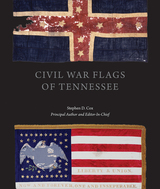 Civil War Flags of Tennessee
Stephen Douglas Cox
University of Tennessee Press, 2020 Civil War Flags of Tennessee provides information on all known Confederate and Union flags of the state and showcases the Civil War flag collection of the Tennessee State Museum. This volume is organized into three parts. Part 1 includes interpretive essays by scholars such as Greg Biggs, Robert B. Bradley, Howard Michael Madaus, and Fonda Ghiardi Thomsen that address how flags were used in the Civil War, their general history, their makers, and preservation issues, among other themes. Part 2 is a catalogue of Tennessee Confederate flags. Part 3 is a catalogue of Tennessee Union flags. The catalogues present a collection of some 200 identified, extant Civil War flags and another 300 flags that are known through secondary and archival sources, all of which are exhaustively documented. Appendices follow the two catalogue sections and include detailed information on several Confederate and Union flags associated with the states of Mississippi, North Carolina, and Indiana that are also contained in the Tennessee State Museum collection.
Complete with nearly 300 color illustrations and meticulous notes on textiles and preservation efforts, this volume is much more than an encyclopedic log of Tennessee-related Civil War flags. Stephen Cox and his team also weave the history behind the flags throughout the catalogues, including the stories of the women who stitched them, the regiments that bore them, and the soldiers and bearers who served under them and carried them. Civil War Flags of Tennessee is an eloquent hybrid between guidebook and chronicle, and the scholar, the Civil War enthusiast, and the general reader will all enjoy what can be found in its pages.
Unprecedented in its variety and depth, Cox’s work fills an important historiographical void within the greater context of the American Civil War. This text demonstrates the importance of Tennessee state heritage and the value of public history, reminding readers that each generation has the honor and responsibility of learning from and preserving the history that has shaped us all—and in doing so, honoring the lives of the soldiers and civilians who sacrificed and persevered.
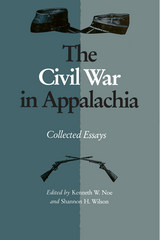 The Civil War in Appalachia: Collected Essays
Kenneth W. Noe
University of Tennessee Press, 2003 During the Battle of Perryville, fought in Kentucky in October 1862, participants experienced an unusual phenomenon known as an “acoustic shadow”: this peculiar combination of wind and terrain muffled the sounds of the fighting in such a manner that nearby soldiers were unaware that the battle was even taking place. As the editors of this pioneering collection of essays observe, a figurative acoustic shadow has long fallen on the study of the Civil War in Appalachia. Regional stereotypes, cursory generalizations, and a neglect of geographic context have too often replaced detailed analysis and innovative interpretation.
Recent historiography has begun to present a fuller view of the war as it unfolded in the mountain counties of Alabama, Georgia, Kentucky, Maryland, the Carolinas, Tennessee, Virginia, and West Virginia. The goals of this volume, the editors state, are “to provide a useful introduction to the social history of Appalachia’s Civil War, illustrating both the strengths and weaknesses of current historiography; to sum up where we have been and suggest where we need to go; and to point out the need to integrate Appalachian scholarship with studies of the Civil War and vice versa.” Among the topics covered are the experiences of blacks in Appalachia, the war as it affected women, the breakdown of community, changing gender roles, disaffection and desertion, guerrilla warfare, perceptions of mountain life, and the early stirrings of industrialization. These essays demonstrate the rich variety of Appalachian sentiments and attitudes toward the war, dismantling familiar myths such as the view of Appalachia as a “unionist monolith.”
Following the conflict from the secession crisis to the postwar period, these essays, taken together, provide what the editors call “the closest thing historians have to a comprehensive history of the Southern Mountains at war.”
 The Civil War in Books: AN ANALYTICAL BIBLIOGRAPHY
David J. Eicher
University of Illinois Press, 1997 With the assistance of several scholars, including James M. McPherson and Gary Gallagher, and a long-time specialist in Civil War books, Ralph Newman, David Eicher has selected for inclusion in The Civil War in Books the 1,100 most important books on the war. These are organized into categories as wide-ranging as "Battles and Campaigns," "Biographies, Memoirs, and Letters," "Unit Histories," and "General Works." The last of these includes volumes on black Americans and the war, battlefields, fiction, pictorial works, politics, prisons, railroads, and a host of other topics. Annotations are included for all entries in the work, which is presented in an oversized 8 1/2 x 11 inch volume in two-column format. Appendixes list "prolific" Civil War publishers and other Civil War bibliographies, and the works included in Eicher's mammoth undertaking are indexed by author or editor and by title.
Gary Gallagher's foreword traces the development of Civil War bibliographies and declares that Eicher's annotation exceeds that of any previous comprehensive volume. The Civil War in Books, Gallagher believes, is "precisely the type of guide" that has been needed. The first full-scale, fully-annotated bibliography on the Civil War to appear in more than thirty years, Eicher's The Civil War in Books is a remarkable compendium of the best reading available about the worst conflict ever to strike the United States. The bibliography, the most valuable reference book on the subject since The Civil War Day by Day, will be essential for college and university libraries, dealers in rare and secondhand books, and Civil War buffs.
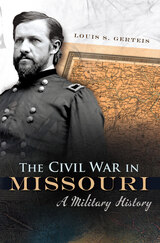 The Civil War in Missouri: A Military History
Louis S. Gerteis
University of Missouri Press, 2012 Guerrilla warfare, border fights, and unorganized skirmishes are all too often the only battles associated with Missouri during the Civil War. Combined with the state’s distance from both sides’ capitals, this misguided impression paints Missouri as an insignificant player in the nation’s struggle to define itself. Such notions, however, are far from an accurate picture of the Midwest state’s contributions to the war’s outcome. Though traditionally cast in a peripheral role, the conventional warfare of Missouri was integral in the Civil War’s development and ultimate conclusion. The strategic battles fought by organized armies are often lost amidst the stories of guerrilla tactics and bloody combat, but in The Civil War in Missouri, Louis S. Gerteis explores the state’s conventional warfare and its effects on the unfolding of national history.
Both the Union and the Confederacy had a vested interest in Missouri throughout the war. The state offered control of both the lower Mississippi valley and the Missouri River, strategic areas that could greatly factor into either side’s success or failure. Control of St. Louis and mid-Missouri were vital for controlling the West, and rail lines leading across the state offered an important connection between eastern states and the communities out west. The Confederacy sought to maintain the Ozark Mountains as a northern border, which allowed concentrations of rebel troops to build in the Mississippi valley. With such valuable stock at risk, Lincoln registered the importance of keeping rebel troops out of Missouri, and so began the conventional battles investigated by Gerteis.
The first book-length examination of its kind, The Civil War in Missouri: A Military History dares to challenge the prevailing opinion that Missouri battles made only minor contributions to the war. Gerteis specifically focuses not only on the principal conventional battles in the state but also on the effects these battles had on both sides’ national aspirations. This work broadens the scope of traditional Civil War studies to include the losses and wins of Missouri, in turn creating a more accurate and encompassing narrative of the nation’s history.
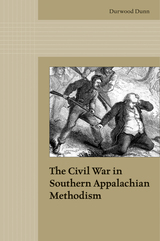 The Civil War in Southern Appalachian Methodism
Durwood Dunn
University of Tennessee Press, 2014 The Civil War in Southern Appalachian Methodism addresses a much-neglected topic in both Appalachian and Civil War history—the role of organized religion in the sectional strife and the war itself. Meticulously researched, well written, and full of fresh facts, this new book brings an original perspective to the study of the conflict and the region.
In many important respects, the actual Civil War that began in 1861 unveiled an internal civil war within the Holston Conference of the Methodist Episcopal Church, South—comprising churches in southwestern Virginia, eastern Tennessee, western North Carolina, and a small portion of northern Georgia—that had been waged surreptitiously for the previous five decades. This work examines the split within the Methodist Church that occurred with mounting tensions over the slavery question and the rise of the Confederacy. Specifically, it looks at how the church was changing from its early roots as a reform movement grounded in a strong local pastoral ministry to a church with a more intellectual, professionalized clergy that often identified with Southern secessionists.
The author has mined an exhaustive trove of primary sources, especially the extensive, yet often-overlooked minutes from frequent local and regional Methodist gatherings. He has also explored East Tennessee newspapers and other published works on the topic. The author’s deep research into obscure church records and other resources results not only in a surprising interpretation of the division within the Methodist Church but also new insights into the roles of African Americans, women, and especially lay people and local clergy in the decades prior to the war and through its aftermath. In addition, Dunn presents important information about what the inner Civil War was like in East Tennessee, an area deeply divided between Union and Confederate sympathizers.
Students and scholars of religious history, southern history, and Appalachian studies will be enlightened by this volume and its bold new way of looking at the history of the Methodist Church and this part of the nation.
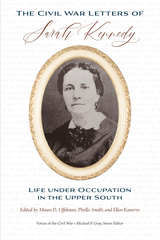 The Civil War Letters of Sarah Kennedy: Life under Occupation in the Upper South
Minoa Uffelman
University of Tennessee Press, 2023 At the outbreak of the Civil War, Sarah Kennedy watched as her husband, D.N., left for Mississippi, leaving her alone to care for their six children and control their slaves in a large home in downtown Clarksville, Tennessee. D. N. Kennedy left to aid the Confederate Treasury Department. He had steadfastly supported secession and helped recruit local boys for the Confederate army. The Civil War Letters of Sarah Kennedy: Life under Occupation in the Upper South showcases the letters Sarah wrote to her husband during their time apart, offering readers an inside look at life on the home front during the Civil War through the eyes of a slave-owning, town-dwelling wife and mother.
Featuring fifty-two of Sarah Kennedy’s letters to her husband from August 16, 1862, to February 20, 1865, this important collection chronicles Sarah Kennedy’s personal struggles during the Civil War years, from periods of illness to lack of consistent contact with her husband and everything in between. Her love and devotion to her family is apparent in each letter, contrasting deeply with her resentment and harsh treatment toward her enslaved people as Emancipation swept through Clarksville. A useful volume to Civil War historians and women’s history scholars alike, The Civil War Letters of Sarah Kennedy pulls back the curtain on upper-middle-class family life and social relations in a mid-sized Middle Tennessee town during the Civil War and reveals the slow demise of slavery during the Union occupation.
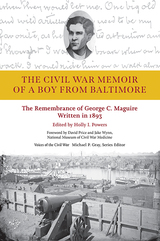 The Civil War Memoir of a Boy from Baltimore: The Remembrance of George C. Maguire, Written in 1893
Holly I. Powers
University of Tennessee Press, 2021 Fourteen-year-old George Maguire was eager to serve the Union when his home state, Maryland, began raising regiments for the coming conflict. Too young to join, he became a “mascot” for the Fifth Maryland Infantry Regiment, organized in September 1861. Although he never formally enlisted or carried a weapon, Maguire recounts several pivotal events in the war, including the sea battle of the Monitor vs. Merrimac, Peninsula Campaign action, and the Battle of Antietam.
During middle age, Maguire recorded his memoir—one of the few from a Maryland unit—providing a distinctive blend of the adventures of a teenage boy with the mature reflection of a man. His account of the Peninsula Campaign captures the success of the mobilization of forces and confirms the existing historical record, as well as illuminating the social structure of camp life. Maguire’s duties evolved over time, as he worked alongside army surgeons and assisted his brother-in-law (a “rabid abolitionist” and provost marshal of the regiment). This experience qualified him to work at the newly constructed Thomas Hicks United States General Hospital once he left the regiment in 1863; his memoir describes the staffing hierarchy and the operating procedures implemented by the Army Medical Corps at the end of the war, illuminated with the author’s own sketches of the facility.
From the Pratt Street riot in Baltimore to a chance encounter with Red Cross founder Clara Barton to a firsthand view of Hicks Hospital, this sweeping yet brief memoir provides a unique opportunity to examine the experiences of a child during the war and to explore the nuances of memory. Beyond simply retelling the events as they happened, Maguire’s memoir is woven with a sense of remorse and resolve, loss and fear, and the pure wonderment of a teenage boy accompanying one of the largest assembled armies of its day.
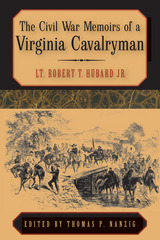 The Civil War Memoirs of a Virginia Cavalryman
Lt. Robert T. Hubard Jr., Edited by Thomas P. Nanzig
University of Alabama Press, 2007 A witness who brings remarkable life and color to the Civil War in the East
Robert Hubard was an enlisted man and officer of the 3rd Virginia Cavalry in the Army of Northern Virginia (CSA) from 1861 through 1865. He wrote his memoir during an extended convalescence spent at his father’s Virginia plantation after being wounded at the battle of Five Forks on April 1, 1865. Hubard served under such Confederate luminaries as Jeb Stuart, Fitz Lee, Wade Hampton, and Thomas L. Rosser. He and his unit fought at the battles of Antietam, on the Chambersburg Raid, in the Shenandoah Valley, at Fredericksburg, Kelly’s Ford, Chancellorsville, Gettysburg, Bristoe Station, and down into Virginia from the Wilderness to nearly the end of the war at Five Forks.
Hubard was like many of his class and station a son of privilege and may have felt that his service was an act of noblesse oblige. Unlike many of his contemporaries, however, he was a keen observer and a writer of unusual grace, clarity, humor, and intelligence. The editor has fleshed out his memoir by judicious use of Hubard’s own wartime letters, which not only fill in gaps but permit the reader to see developments in the writer’s thinking after the passage of time. Because he was a participant in events of high drama and endured the quotidian life of a soldier, Hubard’s memoir should be of value to both scholars and avocational readers.
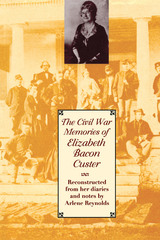 The Civil War Memories of Elizabeth Bacon Custer: Reconstructed From Her Diaries and Notes
By Elizabeth Bacon Custer
University of Texas Press, 1994 In her first year of marriage (1864-1865) to General George Armstrong Custer, Libbie Custer witnessed the Civil War firsthand. Her experiences of danger, hardship, and excitement made ideal material for a book, one that she worked on for years in later life but ultimately never published. In this volume, Arlene Reynolds has produced a readable narrative of Libbie Custer's life during the war years by chronologically reconstructing Libbie's original, unpublished notes and diaries found in the archives of the Little Big Horn Battlefield National Monument. In these reminiscences, Libbie Custer adds striking, eloquent details to the Civil War story as she describes her life both in camp and in Washington. Her stories of incidents such as fording a swollen river sidesaddle on horseback, dancing at the Inaugural Ball near President Lincoln, and watching the massive review of the Army of the Potomac after the surrender have the engrossing quality of a well-written novel. For general readers and students of women's history, this book tells a fascinating story of a sheltered girl's maturation into a courageous woman in the crucible of war. And for both devotees and detractors of her husband, it offers an intimate glimpse into his youth, West Point years, and early military service.
|
|

